By Eli Solomon
First uploaded 7 May 2023
Last updated 1 June 2023
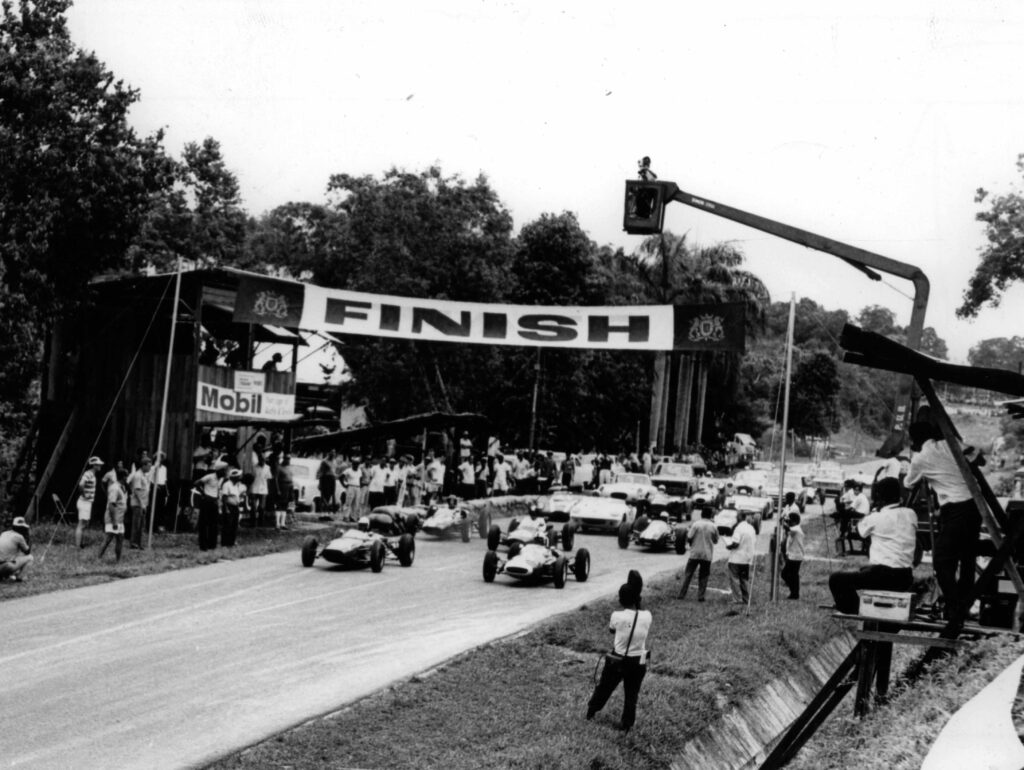
An exciting start to the 1966 Singapore Grand Prix and an unexpected set of results with three Lotus’ finishing in the top ten, including a win for Lee Han Seng (Lotus 22, front row right) and third for Tony Goodwin (Lotus 20B). There’s even an Elan (No.11 of Chong Boon Seng) on the third row.
On 1 November 1952, there appeared an advertisement in Motor Sport magazine. It was for the Lotus Mk VI, and from that date, we can mark seventy-one years of Lotus as a company, and not just the name given to a few specials. Seventy-one years on and Lotus will once more be a featured marque at this year’s Goodwood Revival (which is stated to be the 75th anniversary of the marque – “with a special on-track celebration paying homage to ‘The Chapman years’ (1948-1982).”
THE BEGINNINGS OF LOTUS
The background to that first advertisement, according to my dearly departed friend and Editor-at-Large at Rewind Magazine, Dr Mike Lawrence, is this.
“Antony Colin Bruce Chapman was born on 19 May 1928. His father, Stan, owned a successful pub in Hornsey, North London. Stan did more than serve pints, he set up a catering business; he put himself around…Colin was his only child and he was indulged. Every schoolboy in Britain lusted after a Claude Butler bicycle. Colin had one and he was a daredevil, so would go down a steep hill with his hands off the handlebars and his feet off the pedals. Inevitably, he wrecked his bike, so his Dad bought him another.
As though dodging the Luftwaffe was not enough to make life exciting, Colin found a kindred spirit in another local lad, John Teychenne. They were the lads who showed off on the high diving board at the local lido and John would play a significant role in the Lotus story.
Colin was very bright, with a particular gift for mathematics. He won a scholarship to the Stationers’ Company School in North London, a prestigious establishment founded by one of the City of London’s ancient guilds. If he set his mind to something, he succeeded…”
To cut a long story, in December 1947 came a bombshell. Petrol in Britain had been rationed and the ration allowed a motorist about 30 miles a week. Essential services, such as doctors, were allowed more. There was, of course, a black market. Then the government withdrew the fuel ration altogether for six months. Chapman’s market for second hand cars disappeared overnight. He sold his stock for what he could get for it and was left with an Austin Seven, which nobody would buy.
Chapman decided to convert the Austin into a dual-purpose road car and mud plugger because, he reasoned, the withdrawal of the petrol ration would not be permanent. In retrospect, it became the first Lotus, but in the day, it was an Austin Special. It was a neat little car which broke absolutely no new ground but which drew attention because everything had been thought through and well made. So there you have it, the first attributed Lotus, an Austin Seven Special, built in 1948.
Which brings us back to Dr Lawrence’s Mk VI that was built in 1952. His story on Lotus (Zero To Sixty With Lotus), was accompanied by an article on the history of Lotus racing cars in Asia. The pair featured in Rewind Magazine 012 (October 2012). Time I put parts of Dr Lawrence’s article and a revision of my Lotus piece on the Rewind-Media blog space. It’s been long overdue but somewhat timely, given the 75th anniversary of that first Austin Special built by Colin Chapman.
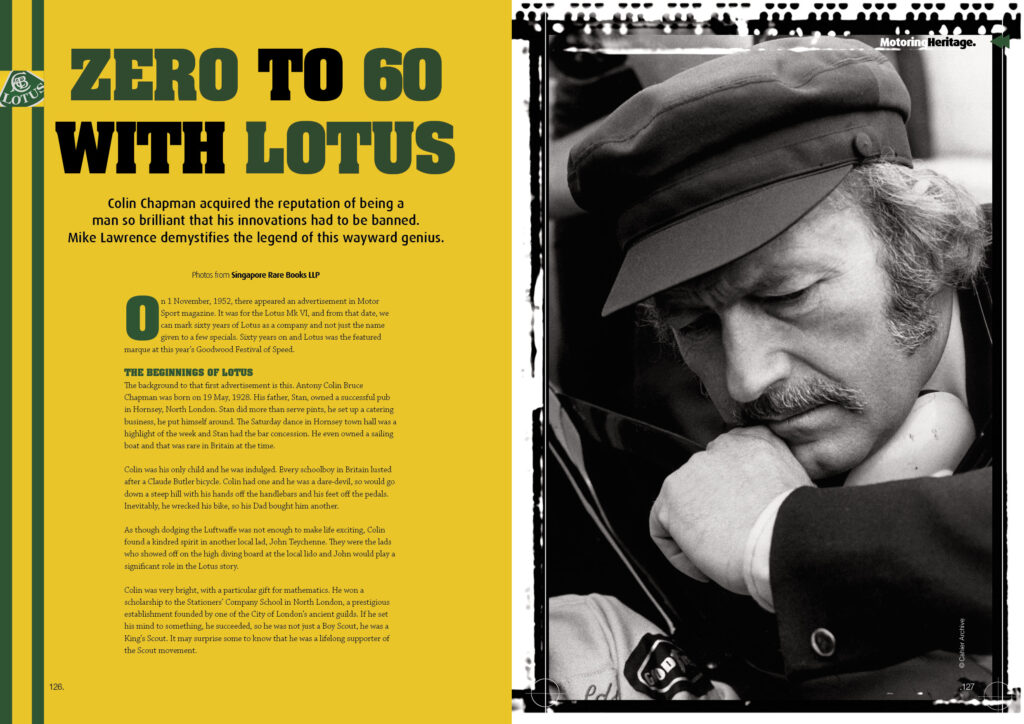
Opening spread of Dr Mike Lawrence’s Lotus history which appeared in Rewind Magazine Issue 012, October 2012.
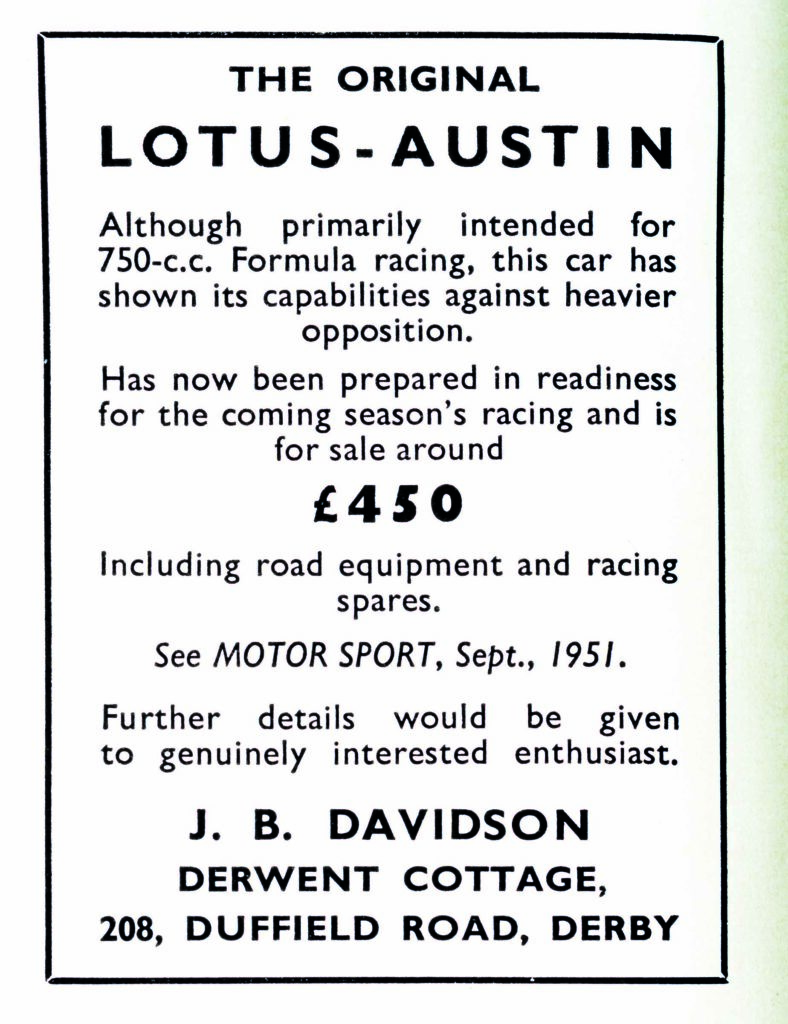
The Austin Seven Special, built by Colin Chapman.
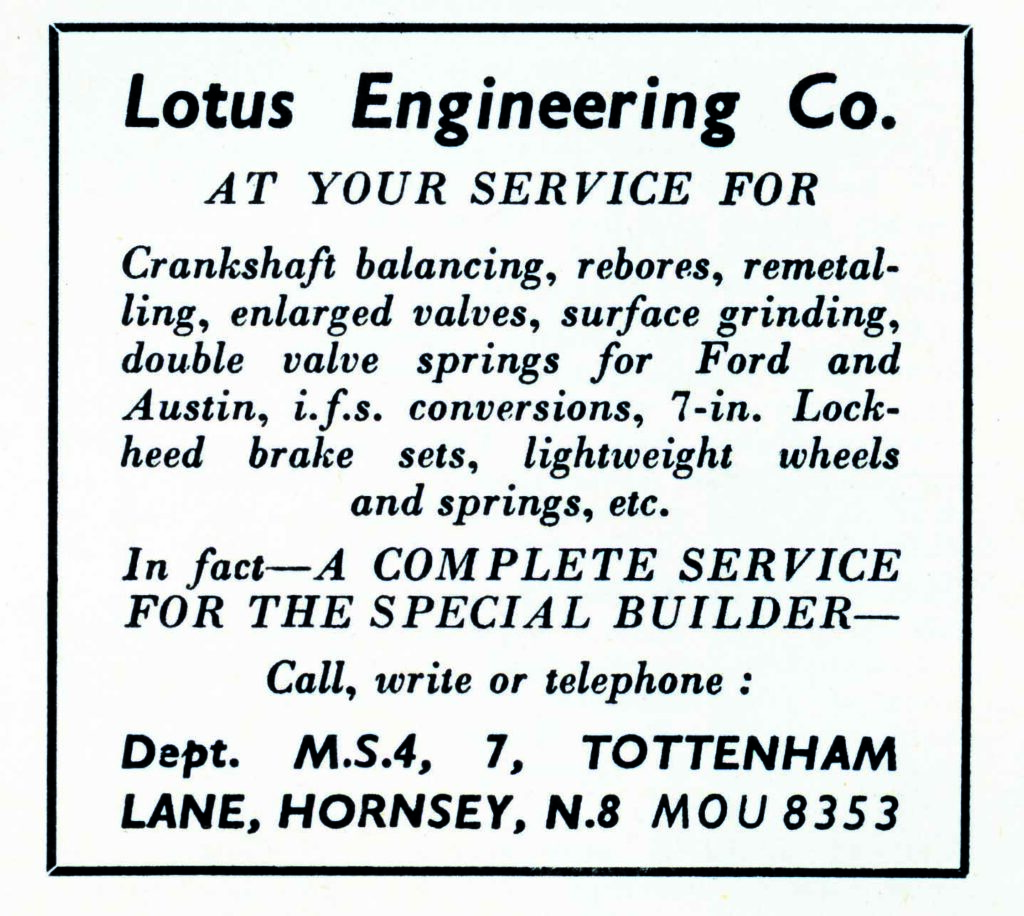
The first Lotus advert to appear in print – Motor Sport Magazine, November 1952
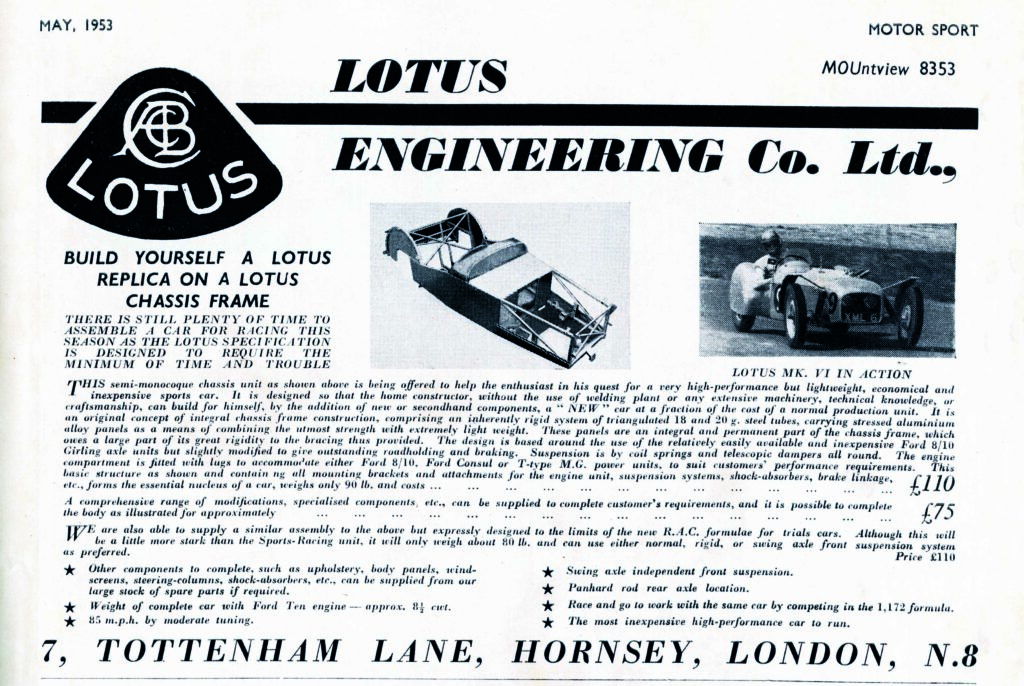
May 1953 advert in Motor Sport Magazine.
As introductions go, this one is long. But it establishes two very useful dates – the arrival of the first Chapman-built Austin Special, and the first advertisement for a Lotus car. Now let’s look at Lotus and its racing cars in Asia (ex-Japan, ex-India/Sri Lanka). This Asian content supplements the important material posted on social media by the local racing experts in Singapore.
LOTUS IN THE TROPICS
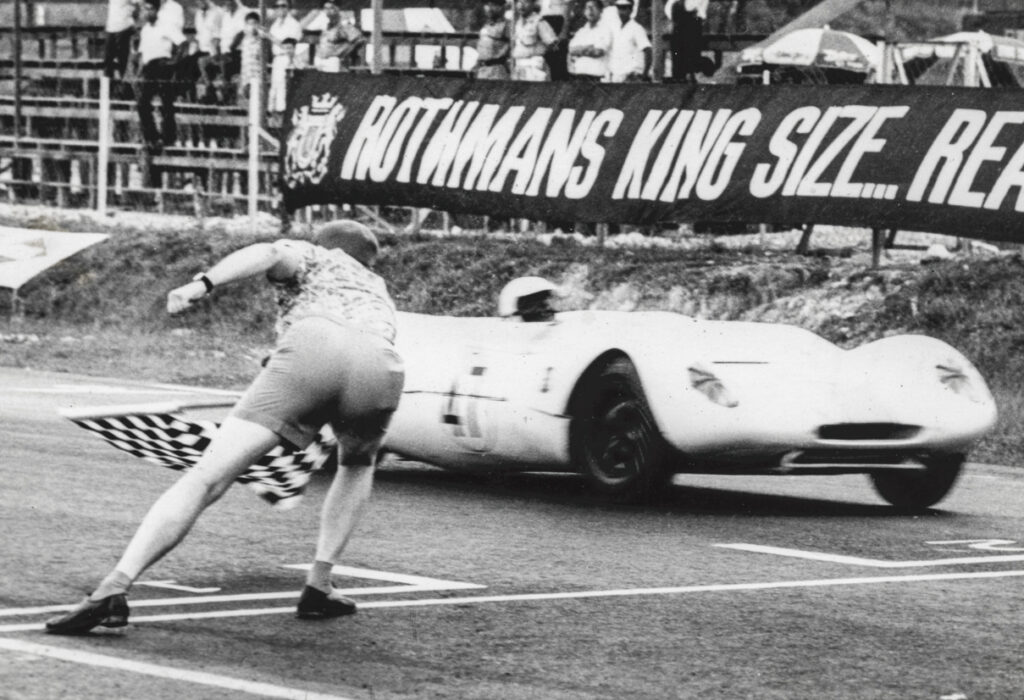
Despite what the 1968 Selangor Grand Prix race program says, this is a Lotus 23 running number 47, on the way to winning the Sports Car race at the newly built Batu Tiga circuit in April 1968. Steve Holland entered the Team Harper Lotus 47 (race No. 47) in the Grand Prix but the car fell off the truck on the way to the circuit. His Hong Kong mates at Harper stepped in with this Lotus 23.
First off, why was Lotus so successful at both club and international levels during the 1950s and 1960s?
One compelling factor was that the company had a good range of sports cars and single-seaters – from the basic Seven, a motorised roller skate, to the far-sighted fibreglass monocoque Elite. Add to that the plethora of single-seaters for various racing formulae and you have a cocktail that appealed to both clubmen and aspiring professional racers.
These cars were of simple construction and built for lightness with engines that were easily obtainable. Such light and agile cars, together with drivers with nerves (and balls) of steel, provided the competitive edge on the street circuits of Johore, Macau, Penang, Selangor and Singapore. As Rodney Seow, Singapore’s last local Grand Prix winner (LUNCH WITH CHAMPIONS), spelled out succinctly in 1963, “If you didn’t have a Lotus 23, you didn’t have a chance.”
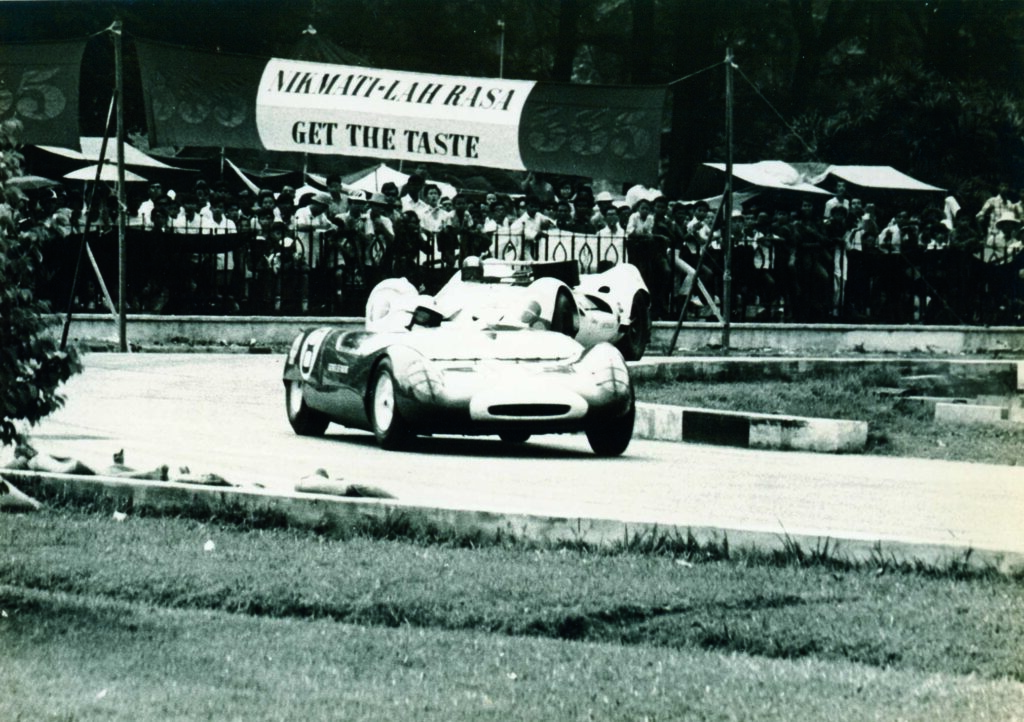
Lee Han Seng’s Lotus 23B, the second of his two 23s, ahead of John Macdonald in the Lotus 30/40, 1967 Johore Grand Prix.
Scant reporting of Asian races in international media has meant a void in Asian motor sports history in international books and publications covering the period when Lotus ruled the roost from the late 1950s to the early 1970s. Local distaste for colonial-period history hasn’t helped either. The “elitist” nature of the sport has meant the governments in South East Asia have tended to shun the subject, resulting in the disappearance and loss of valuable documentation.
Nonetheless, figures do not lie. Lotus was the only marque to have won the Singapore Grand Prix three times (1963, 1965, 1966) and Macau five times on the trot (1961-1965). That was not all. Lotus cars – from the first single-seater (Lotus 18) to the road-registered Lotus Cortina – amassed a total of 22 wins, including class wins in the supporting races, for the 13 years the Grand Prix ran in Singapore. No other manufacturer came close. For a decade, Lotus was the best-represented racing brand in Asia – by a mile.
There are a number of Appendices at the bottom of this article that look at specific cars/individuals – presently these cover the Peter Heath Eleven and 15, Stanley Leong’s 15, Chan Lye Choon’ 20B, John Macdonald’s 47, and Sonny Rajah’s 59/69. I’ll add more when time permits.
THE CLOCK STRIKES XI
Colin Chapman took his modest operations deeper into international sports car racing when he introduced the Lotus Eleven in February 1956, a car aimed at the very popular 1,100cc sports car class. The first Lotus Eleven arrived in Asia in early 1959. Very quickly, a fervent following of the Lotus brand developed, which eventually saw the domination of the Lotus 23s at the Johore, Macau and Singapore races.
The Eleven, with wrap-around windscreen and flush-fitting headlamps blending well with its figure-hugging front wings, was a more streamlined version of the Frank Costin-designed Mark 8, 9 and 10 sports cars. The result was a hugely successful and versatile club, and works, race car at every level of sports car racing, from Le Mans to Sebring and from Singapore’s Gap Hill Climb to the Seremban Sprint in Malaysia.
What set the Eleven apart from the rest of the competition (there was little in 1956) was that Lotus offered three different configurations to buyers: The Le Mans model, with a 1100cc Coventry Climax FWA engine, all disc brakes, and headrest behind the driver; a Club version, with drum brakes and live rear axle; and a Sports version, identical to the Club version but with a less powerful, production-based engine, usually from Ford.
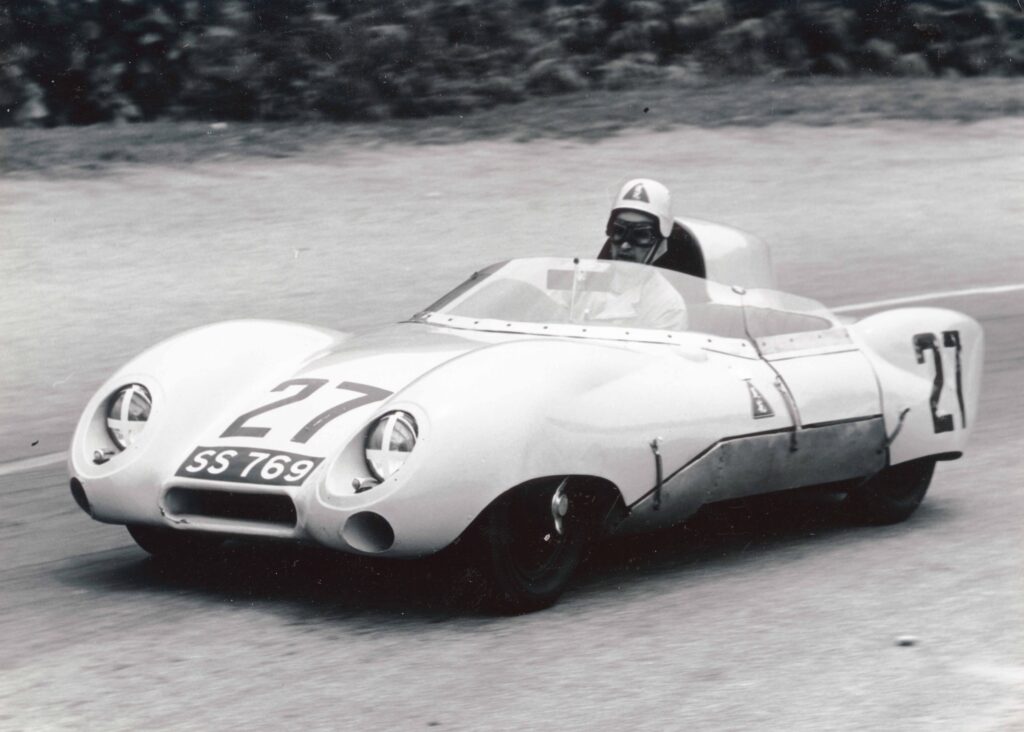
Tony Huggett’s Eleven Climax at the Gap Hill Climb in Singapore following a change in colour scheme. This car was the first known example of a Lotus race car in South East Asia.
The end of the 1950s was a watershed for the sport in South East Asia. Enthusiasts eagerly anticipated the resurrection of the Johore street Grand Prix and Singapore enthusiasts lobbied for their own Grand Prix.
The end of the 1950s was a for the sport in South East Asia. Enthusiasts eagerly anticipated the resurrection of the Johore street Grand Prix, and Singapore enthusiasts lobbied for their own Grand Prix. Macau already had an established annual street race.
The first event in Singapore the Eleven was entered in was at the 1959 Lim Chu Kang ½-mile Sprint held in March. Its new owner, A.J. “Tony” Huggett, had arrived in Singapore in 1955 to work for the optical arm of Motion Smith. He raced TR Triumphs at various sprints and hill climbs in Singapore and soon invested in a Lotus Eleven Le Mans Climax in 1959. The car was said to have had prior Le Mans and European racing history. I don’t have a chassis number but the Singapore Lotus gurus will know the history of this car, and probably all its serial numbers, from day 1. By May 1959, Huggett had all but destroyed his Eleven at Singapore’s treacherous Gap Hill Climb.
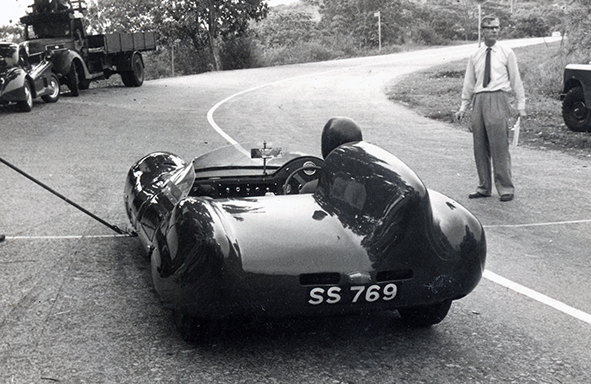
Tony Huggett’s Eleven Le Mans Climax in the colour scheme in 1959.
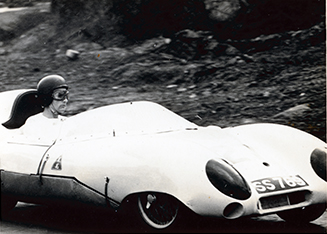
The sports car of the future was already present in Singapore in 1959. The low-slung Lotus Eleven Le Mans Climax may not have been as new but it was fast enough to upstage the club’s “Upper Class” and show them what lay ahead in the coming years, even though Tony Huggett managed to pulverize his road registered car at the Gap Hill Climb in May 1959. A rapid rebuild of the body with new leaf-green colour scheme was completed later that year.
The Lotus circle soon included Bangkok-based Edward “Peter” Heath with his Eleven (later sold to Malaysian Saw Kim Thiat), architect Stanley Leong with a Lotus 15, film producer John Armstrong with a Lotus Seven, a pair of road-registered Elites and a number of 23s [CASE BOOK of 23s].
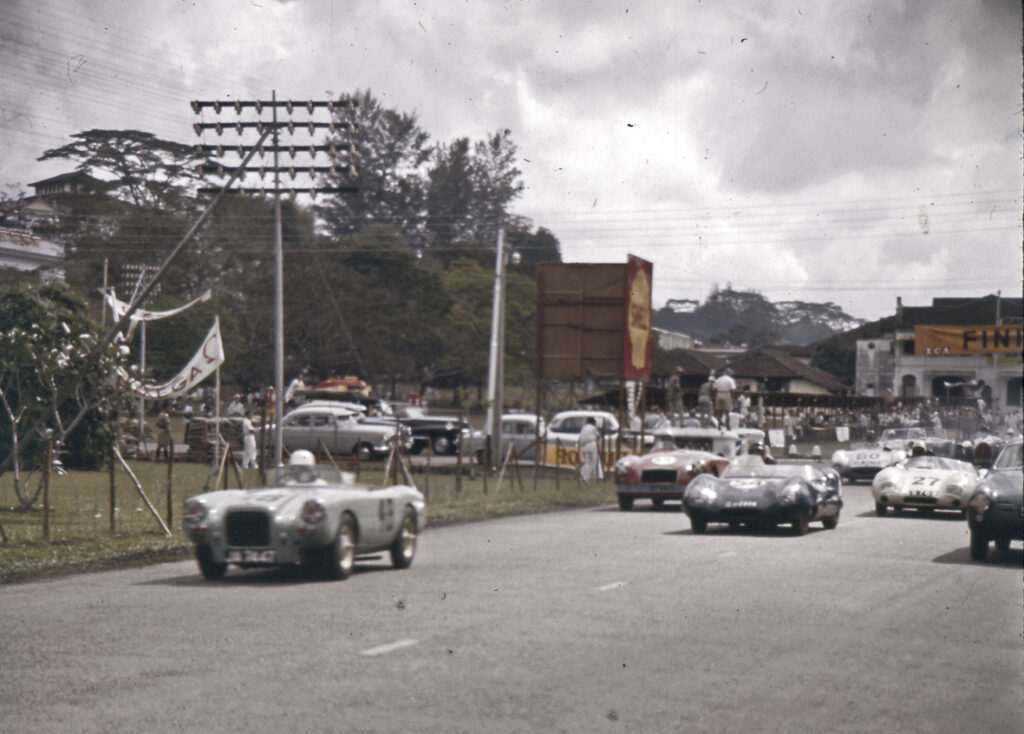
Two Eleven Climaxes about to swallow a little Berkeley along the main straight in Johore during a support race for the 1960 Johore Coronation Grand Prix.
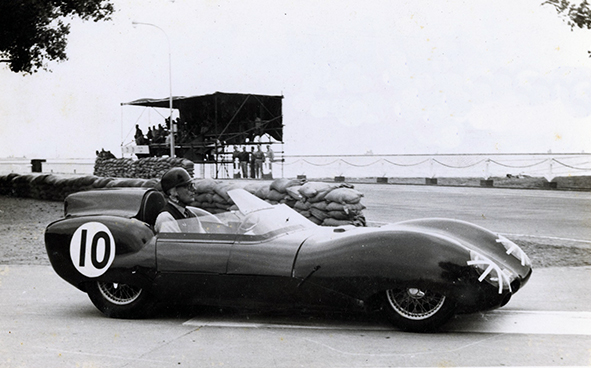
Peter Heath’s Lotus Eleven Climax cut a very impressive picture when it raced in Macau in 1959. The car started second on the grid but sadly DNF-ed due to transmission issues.
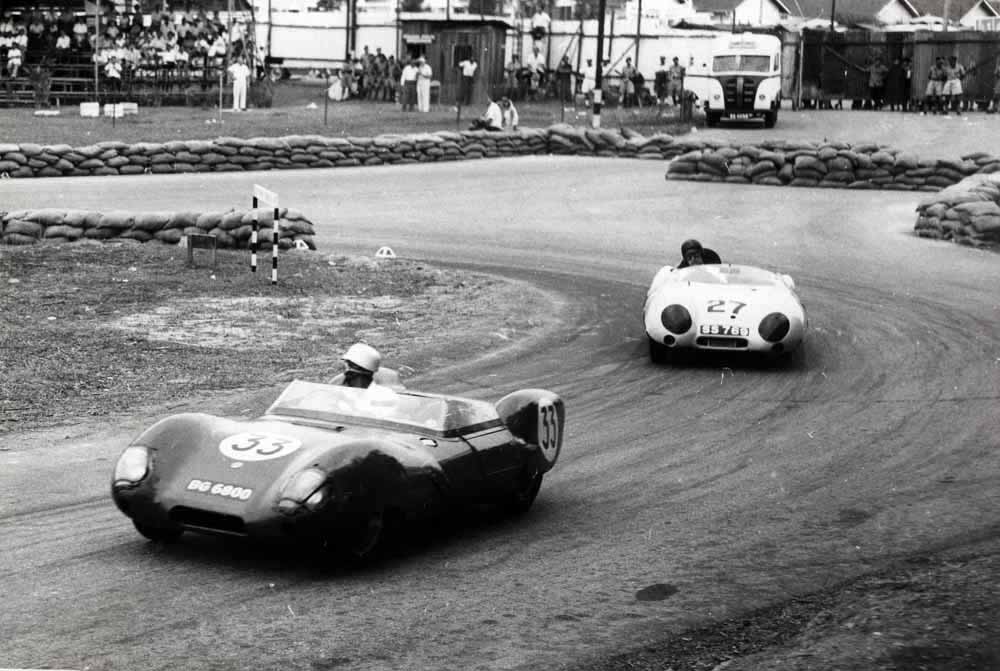
Saw Kim Thiat’s Lotus Eleven having just overtaken Tony Huggett’s Lotus Eleven Le Mans Climax into lap 6 of the Sports Cars support race of the 1961 Singapore Grand Prix . Saw’s car, previously owned by Peter Heath, was a Series 2 Eleven, Chassis 522. Engine FWA 7749.
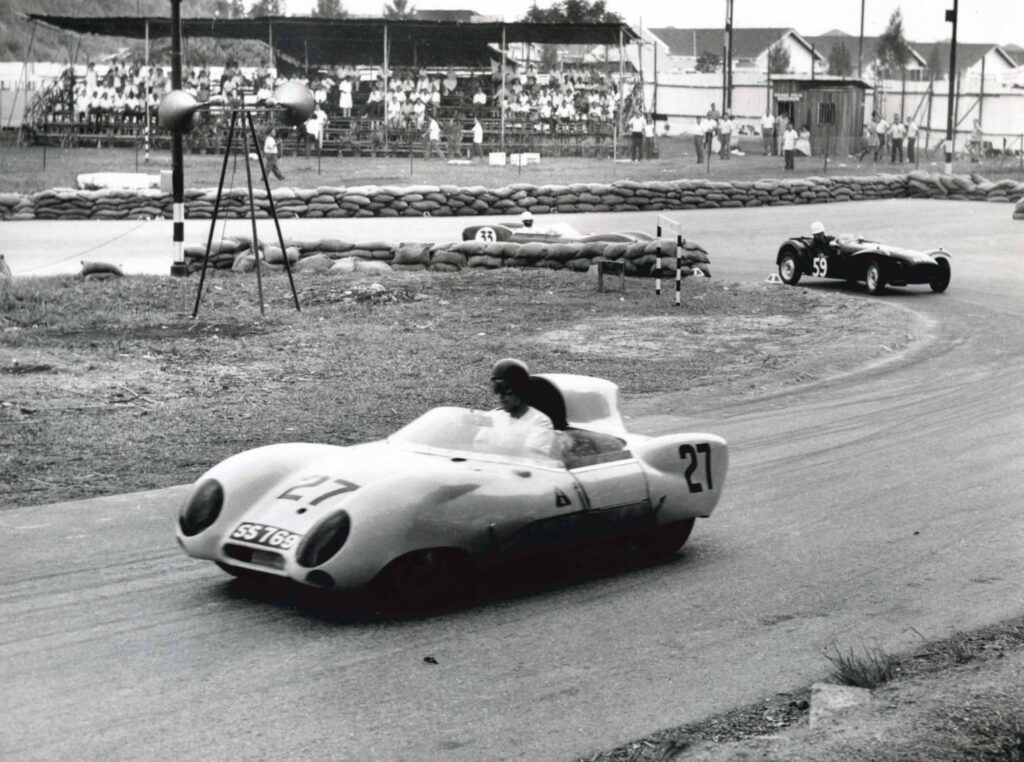
Two Lotus round Circus Hairpin during the inaugural Singapore Grand Prix (1961). Tony Huggett’s Le Mans Climax streaks ahead of John Armstrong’s Lotus Seven.
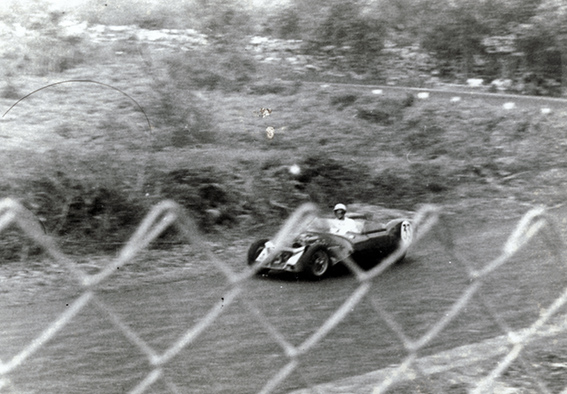
Saw Kim Thiat shoots past Devil’s Bend sans front hood in his Lotus Eleven – 1961 Singapore Grand Prix.
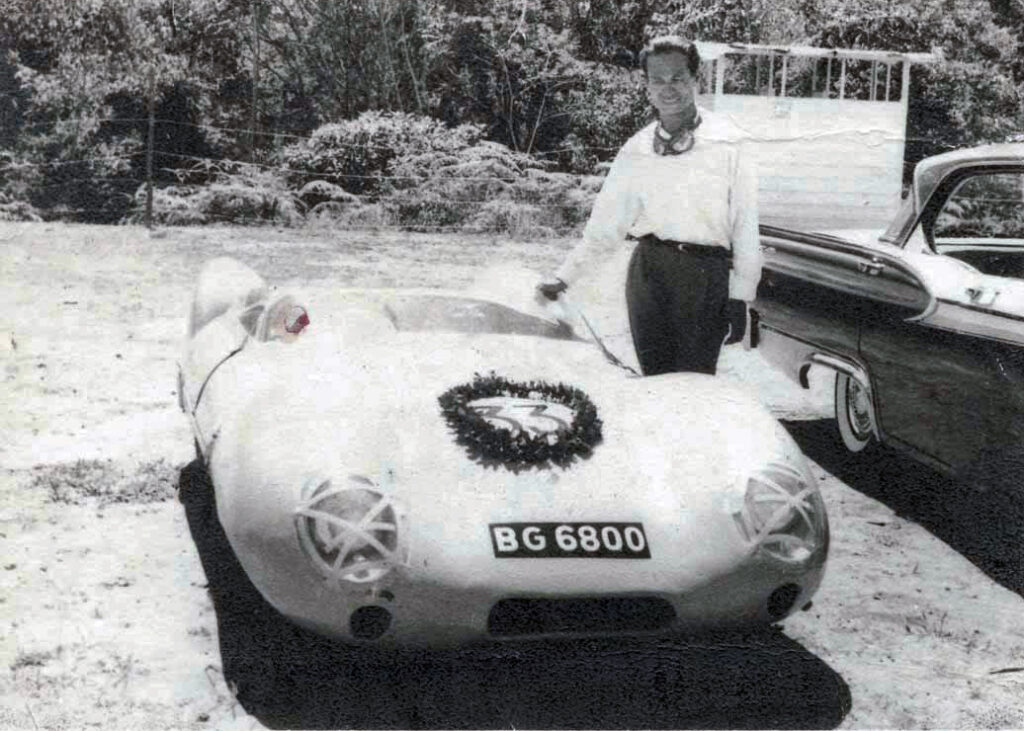
Saw Kim Thiat with the little Lotus Eleven he purchased from Bangkok-based Peter Heath. Prior to acquiring the Lotus, Saw had raced variety of sports cars, including an Jaguar XK120. This Lotus Eleven was first raced in Macau in 1959 by Peter Heath (running No.10).
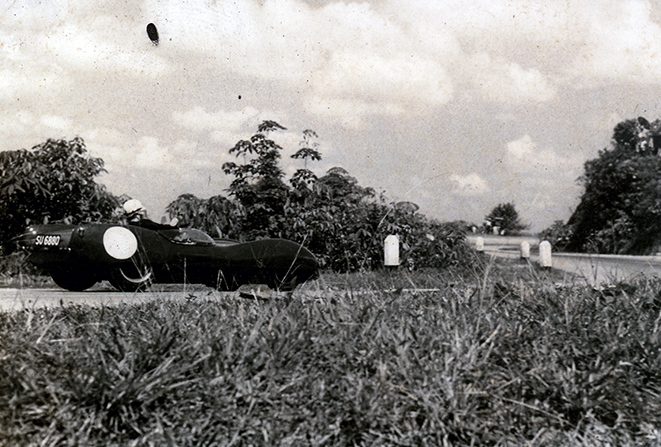
Peter Brown had purchased a road registered Lotus 17 in 1961. The car, said to have been the ex-Le Mans 1959 works entry, made its debut at the Gap Hill Climb on 2 April 1961.
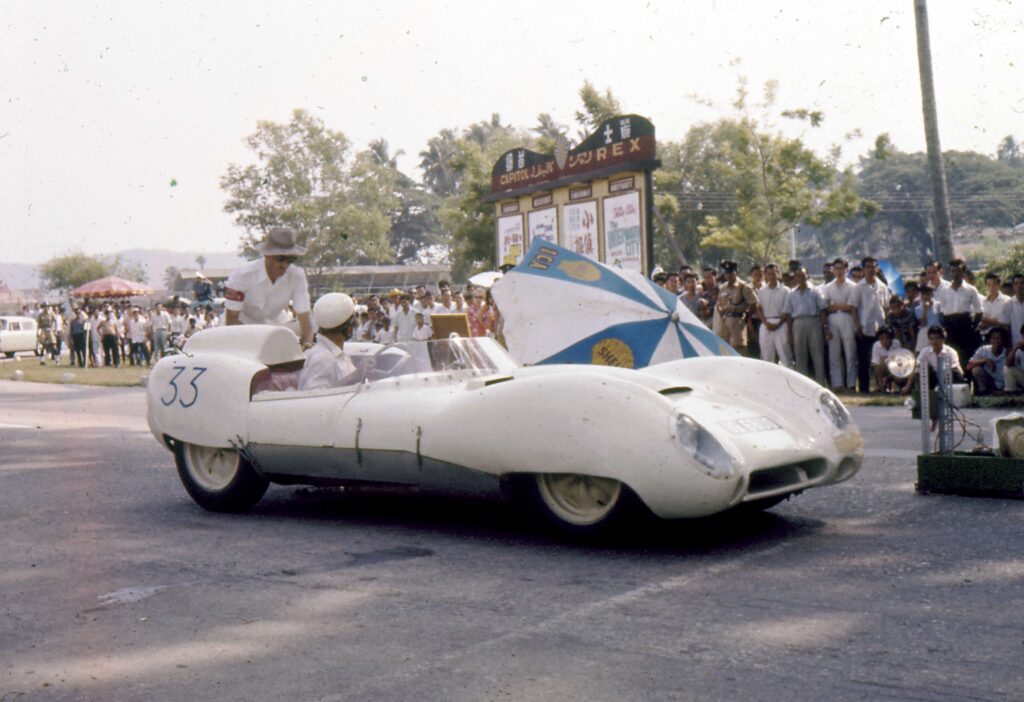
Saw Kim Thiat in ex-Innes Ireland 1959 works Lotus 15 Series 3 (chassis 620-3) that Ireland had originally assembled using a 1½-litre Coventry Climax FPF engine and a ZF 4-speed close-ratio gearbox. Saw purchased the 15 from Peter Heath.
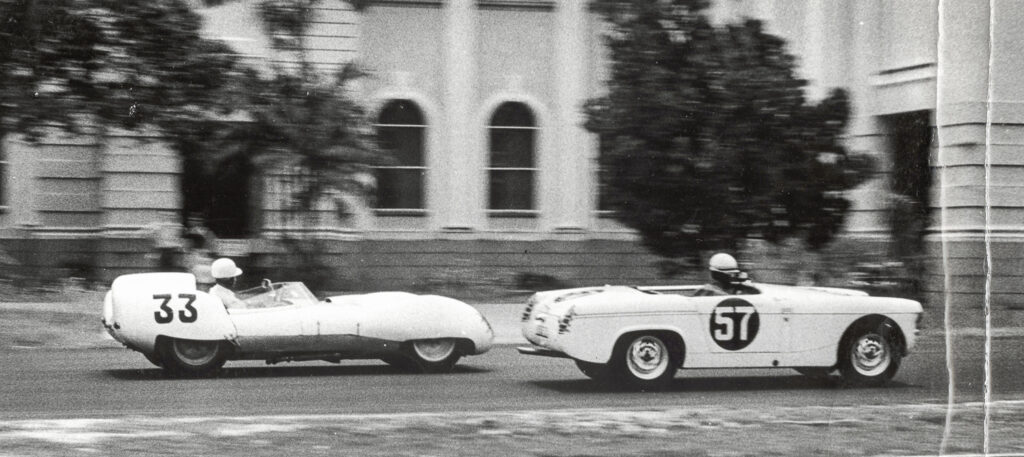
A.A. Aziz’s 948cc MG Midget is about to be lapped by Saw Kim Thiat in his very fast Lotus 15 Climax in the 1963 Mightyplate Trophy support race for sports cars. Saw finished first overall with Aziz fourth overall and first in the sub-1,000cc race.
When automobile importer Chan Lye Choon swapped his Aston Martin DB3S for a Lola Mk1 FWE Climax for the 1961 Johore Grand Prix, Lotus owners needed something just as nimble and a lot stronger to sustain the over 300km circuit races in tropical heat and rain. Architect Stanley Leong took the unorthodox approach and fitted a 2-litre Ferrari engine into his Lotus 15 and christened it the Ferratus. Other Lotus sports car owners looked towards the new Lotus factory in Chestnut, Hertfordshire for deliverance. It took two years before their prayers were answered – in the form of the Lotus Type 23 sports car.
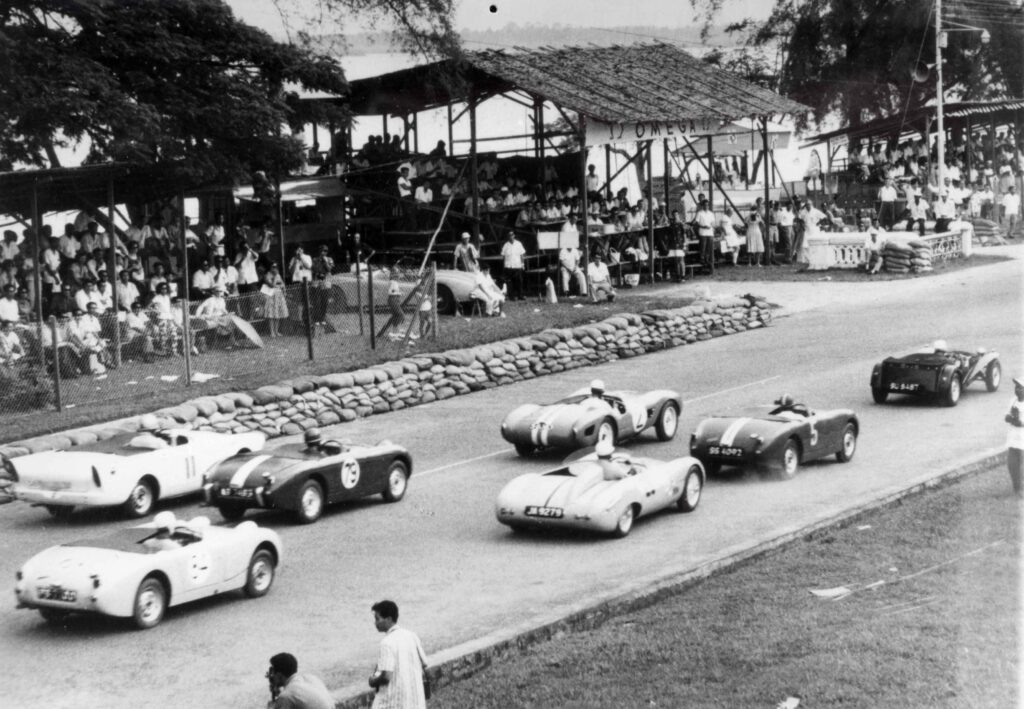
John Armstrong leads the way in his Lotus Seven in Race 2 for Sports Cars up to 1500cc in the 1961 Johore Grand Prix.
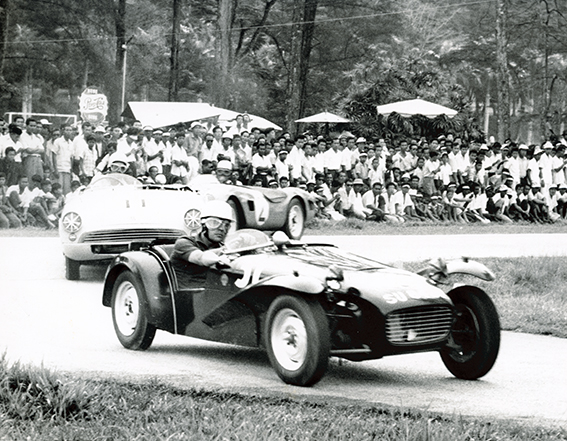
12 June 1961 – John G. Armstrong’s Lotus Seven arrived in Singapore on 12 June 1961 with preparation commencing immediately for the 24-25 June Johore Grand Prix. The car is pictured at the 1961 Johore Grand Prix. At the back of this trio of cars is Chew Chek Leun in the Ban Sing Special Mk2.
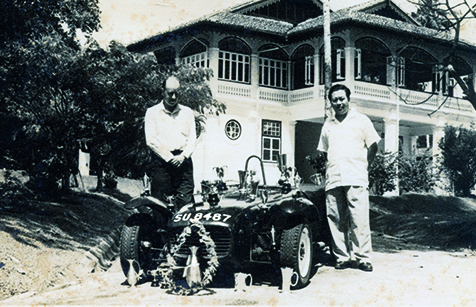
John Armstrong’s Lotus Seven originally arrived in Singapore with a 997cc motor in June 1961. The car is pictured with Armstrong and his mechanic, aircraft engineer Loh Yap Ting. Loh later went on to crew for Rodney Seow, Dodjie Laurel, and Hengky Iriawan.
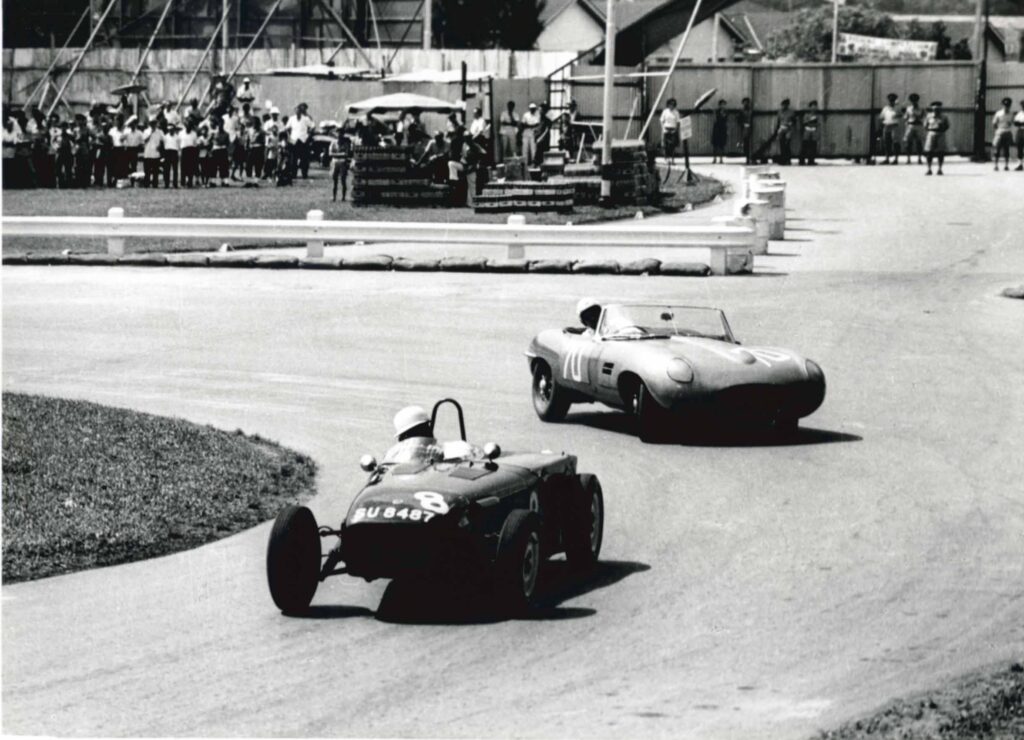
John Armstrong takes the Circus during the 1963 Grand Prix in Singapore. Behind the Lotus is eventual winner, Yong Nam Kee, in his Jaguar E-Type.
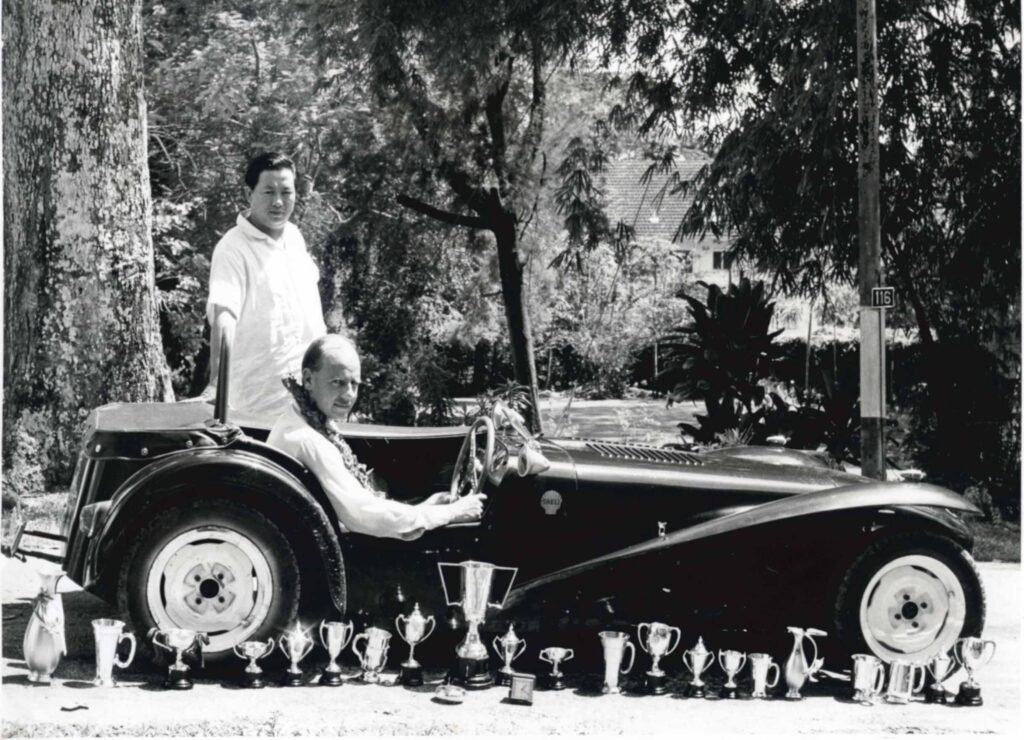
John Armstrong’s trophy haul from racing in South East Asia. By his side is his mechanic, aircraft engineer Loh Yap Ting.
GIANT KILLER ARRIVES
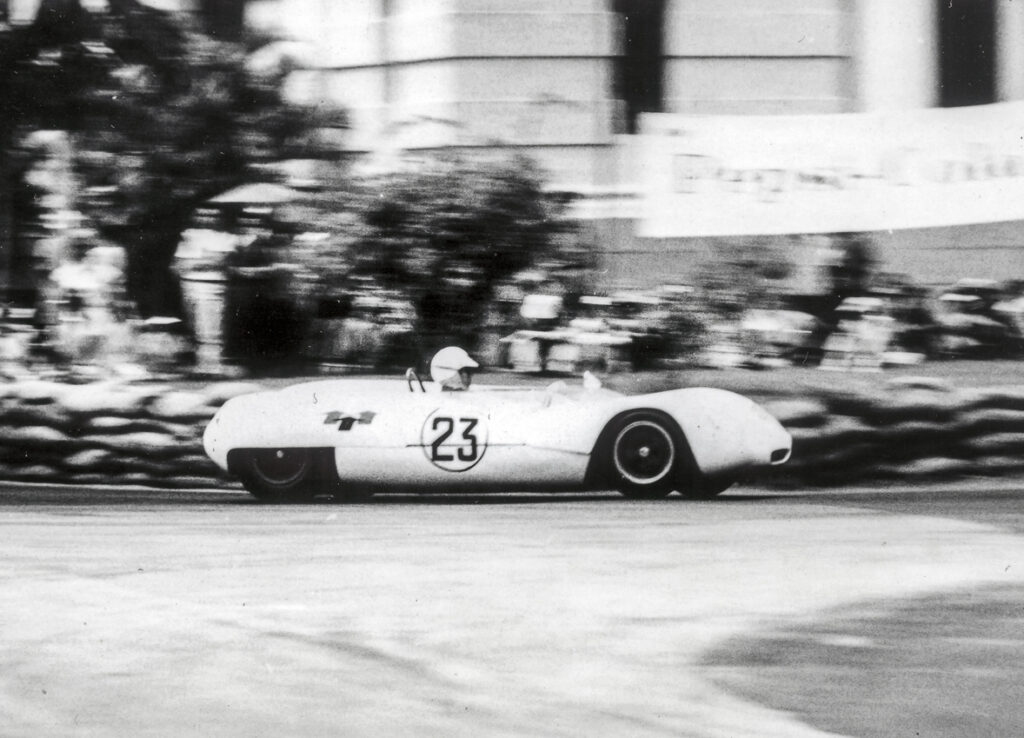
Albert poon, on his way to his first Grand Prix win in South East Asia in his first Lotus 23 – 1963 Johore Grand Prix. The Singapore Lotus gurus know the chassis details and full history of this car, but for all intents and purposes, I’m sticking with what Albert Poon told me and with the story that it burnt to a crisp in Macau on 28 November 1965. (see LUNCH WITH CHAMPIONS, CASE BOOK OF 23s). The car made it first appearance racing in Asia in the 14-15 April 1963 Grand Prix in Singapore. It was also the first time Poon had raced outside Hong Kong/Macau. Local experts will recall seeing the car on display at the Malaysia Day celebrations, held at Singapore’s Paya Lebar Airport from 15-17 September 1963.
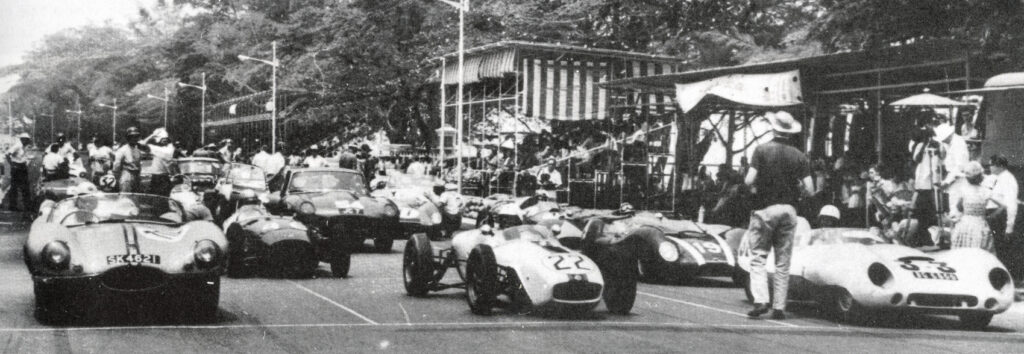
Starting grid for the ill-fated 1963 Johore Grand Prix. Yong Nam Kee’s D-Type with John Kirk alongside in the Lotus 18 and Saw Kim Thiat on the far right in his Lotus 15 Climax. Chan Lye Choon is on row two in his #19 Lola Mk1 Climax (favoured over his Lotus 20B).
The Lotus 23, wrote Dr Mike Lawrence, could “with a half decent driver at the wheel…beat any other small sports car of the time.” The 23 and its larger-engined twin, the 23B, held sway over circuit racing in Asia from 1963 and 1965, winning the Grands Prix in Singapore and Johore in 1963, Macau in 1964, and again in Singapore in 1965, all thanks to race driver Hong Kong Police Inspector Albert Poon [LUNCH WITH CHAMPIONS, CASE BOOK OF 23s]. Poon had been racing in the Macau Grand Prix from the late-1950s and was already an experienced hand. Together with his Hong Kong compatriots Steve Holland, Walter Haskamp, Bill Wyllie, Hardy Burmester, Teddy Yip and John Macdonald, backed by agents for Lotus in Hong Kong, Wallace Harper, they often dominated the Singapore and Malaysian races. Poon would become synonymous with the Lotus 23 (and later with his Alfa Romeo GTA). A latecomer to the single-seater, it was only in 1967 that he made the switch with an Alfa Romeo-engined Brabham.
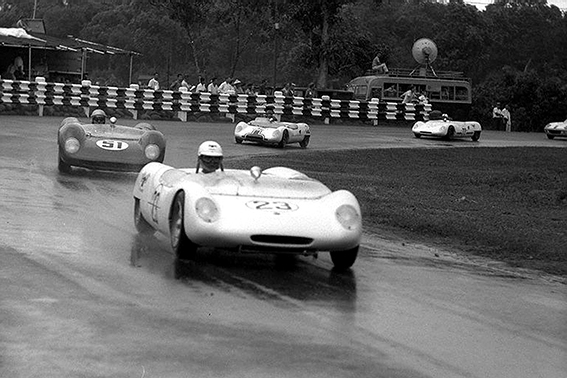
Albert Poon leads the pack in his Lotus 23 during the 1964 Grand Prix in Singapore. The 23 is closely followed by Arthur Owen in a Brabham BT8. Behind the Brabham are three other Lotus, with Alan Bond and his ex-Normand Racing 23B behind Owen. Look closely and you may notice a Lotus Elan peeking out from the right of the photo. That would be the #17 Warner Elan of John Kirk, an ex-Chequered Flag Warner Elan.
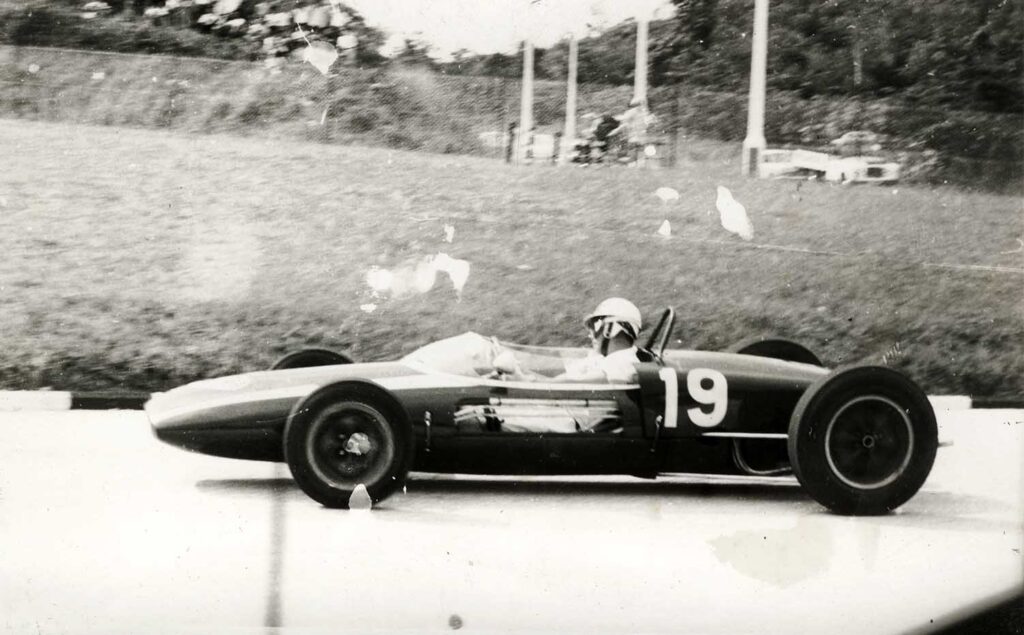
The Lotus that was meant to knock out the sports cars and start the open-wheeler revolution in Asia…Chan Lye Choon’s Lotus 20B, in action at the Diplomatic Enclave street circuit in Kuala Lumpur in 1962. In fact, Chan was victorious on 25 November at the 1962 TAR Circuit Races in Kuala Lumpur. Several owners later, Australian advertising executive Tony Maw famously won the 1967 Grand Prix in the very car.
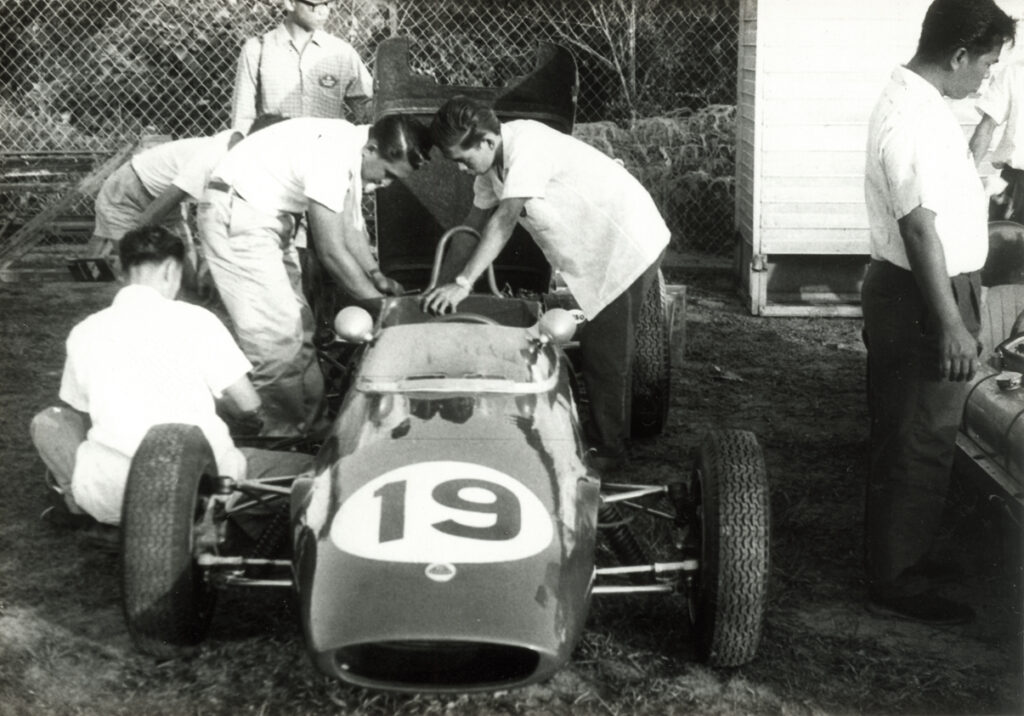
Chan Lye Choon’s Lotus 20B is well known amongst the local gurus. Here’s the car in the Singapore paddock ahead of the 1963 Grand Prix. It was a disappointing race for the local car distributor. He was lapped in the Grand Prix by eventually winner Albert Poon, and to add insult injury to insult, crashed out later in the race.
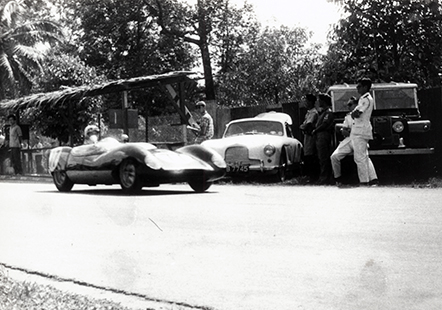
The 1963 Grand Prix in Singapore was the introduction of the only Lotus 17 to race in the region…on this occasion driven by Bill Wyllie. The car arrived in Singapore around October 1960. Registered in Singapore as SU6880 made its racing debut on 2 April 1961 at the Gap Hill Climb. Peter Brown, who raced it early on in Singapore, knew it originally was a stage 3 ex-1959 Le Mans works car with <1-litre motor, though by the time it raced in Asia, it had a 1098cc motor. The local experts will know of its whereabouts following Arthur Whitlock’s disastrous crash in the 1968 Singapore Grand Prix.
When Singaporean Lee Han Seng famously won Singapore’s first post-Independence Grand Prix in his tried-and-tested Lotus 22 single-seater (which Hong Kong tycoon Teddy Yip quickly purchased), everyone knew the writing was on the wall for the sports cars in local racing. It was the first time a single-seater had won the coveted Grand Prix in South East Asia, but Lotus already had a sterling reputation in Macau with Filipino Dodjie Laurel, who claimed the double in 1962 and 1963 in a Lotus 22 Formula Junior.
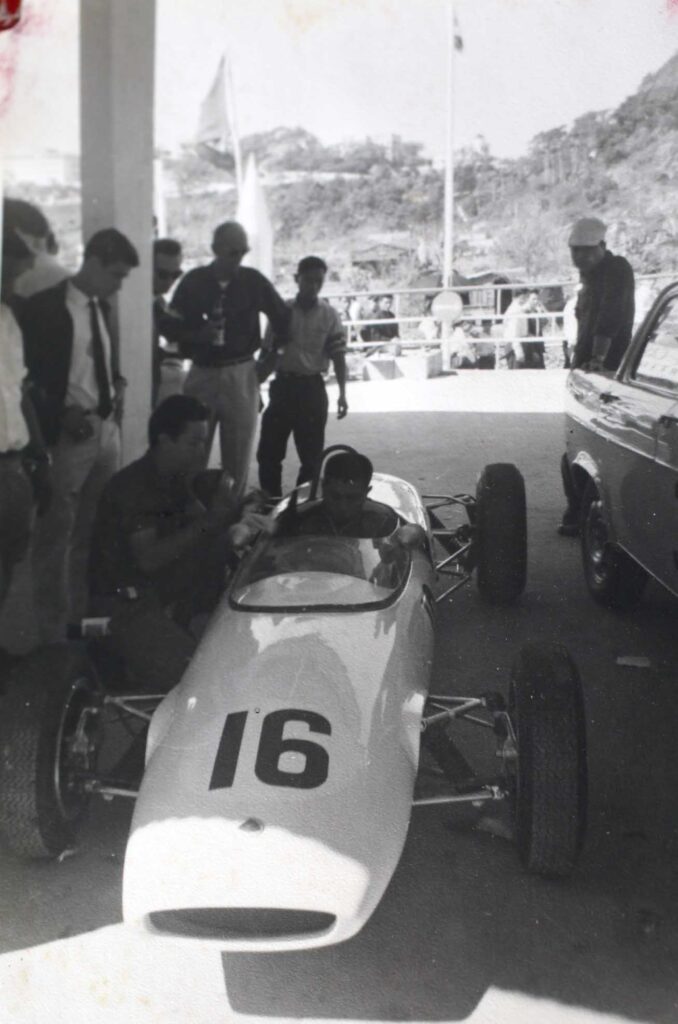
Filipino Arsenio “Dodjie” Laurel won the 1962 Macau Grand Prix in his Lotus 22, setting a new course lap record of 3:10.2 in the process.
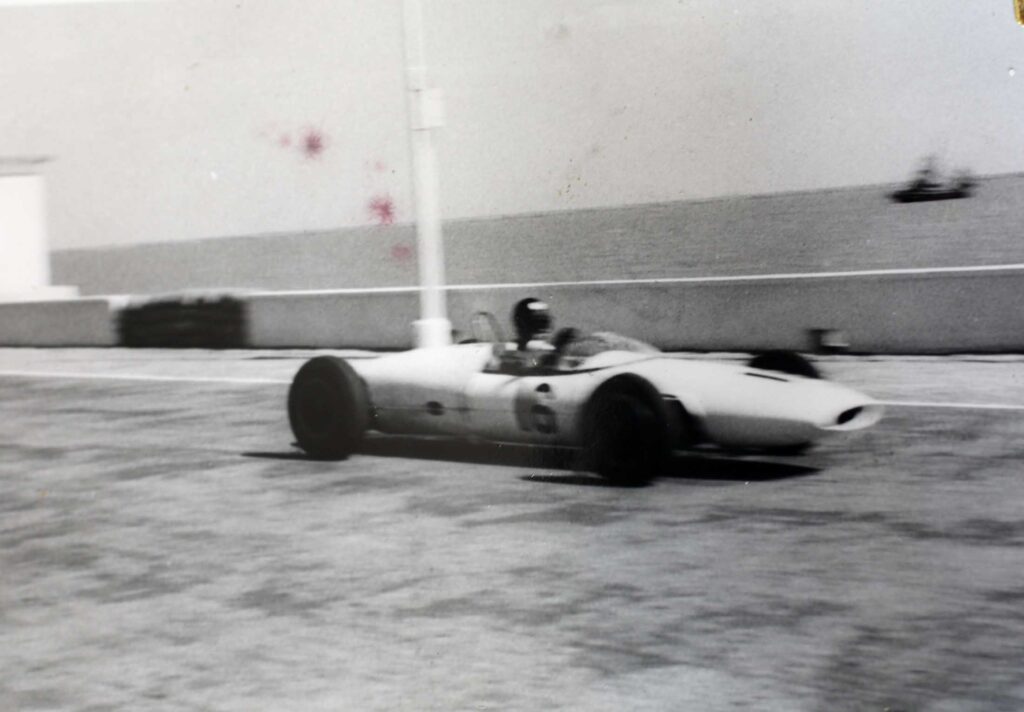
Dodjie Laurel on the way to the first of his back to back Macau Grand Prix victories in his Lotus 22.
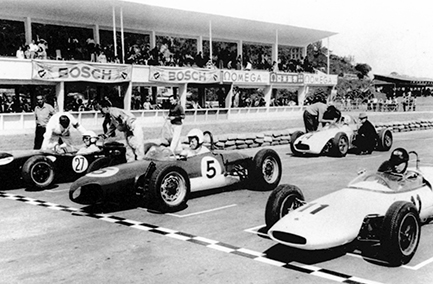
The starting grid for the Formula Junior support race to the 1963 Macau Grand Prix. No.11 is Dodjie Laurel on his Lotus 22 while the car on the second row (No.14) is Steve Holland’s Lotus 18. Laurel went on to win the main Grand Prix race (starting from Pole), setting FTD and a new lap record of 3:6.8 in the process.
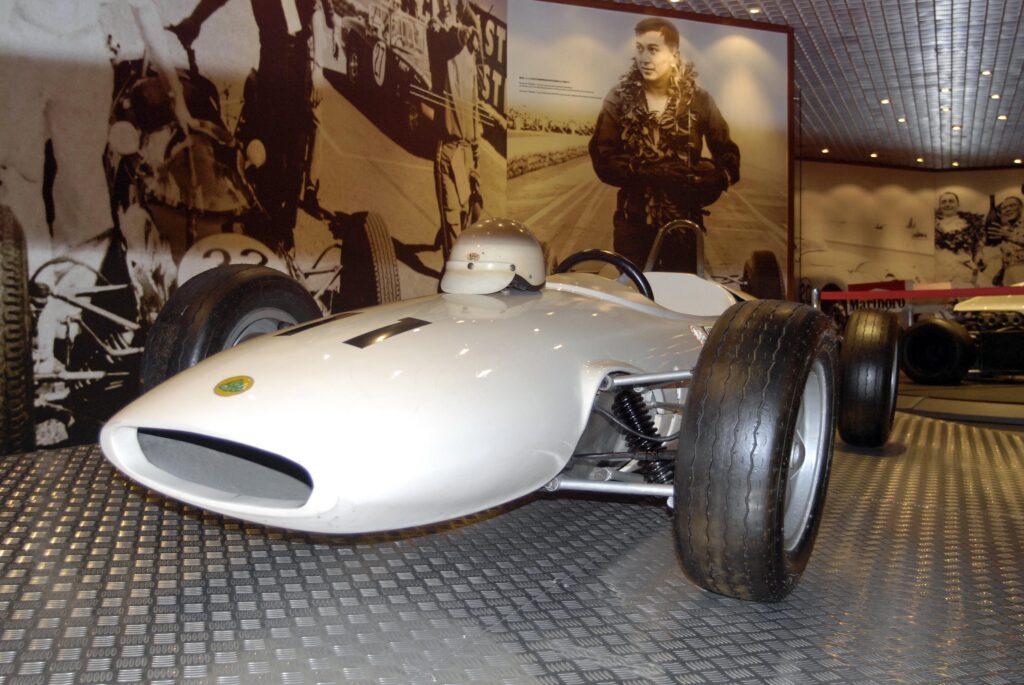
Dodjie Laurel’s very successful Lotus 22 – seen on display at the Macau Grand Prix museum in 2006.
Albert Poon made amends for sports car owners when he took the win in Macau in his original 23 the following year (1964), the car backed by Bob Harper’s team. Lotus were on a winning streak in Macau. In 1965, John Macdonald, who was experimenting with single-seaters, purchased the ex-Team Harper Lotus 18 (which racer Steve Holland called a “useless old heap”) and dragged the “super friendly, super frail” machine to victory. The former Hong Kong policeman gamely revealed to me: “My idea of stopping its reputation for bits falling off was to strike a bit of arc weld across many nuts and bolts. Even then the car ran out of fuel on the slowing down lap.” The car however erased any doubt in everyone’s mind that single-seater race cars was the way forward, but it would take another two years for this to fully manifest itself.
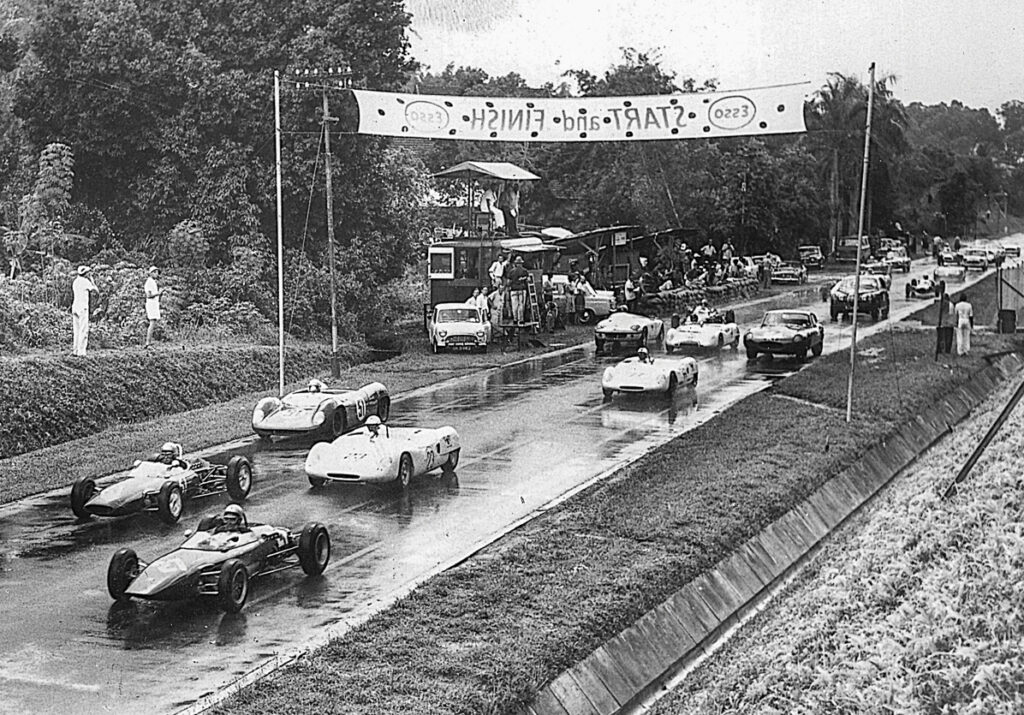
How many Lotus 23s can you count in this photo of the start of the 1964 Grand Prix in Singapore?
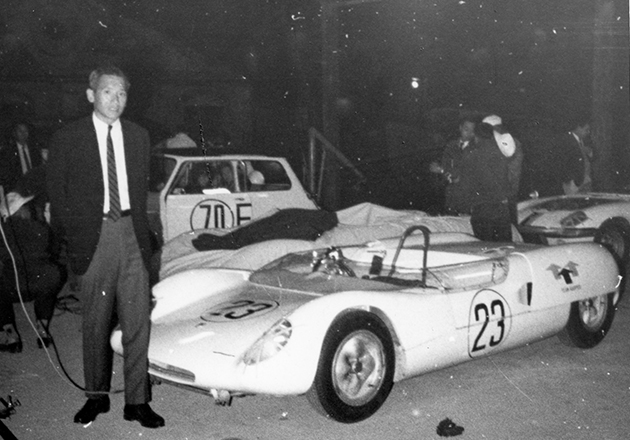
The year Lotus stole the show in Macau. Albert Poon, eventual winner, is pictured by his Lotus 23. There were eight Lotus cars on the Macau Grand Prix grid!
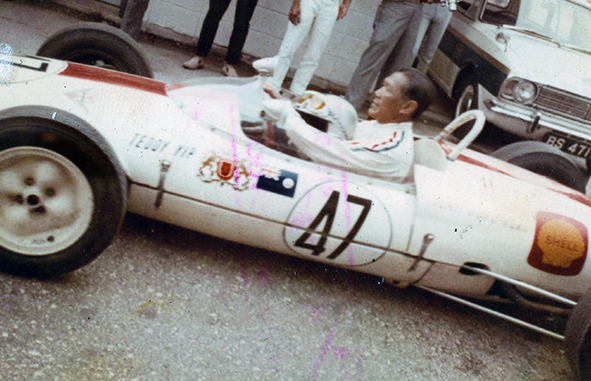
Lee Han Seng’s 1966 Singapore Grand Prix-winning Lotus 22 was sold to Hong Kong tycoon Teddy Yip. The car made an appearance in April 1970 for the Selangor Grand Prix, entered by Yip.
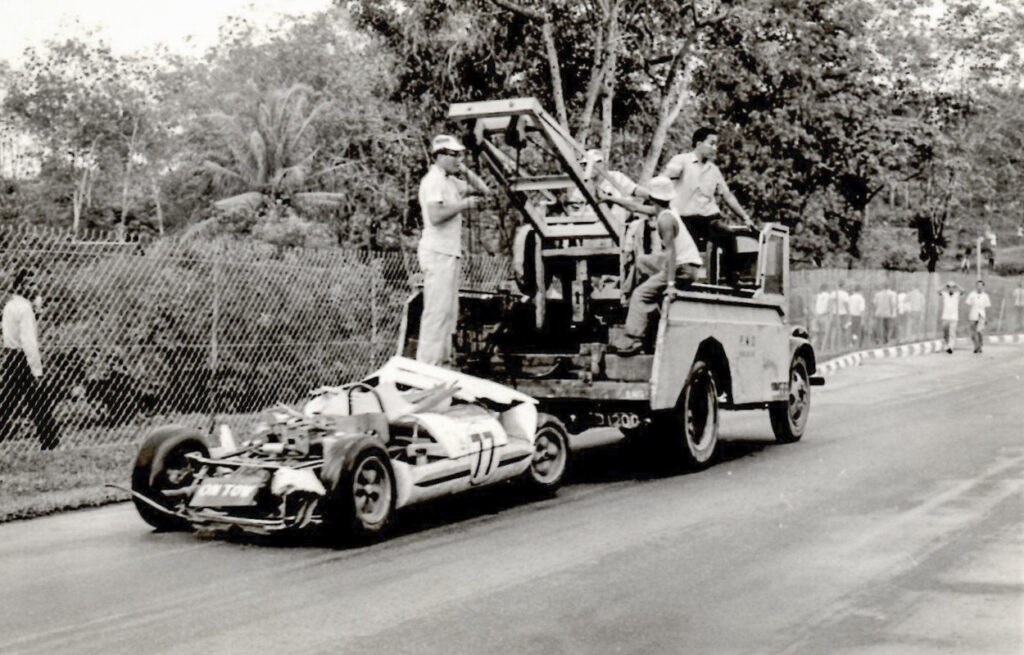
Racing on street circuits can be hazardous, as Bill Wyllie found out in his Lotus 23B in Singapore in March 1964. So did Alan Bond in the other Lotus 23B.
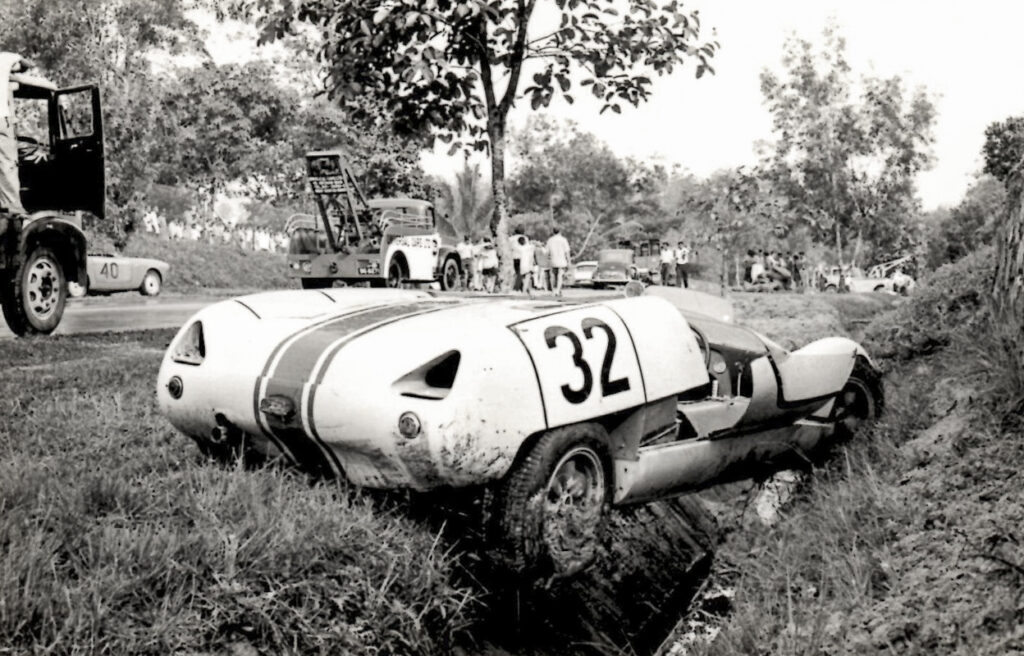
The Grand Prix in Singapore in 1964 was a disaster for Lotus owners. Alan Bond’s Normand Racing 23B straddles a ditch.
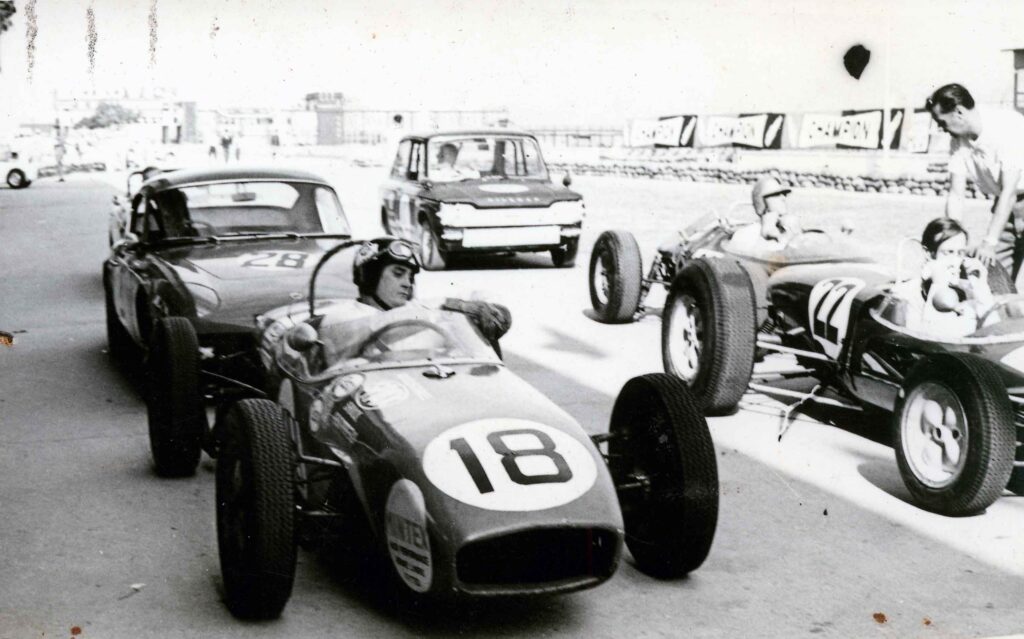
John Macdonald (No.18) prepares to head out for practice at the 1966 Macau Grand Prix in his 1965 Grand Prix-winning Lotus 18. The car would prove too frail for his endeavours so he switched to a Cooper Formula Junior for the main Macau Grand Prix race. To Macdonald’s left is Dr Tony Goodwin and his ex-Chan Lye Choon Lotus 20B. Behind Macdonald is Stanley Leong’s Shapecraft Elan (which Walter Haskamp later purchased).
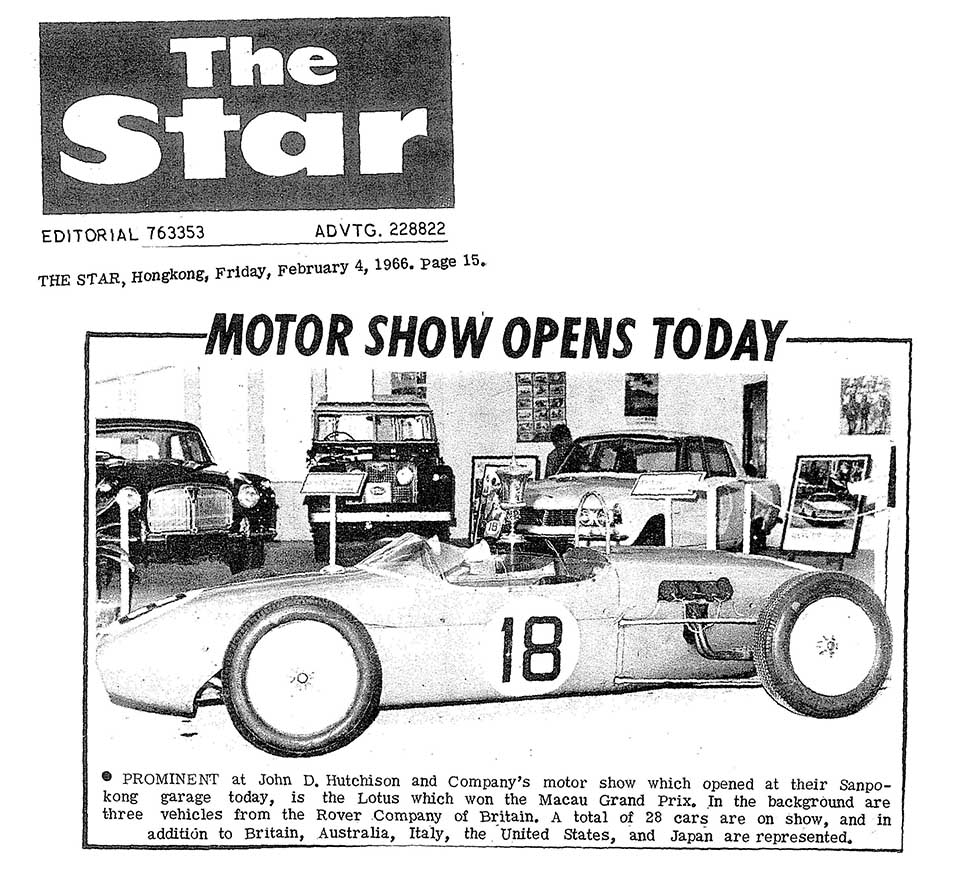
The John Macdonald Lotus 18, proudly displayed at the Hong Kong Motor Show in 1966.
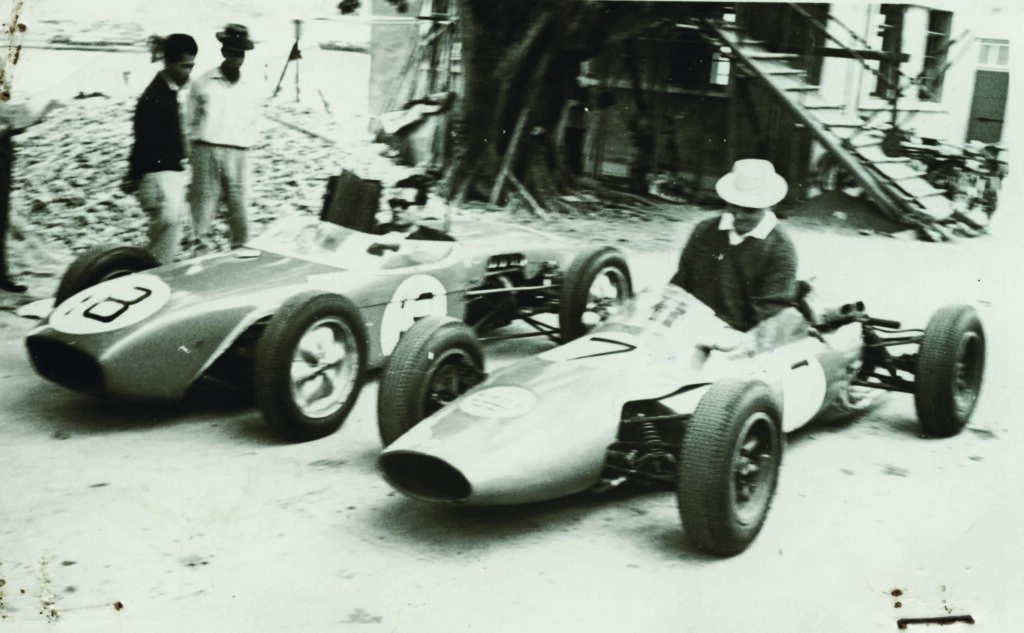
Lotus 18 FJr and Cooper FJr. 1966. Macdonald ran the #7 Cooper in the 1966 Macau Grand Prix, the Lotus 18 used only during practice.
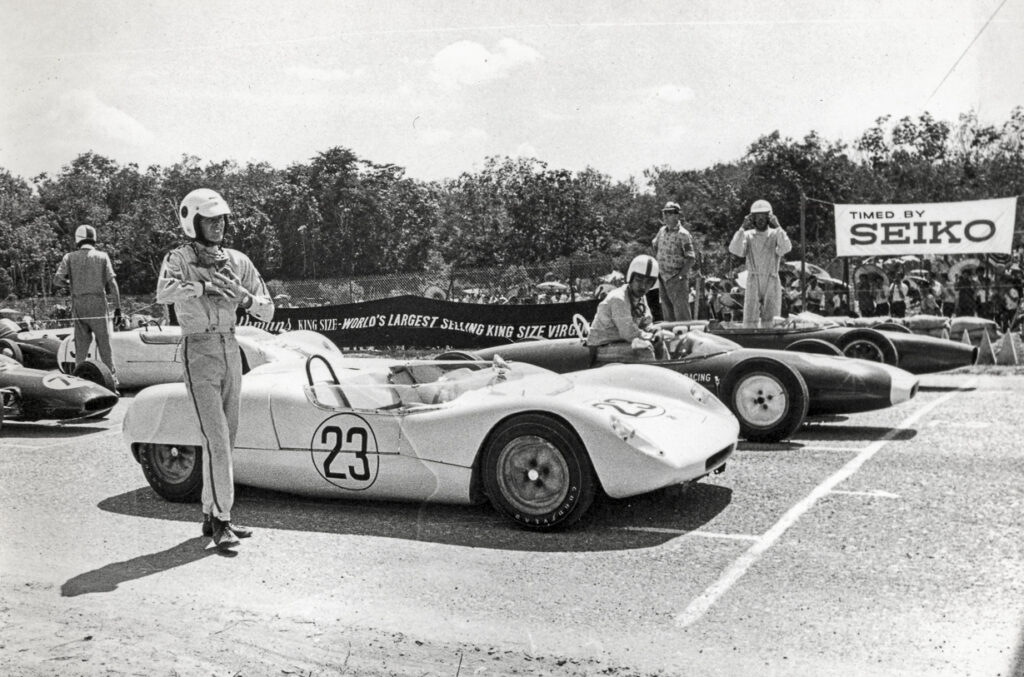
23 or 23B…The history of Asian Lotus 23s is a subject where angles fear to tread. By the way, #23, Albert Poon’s original Lotus 23, later went to Steve Holland. Holland watched as it became a a pile of incandescent magnesium at Melco Hairpin in Macau in November 1965. Chassis number? Ask the local experts, though Albert Poon will tell you it was chassis 23 because why else would he have run it with race number 23? This photo is from the 3-4 July 1965 TAR Circuit Races in Petaling Jaya and shows the #23 Lotus, now raced by Steve Holland. Alongside is Lee Han Seng’s Lotus 22. and to the outside is Rodney Seow’s Merlyn Mk5/7. You can just about make out Alan Bond’s #32 Lotus 23B in the background.
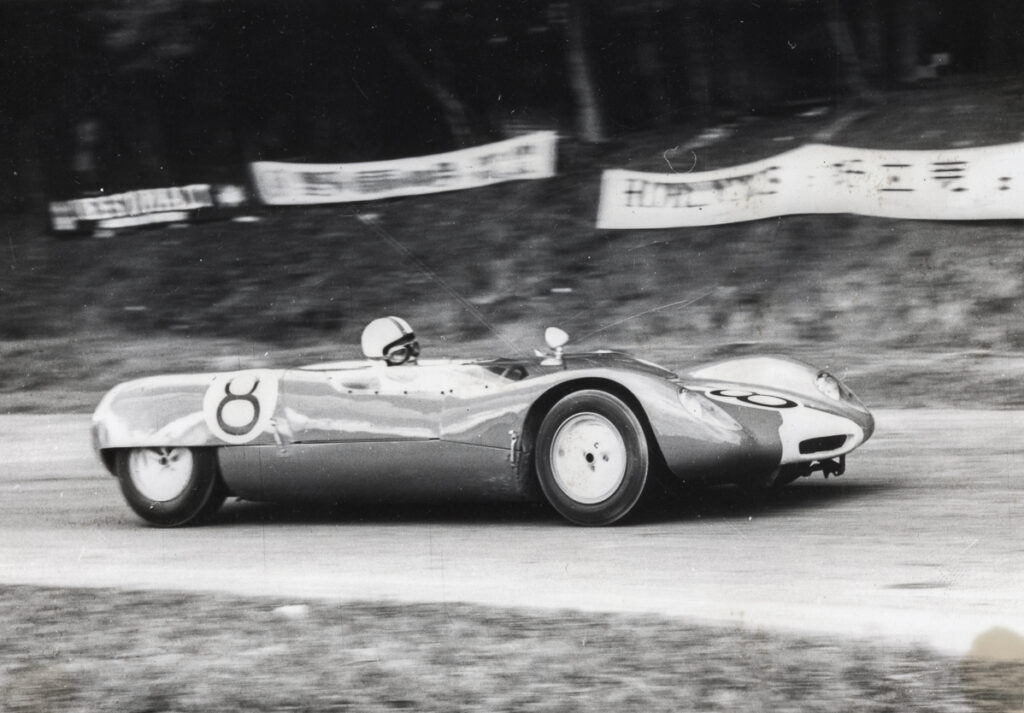
Lee Han Seng racing his first Lotus 23 in Singapore, 1965 Grand Prix in Singapore. The car would change ownership and make the make the journey to Hong Kong at the end of the year, property of Teddy Yip. Note the lack of a roll hoop and air scoops on the lower front of the bodywork.
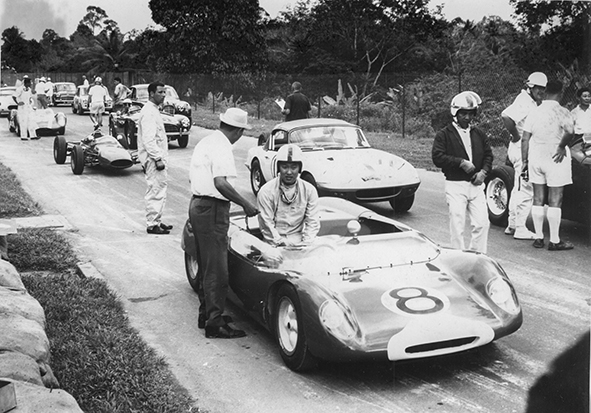
Part of the grid for the 1965 Grand Prix in Singapore showing Lee Han Seng and his first Lotus 23. Behind him is the No.11 Lotus Elan of Chong Boon Seng (Chong is pictured standing in the middle of the photo).
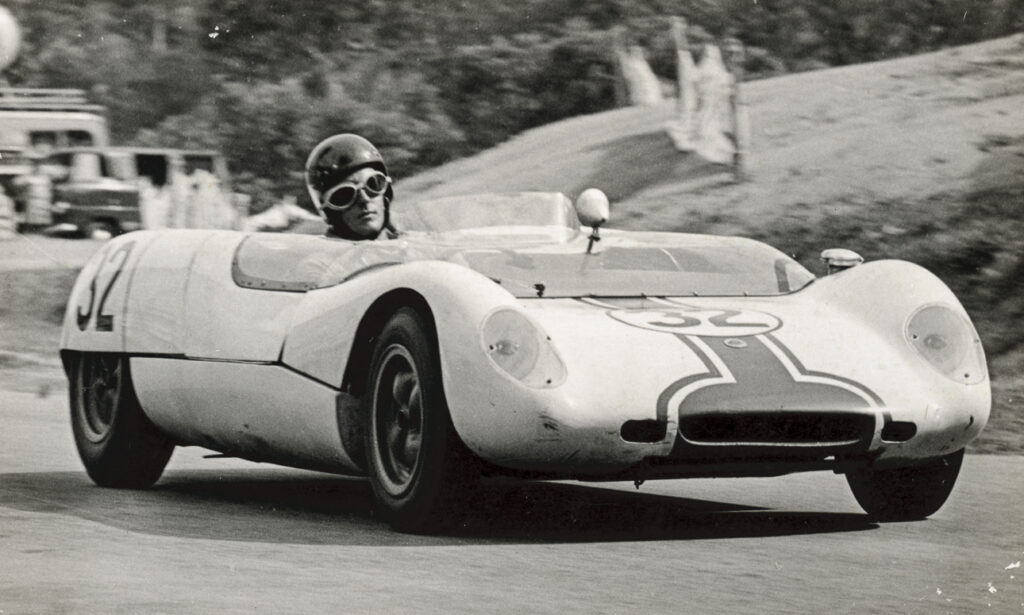
The ex-Normand Racing Lotus 23B made its first appearance in South East Asia in January 1964 in the hands of Alan Bond.
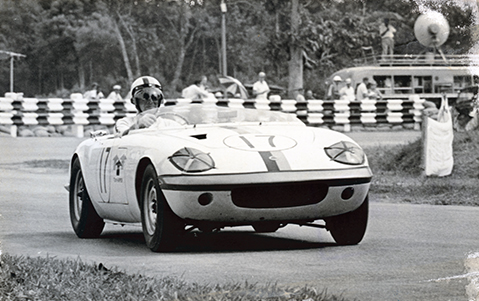
John Kirk in the Hong Kong Warner Elan, in Singapore in 1964. He finished second in the Macau Grand Prix that same year, a race which was won by Albert Poon in his Lotus 23. Of the 14 starters in Macau in 1964, eight were Lotus. The top four finishers were Lotus.
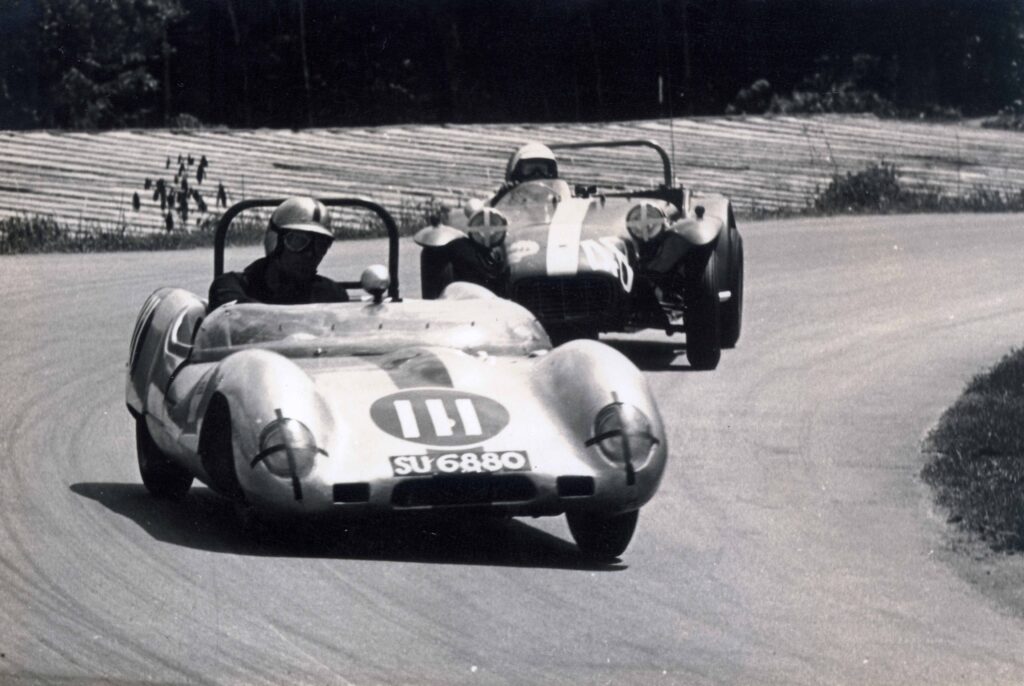
Major John Harwood was an active campaigner in the Singapore Grand Prix and in 1967, he raced this aged Lotus 17 (No.111) in the Sports and GT support race. What happened to the car following its disastrous crash in Singapore in 1968?
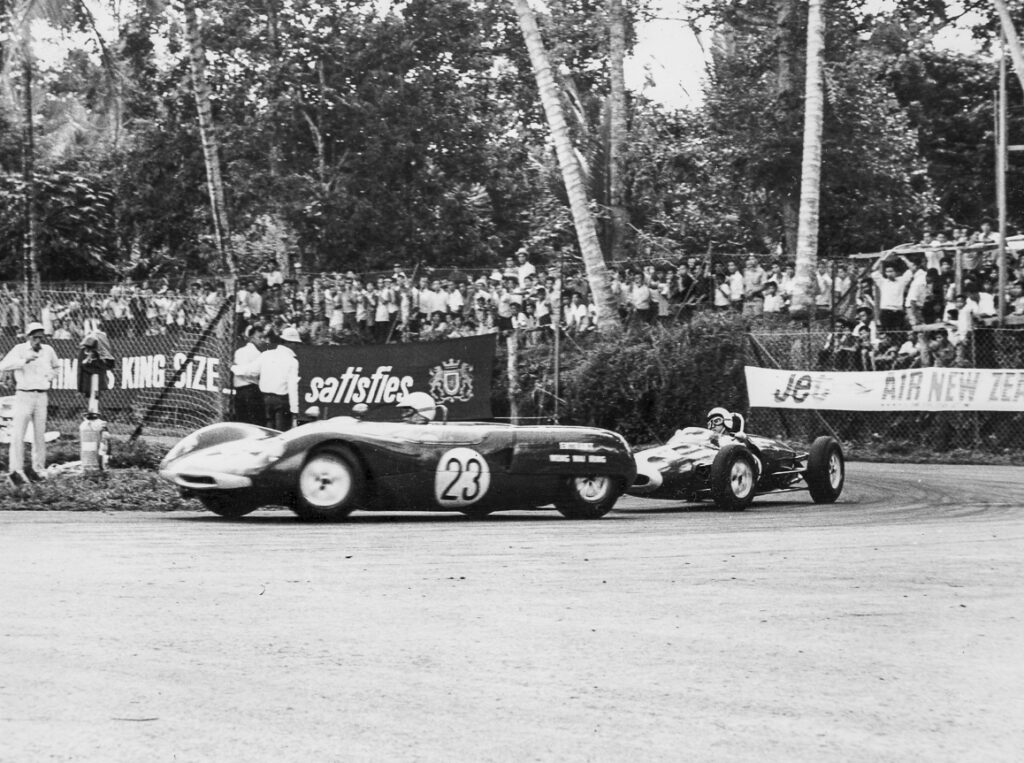
The 1965 Grand Prix (Singapore) winning car was back in action for the 1966 Singapore Grand Prix. Here Albert Poon leads eventual winner Lee Han Seng (Lotus 22) round Range Hairpin. Poon raced #23 because his backer Richard Wong was racing a Lotus Cortina bearing #69 in the Grand Prix.
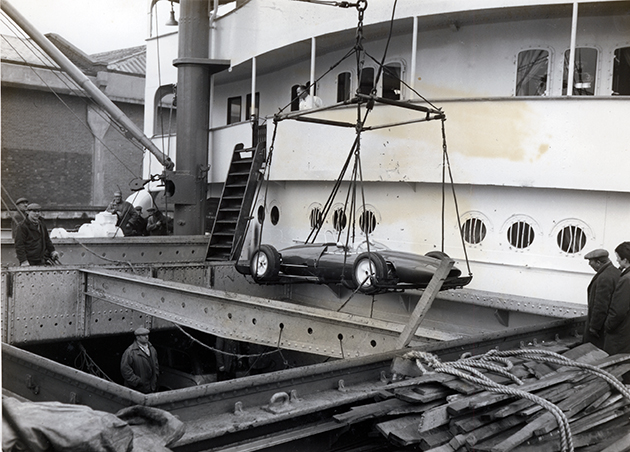
And this is how a Lotus 22 was shipped to Singapore in 1964.
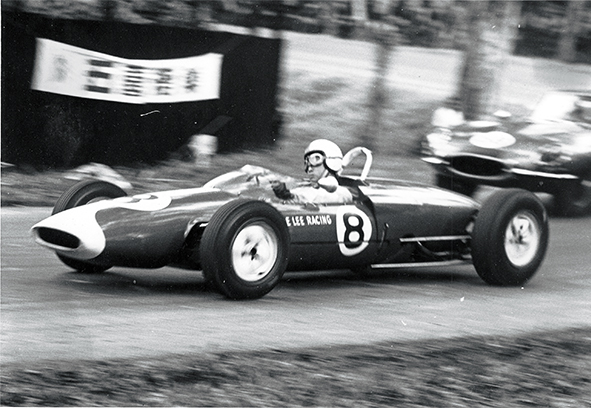
Lee Han Seng turned the tables on Albert Poon the following year and, although his Lotus 22 wasn’t a favourite for victory, pulled it off against the stiffest of opposition – Greg Cusack and his Brabham.
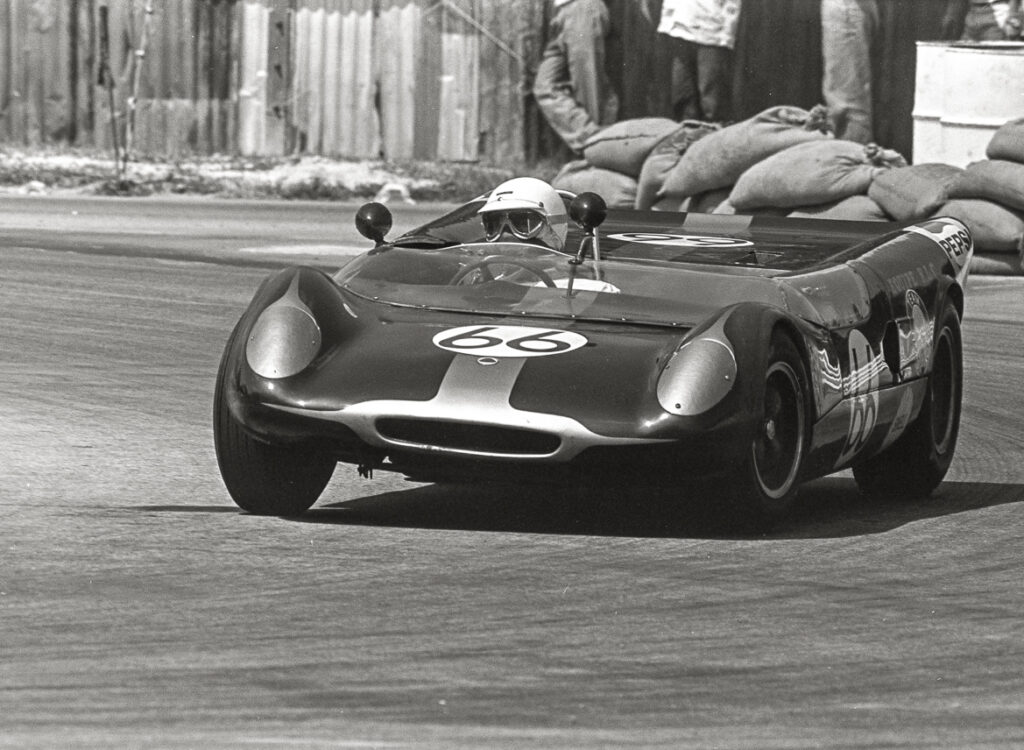
Backed by his friend L.C. Kwan’s Lotus 23 (with revised rear bodywork), Albert Poon returned to Singapore in 1967, the earlier 23B having been sold to Chong Boon Seng. This car raced with a 1.6-litre Alfa Romeo twin cam at the inaugural Batu Tiga Circuit Race in September 1967.
LOVELY TILL IT BLEW UP
While most top Asian competitors had embraced the single-seater, it took Macdonald a while longer to be convinced of the reliability of these fragile machines on the arduous race circuits of Johore, Macau and Singapore. Despite his win in the Lotus 18, Macdonald continued to believe in the viability and strength of sports cars over single-seaters. It was his sleek Lotus 30/40, with its flexing chassis mated to a thumping 4.7-litre Ford V8 at the rear, that was a categorical flop and the final straw for him that changed his mind.
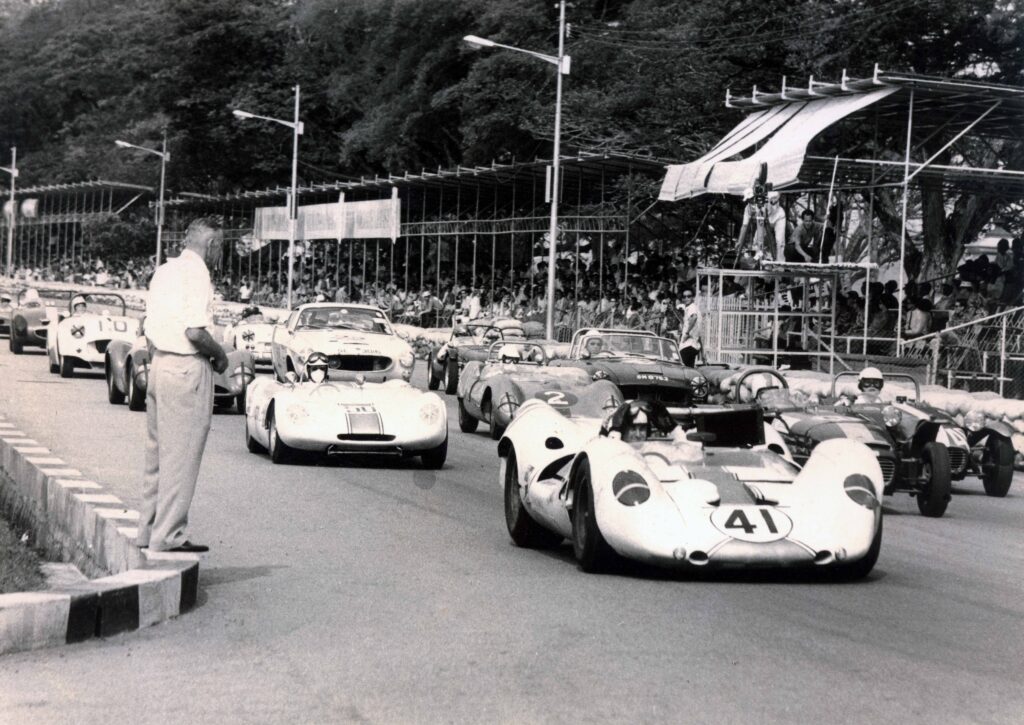
How many Lotus can you count in this photo? The Sports Cars race, 1967 Johore Grand Prix. #41 is John Macdonald in the Lotus 30/40. Peng Tsu Ying (No.48) is to the extreme right in his Lotus Super 7. Beside Peng is Lou de Marco’s Lotus Super 7 (No.61). Behind Macdonald are Hardy Burmester’s Team HK Lotus 23B (No.50) and Tan Keng Hian’s Lotus 17 (No.2). Behind Burmester is Jim Watkins’ Cooper Jaguar (see JUNGLE WARRIOR).
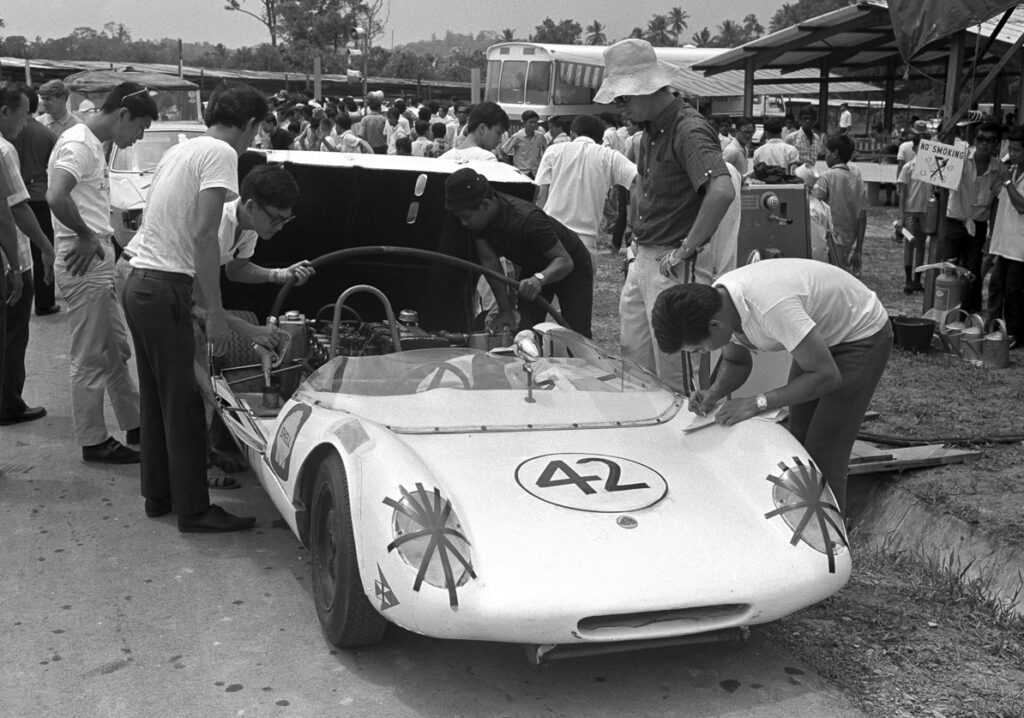
Another of the regular Team Harper Lotus 23 entries – Hardy Burmester’s car refuelling ahead of the 1969 Singapore Grand Prix. There were nine Hong Kong entries that year, led by Teddy Yip.
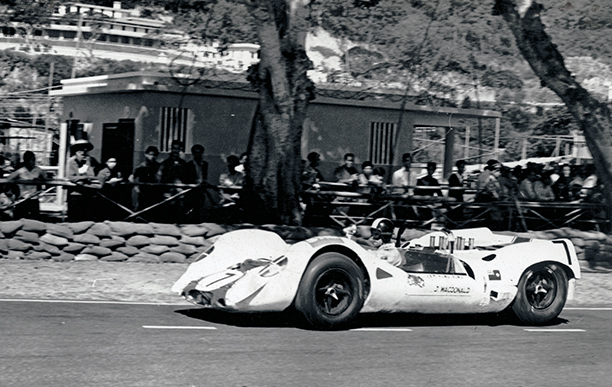
John Macdonald in the Lotus 30/40 – 1967 Macau Grand Prix. Macdonald started on the second row, alongside Jan Bussell (Brabham). He pulled out of the race on lap two, with terminal overheating. There’s a famous quote from him in Dr Philip Newsome’s book Colour & Noise: “Macau’s roads were obviously not in Colin Chapman’s min when he designed the car and it came apart just about everywhere, providing great excitement and plenty of terror.”
Always one with a turn for words, Macdonald concluded that the 30/40 was a “30 but with 10 more mistakes.” Still, he bagged pole for the 1967 Johore Grand Prix but recalled, “The motor was lovely till it blew up. You’d never believe the noise it made, but the rest of it was just made out of little bits of aluminium foil, typical Colin Chapman rubbish. A brake calliper tore clean away from the upright, which is why it expired in Johore in 1967.”
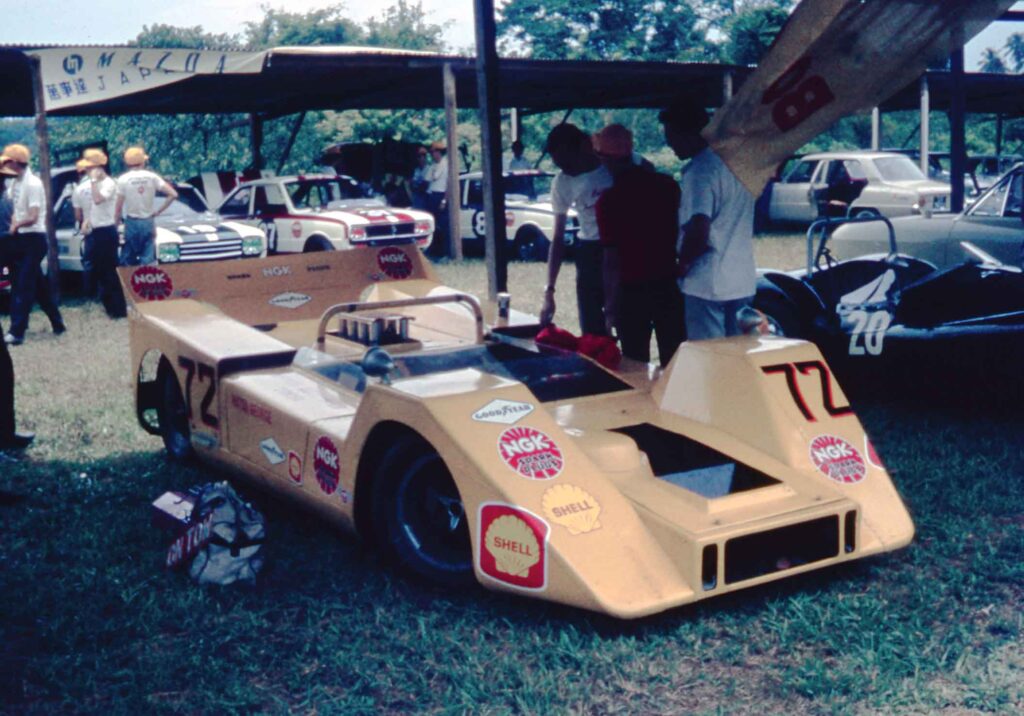
The ex-John Macdonald 30/40, following a Japanese makeover and back in Singapore for the 1969 Singapore Grand Prix. The car bore Serial Number 1122, and transmission number ZF 5DS20 Serial Number 51.
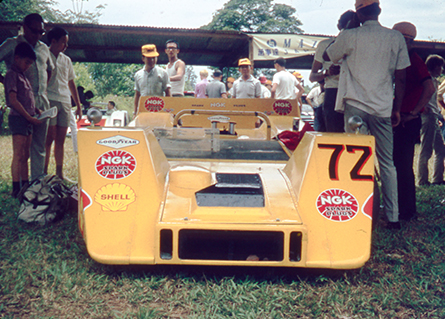
The IMAI A-1/RSC Cam-Am sports car that was once a Lotus 30/40.
The first chance he had, he unloaded the car, to the organiser of the Fuji 300 Yomiuri Asian Challenge Cup in Japan in March 1968. The Lotus 30/40 was reincarnated as the IMAI A-1/RSC Can-Am race car, in Japan. The rebodied car was later seen in the 1969 Singapore Grand Prix, entered by George Katsu, or as the Japanese knew him, Katsuomi Shiozawa. Macdonald remarked of the new body styling, “…thereby removing the only beautiful thing about it.”
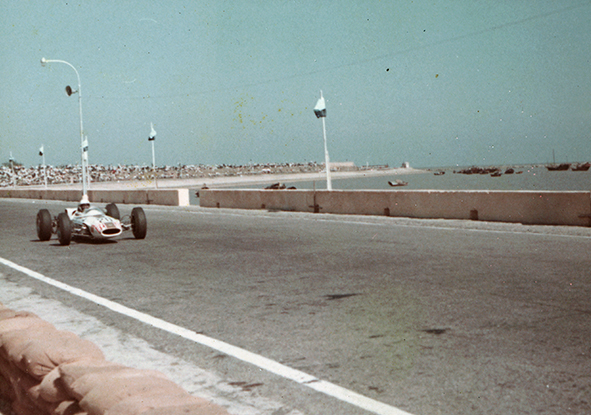
The starting grid for the 1967 Macau Grand Prix was dominated by Lotus cars with Steve Holland (pictured, No.20 Lotus 41) in third, alongside pole-sitter Peter Gaydon (T83 Cooper) and Albert Poon (Brabham BT21). The eventual winner was Tony May in the ex-Chan Lye Choon Lotus 20B. Of the recorded 16 starters, 10 were Lotus!
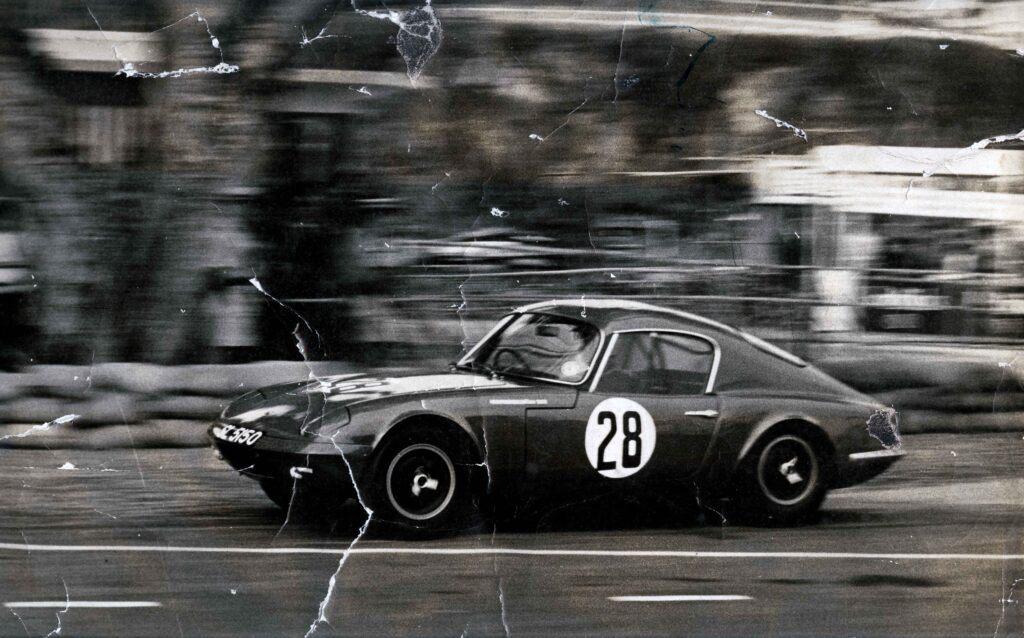
“Nothing could touch it,” said Rodney Seow of the very attractive Lotus Elan Shapecraft. Architect Stanley Leong bought the car to upstage Hong Kong-based Walter Haskamp’s Lotus Warner Elan in Singapore and Macau (pictured, from Macau in 1966). R26 bits were later installed. The car carried Singapore registration SL5150. The Shapecraft was eventually sold to Walter Haskamp sans trick Geo Wade cams that Rodney Seow had installed. It was later raced in Macau (painted white instead of red).
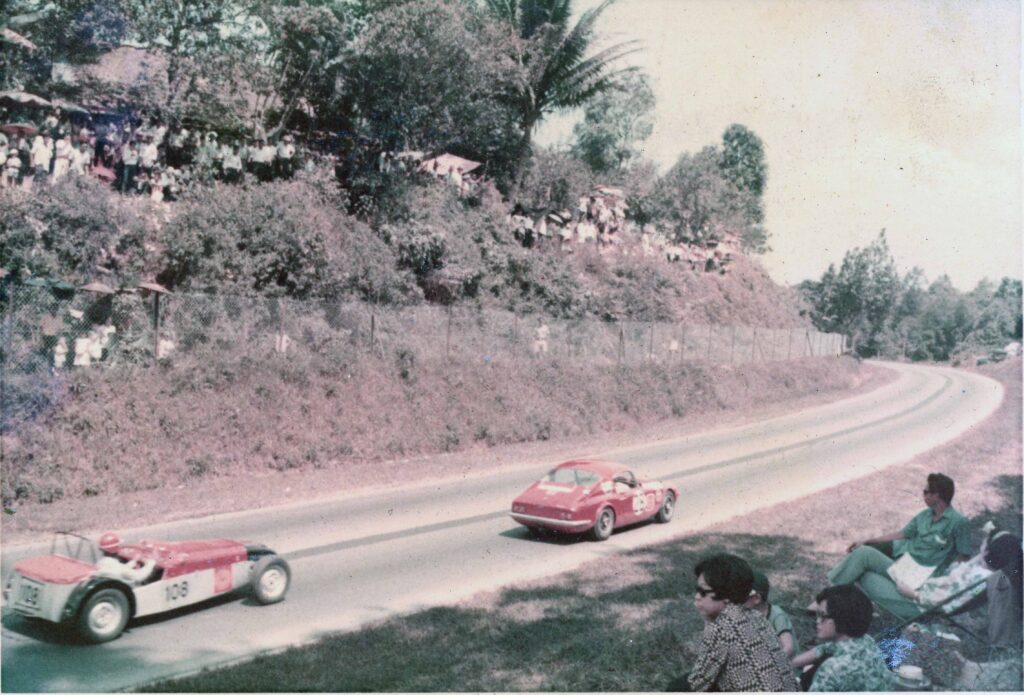
Two Lotus along Upper Thomson Road during the 1967 Singapore Grand Prix. . Nadarajah in a Lotus Super 7 attempts to keep up with the very rapid Lotus Elan Shapecraft of Stanley Leong in The Fraser & Neave Trophy Race for Sports and GT Cars over 15 laps. Neither car did well in Class 3 for 1301cc to 1600cc cars, a race that was entirely dominated by Lotus cars.
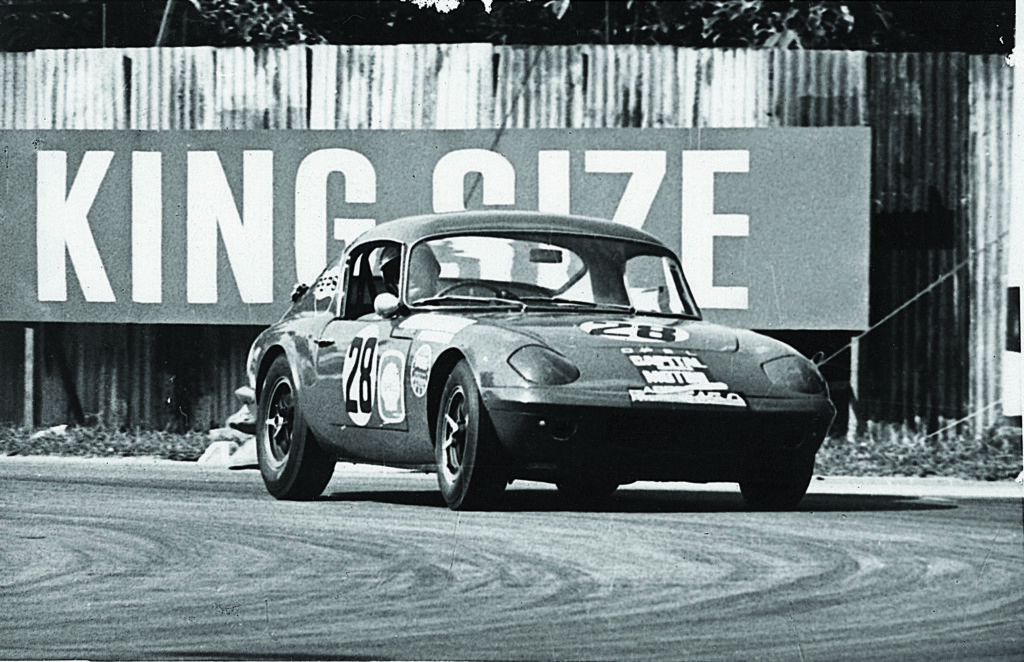
Stanley Leong’s road registered Lotus Elan Shapecraft had Lotus 26R racing parts fitted. The car is pictured in the Sports & GT Support race to the 1967 Singapore Grand Prix. There were 11 Lotus entered in this race – including three Elans and four 23/23Bs.
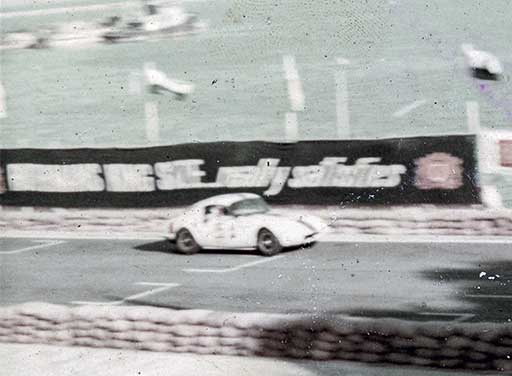
A very blurred image of what appears to be the ex-Stanley Leong Shapecraft Elan along the Macau straight in 1967, now in the ownership of Hong Kong’s Walter Haskamp. The Grand Prix itself was better known for the tragic crash that took the life of Dodjie Laurel (Lotus 41).
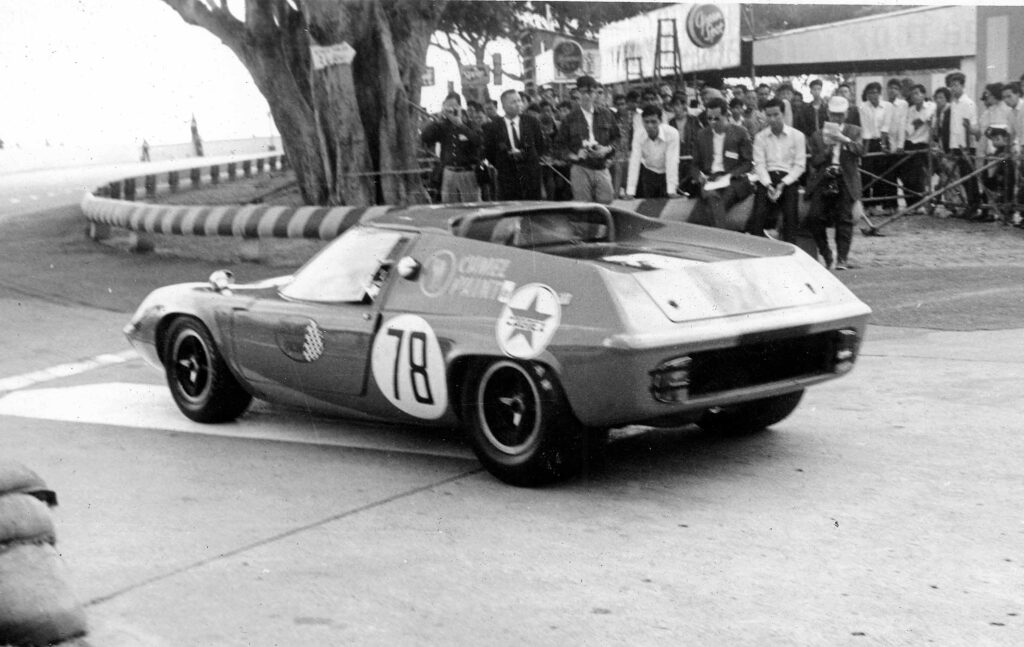
Shomac Time! John Macdonald’s Lotus 47 was an ex-Harper Hong Kong car with a twin-cam motor running Tecalmet-Jackson fuel injection. The car was first raced by Steve Holland. Chassis 47-GT-63’s debut in a major race was at the 1968 Singapore Grand Prix. After a gruelling 182 miles of racing, Australian Garrie Cooper took the chequered flag in his Elfin 600 Twin Cam. In third was Steve Holland in this Team Harper Lotus 47, an amazing result for a sports car. With a Cosworth FVA motor, Macdonald turned it into an even more potent entry in the Sports & GT class around the region, winning consistently, or catching fire when it didn’t.
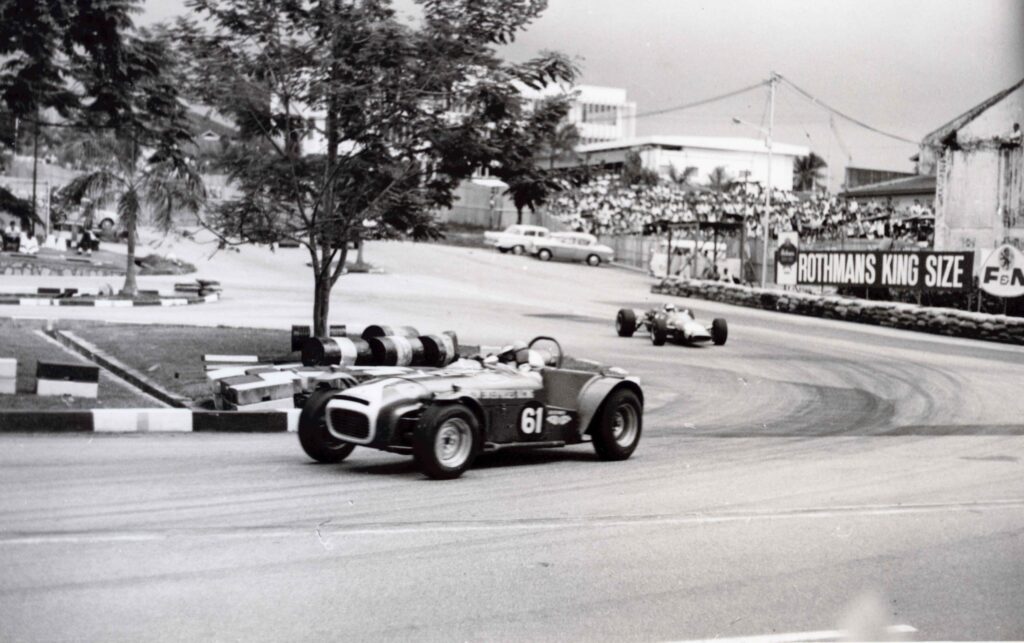
Malcolm Lou de Marco, on his way to winning the 1968 Johore Grand Prix in the ex-Jane Hadderly Singapore-assembled Lotus Super 7. This car was one of the earliest Sevens to arrive in kit form and be assembled in Singapore. Universal Cars Limited took delivery of three in kit form in late 1965. Selling price of the assembled car was S$8,080, only fractionally more expensive than the kit package. Hadderly’s green/yellow car had a metal tonneau cover, rollover hoop, oil cooler, a 1650cc motor with Cosworth pistons, A3 cam and, 10.5:1 compression ratio.
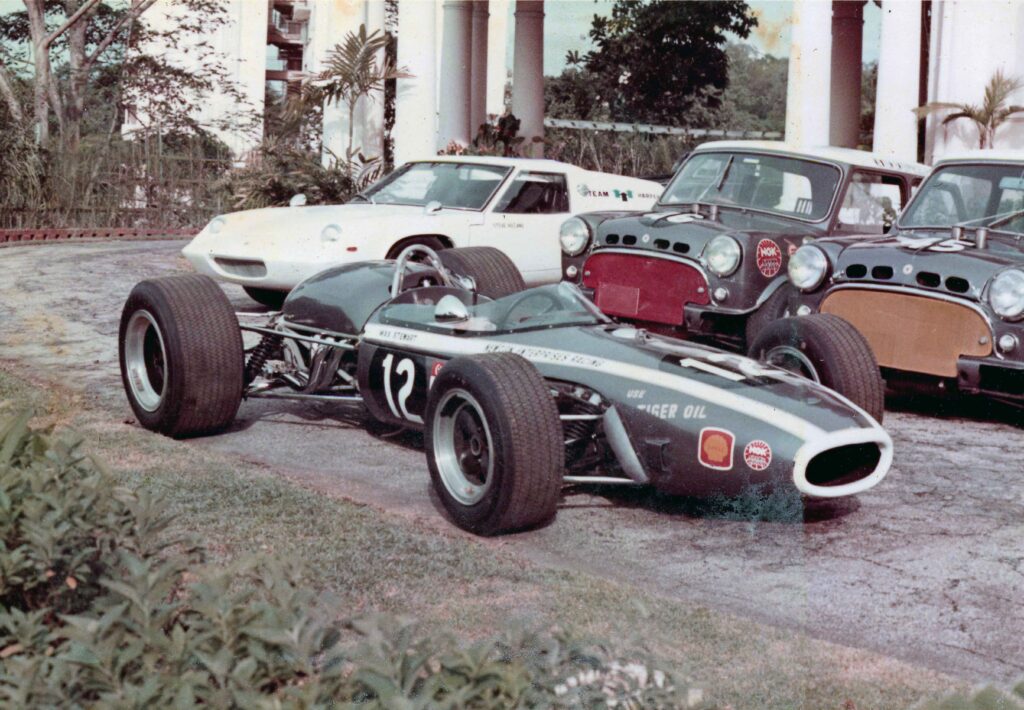
Team Harper’s Lotus 47 Twin Cam, parked at Cairnhill in Singapore, alongside Wong Peng Hong’s trio of Mini Coopers and the Brabham BT11 Intercontinental, September 1968.
There were numerous reasons why the success of the Lotus sports racers in Asia did not carry over into its single-seaters in the latter half of the 1960s. Chapman’s priorities were changing rapidly. The Chestnut operation had been moved to a big facility in Norfolk as the production car business kept growing. In January 1969, Group Lotus Cars went public on the London Stock Exchange (Team Lotus, Chapman’s race team, would remain privately-owned) and Chapman became a millionaire, on paper. To focus on commercial car production and Formula 1, production of customer racing cars under Lotus Racing ceased in 1971. Many new race car constructors had also emerged, supplying their cars to budding talent all around the world. Although Formula 1 was a tiny part of Lotus’ activities, it was the success of Lotus in top-flight racing that made its production cars popular. Chapman was no longer interested in supplying cars to privateers.
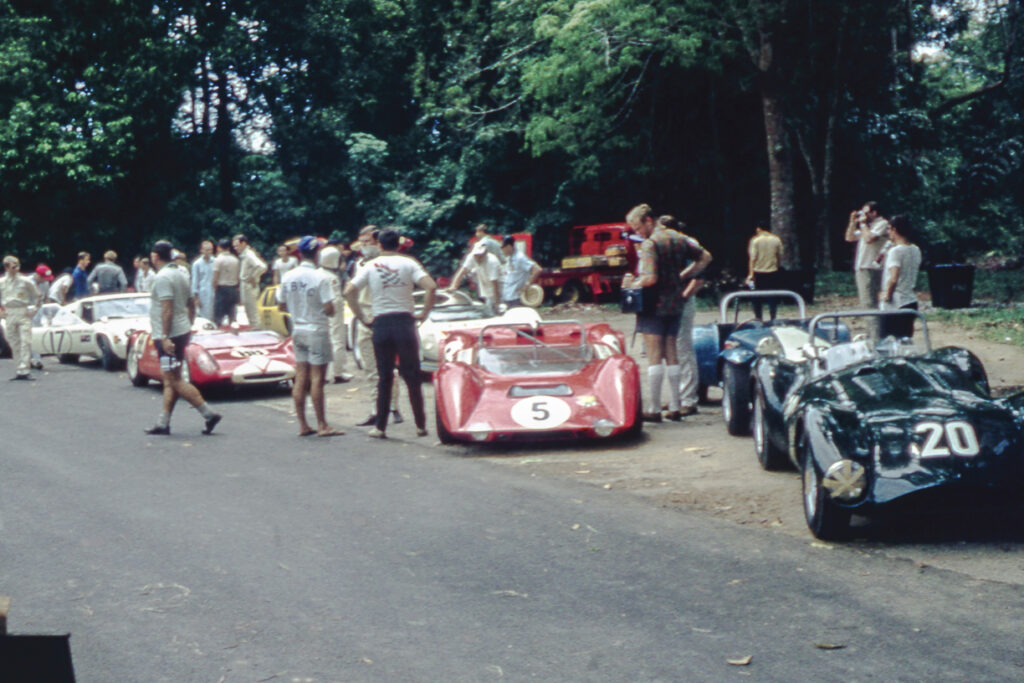
Steven Kam with the ex-Lee Han Seng Lotus 23B (#88) in the paddock area for Sports and GT cars at the 1969 Singapore Grand Prix. R to L: Cooper Jaguar, Elfin 300, Lotus 23B, Team Hong Kong-entered Lotus 47.
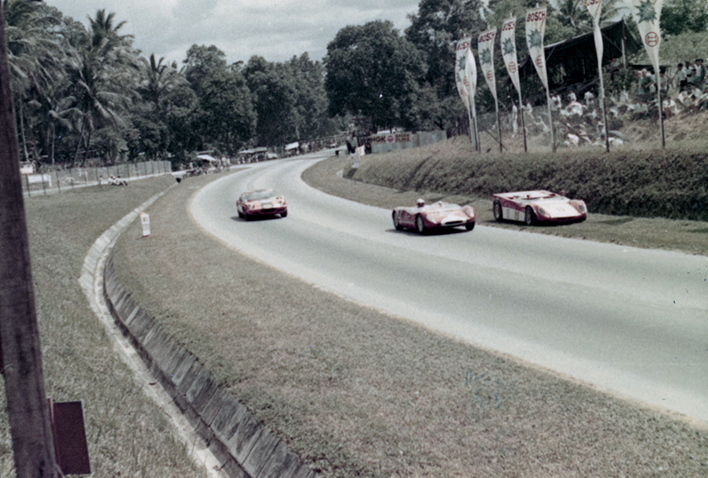
Three Lotus on Upper Thomson Road in Singapore, circa 1970. John Macdonald’s Lotus 47 is about to overtake the Lotus 23B of Steven Kam’s 1594cc #88 Lotus 23B (the ex-Lee Han Seng 23B). Chong Boon Seng’s rebodied ex-Albert Poon/Richard Wong 23B lays motionless by the side of the circuit.
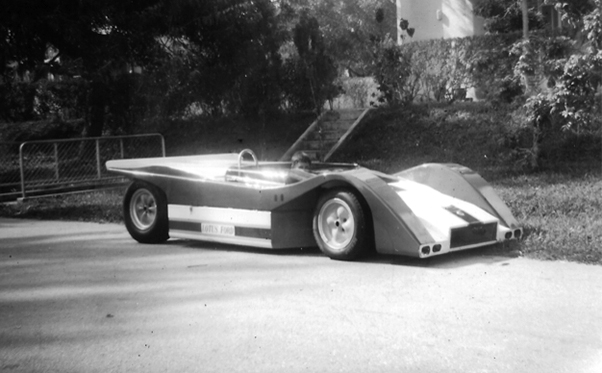
The ex-Albert Poon/Chong Boon Seng Lotus 23B outside Ian Boughton’s house at Tengah Airbase in 1971. Young Brett Boughton (age 10 yrs) can be seen in passenger’s seat of the rebodied all-Aluminium car. The car was being readied for the Gap Hill Climb.
Yet there were other interesting Lotus single-seaters that came to our shores as the racing series hotted up to include top regional drivers and sponsorship. Three Lotus 41 Formula 3 cars competed in South East Asia and Macau in the mid-to-late 1960s – one with Steve Holland, the other with Chong Boon Seng. Tragically, Filipino Dodjie Laurel lost his life in a fiery inferno when his Lotus 41 came to grief at Macau in 1967; Malaysian-based Tony Maw won the race in his aged ex-Chan Lye Choon Lotus 20 single-seater. The late 1960s eventually saw a shift of interest to the more robustly-built Brabhams and Brabham-derivatives.
THE LESSER KNOWN CARS
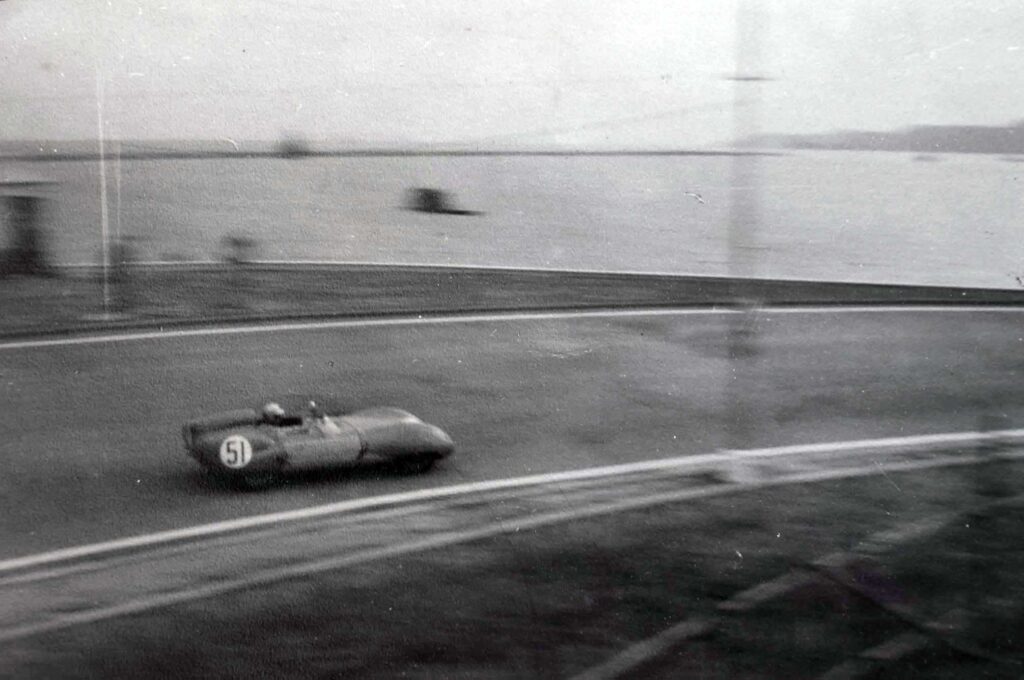
Martin Redfern, Gilman Motors’ Service Manager in Hong Kong, raced his Lotus Eleven in the Macau ACP Trophy Race (30 laps) in November 1962. The car was retired after five laps with a blown head gasket. Not much is known of this car.
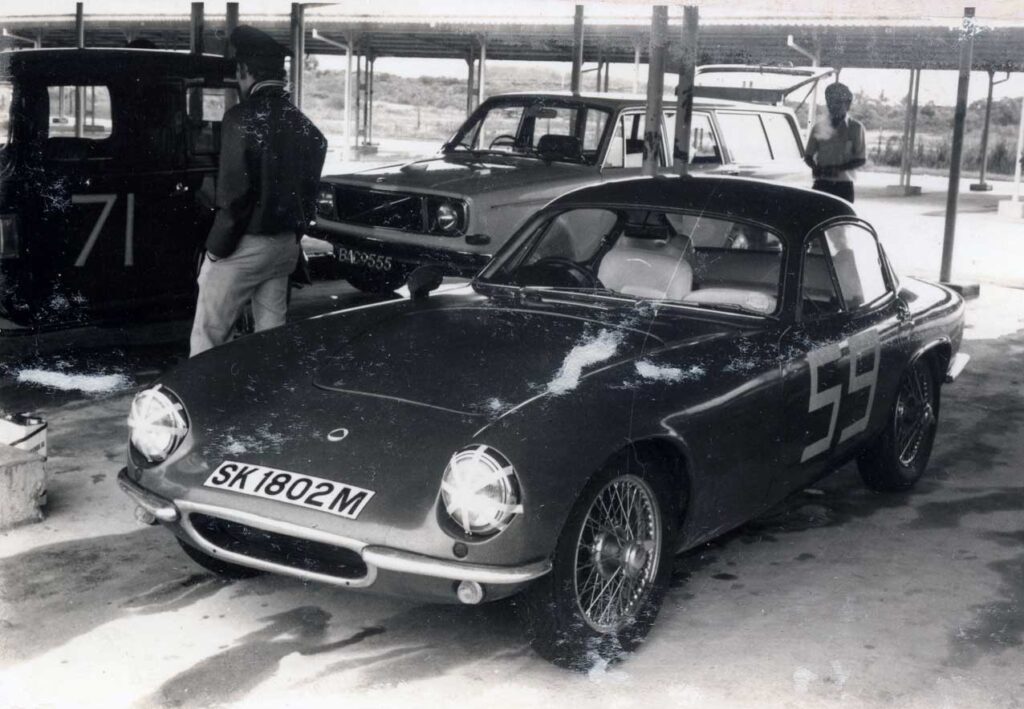
The ones that got away…Here’s one of an Elite owned by Larry Lim, at the Batu Tiga/Shah Alam circuit. Undated.
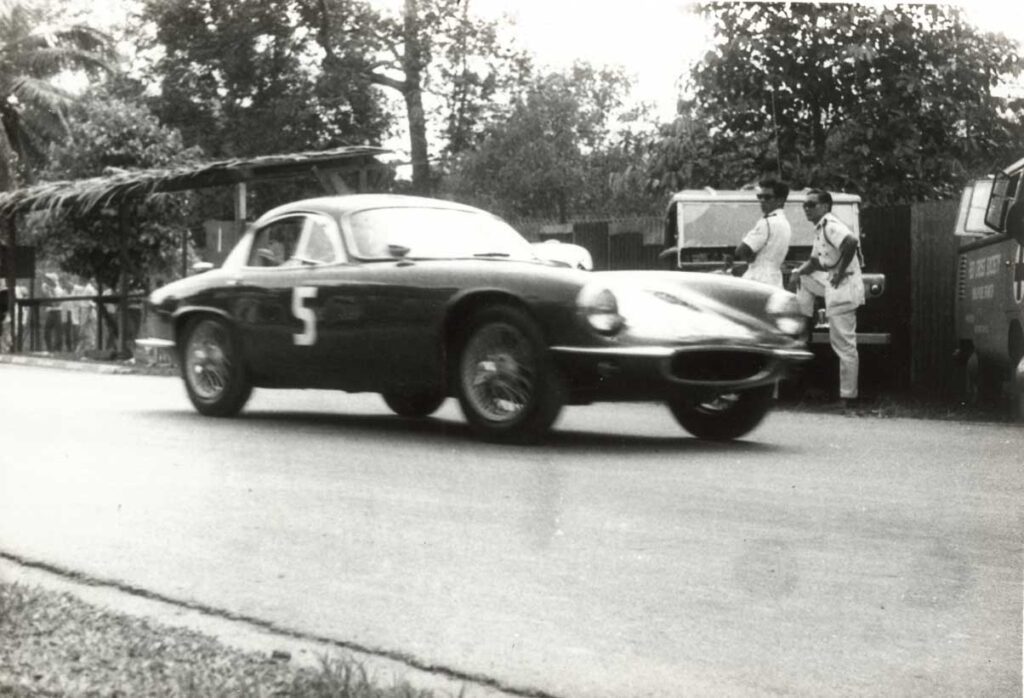
Reg Grey’s Elite in Singapore in 1963. Could this have been the Larry Lim car pictured above?
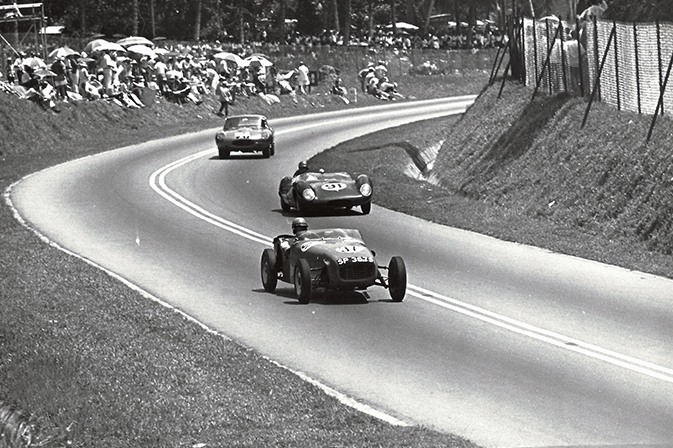
Another little known Seven – #37, Peter A. Leonard’s 1340cc Seven, road registered SP3679. Grand Prix in Singapore, April 1963.
SALOON LOTUS
I’m just am amateur historian delving into the history of cars in a region dominated by many knowledgable Singaporean experts. The mere mention of the Lotus Cortina in Singapore by an amateur will get the experts riled and ready to pounce with their wealth of expertise on every Lotus Cortina ever to grace the Batu Tiga, Johore, Penang and Singapore roads. So it’s with some trepidation that I even dare to mention the existence of this model in the region in the 1960s. In fact, By 1965, Ford was actually assembling 16 models of cars at their Bukit Timah assembly centre, from the Anglia to the Consul and the Cortina, although production capacity was a mere 13 units a day (with overtime they were able to push the figure up to 18 units a day). Also, by December 1963, Universal Cars had been appointed distributors for Lotus Cars in Malaysia/Singapore, taking over from the unsuccessful attempt at Lotus distribution by Singapore company Eastern Auto. The first shipments of cars arrived in December 1963 – Lotus Elan 1500 Sports (net price S$11,500).
Now let’s look at the first time Lotus Cortinas appear in a Grand Prix program – in Singapore. That would have been 1964, the year the main race was red-flagged due to calamitous weather. But for the Saloons & Tourers race, there were three Lotus Cortinas entered – Albert Poon’s, Bill Wyllie’s (both with 1598cc twin cams), and William Wong’s (presumably Richard Wong’s brother). Wyllie finished first overall, Poon finished second, but set FTD (2 min 36.2 sec). Third was Dick Clinkard in Endeavour, his 3.8-litre Mk2 Jaguar. Then there was also Len Gibson’s Willment Cortina GT (which in fact may have belonged to local retailer Jopie Ong).
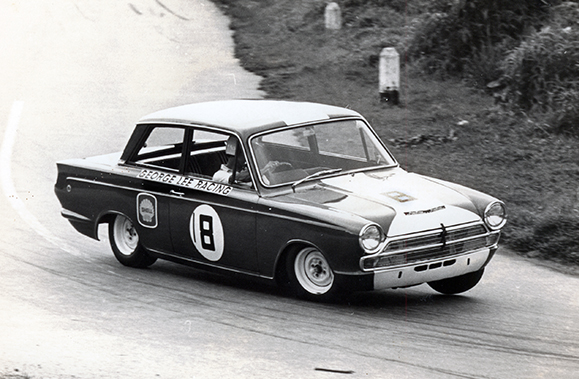
Lee Han Seng’s Lotus Cortina may actually have been an ex-works car (the fuel filler was behind the rear windscreen) – Singapore’s Lotus/Cortina racing gurus will surely know the chassis number, engine specs and full racing history…and probably whereabouts of the car today.
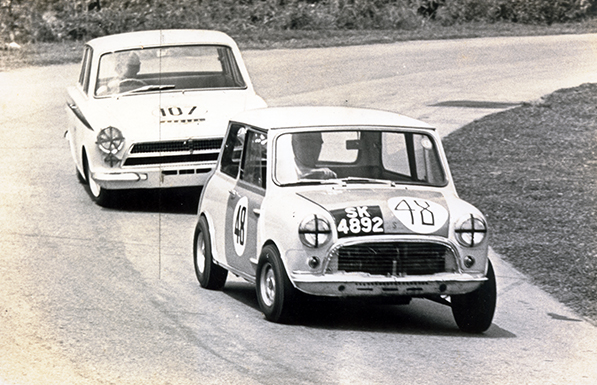
Albert Poon in the Richard Wong-entered Lotus Cortina Twin Cam about to lap Peng Tsu Ying’s 1-litre Mini Cooper during the Saloon & Tourer race of the 1965 Singapore Grand Prix.
Two names show up when it comes to Lotus and Cortinas. The first is Richard Wong and the #107 Cortina, the second is Lee Han Seng and his #8 Cortina. For good measure, let’s throw in a third – the Dick Clinkard factory-prepared Lotus Cortina. In 1966 Clinkard’s brought in a factory-prepared Lotus Cortina with Stage 4 BRM Ford Twin-cam rated at 175bhp at 7500rpm. The car was built to special order by Lotus in 1966 with an all-steel block, dry sump lubrication, adjustable leaf spring rear suspension, lightweight body with aluminium door panels, bonnet and boot lids, perspex windows, limited slip diff, 25 gallon gas tank, three axle ratios and Hewland LSD. It was road registered SM8339 in Singapore. Whether any were ex-Works I can’t tell, except that in Lee Han Seng’s car, the fuel filler was directly behind the rear windscreen. And Lee (and George Lee Racing) wasn’t into buying run-of-the-mill Fords for racing, nor was Clinkard. Nor, it seems, was Richard Wong. The local experts will have a better handle on the saloon cars that raced in Asia.
END OF THE ROAD
There were nevertheless exceptions to Lotus racing cars in Asia in the early 1970s. Local hero Sonny Rajah brought in a Lotus 69, touted as the ex-James Hunt Formula 3 Lotus 59, in 1971. It should have demolished the aging Brabhams, Mildrens and Elfins and taken the fight to the Ralts and Marchs in Selangor and Singapore, but it did not. It should have won at Macau in 1971, but a crash while in a commanding lead thwarted Sonny’s efforts. The car was unceremoniously packed into a crate at the Macau Naval Dockyard and shipped off, never to be raced in Asia again. There were another two 69s that raced in Asia subsequently – Kenny Smith won the 1971 Penang Circuit Races in one; John Dimsdale raced another in the 1972 Macau Grand Prix. The Dimsdale car, though damaged in Macau, was purchased by Malaysian Percy Chan and rebuilt in Kuala Lumpur, by Dimsdale’s former race engineer, Michael Jackson.
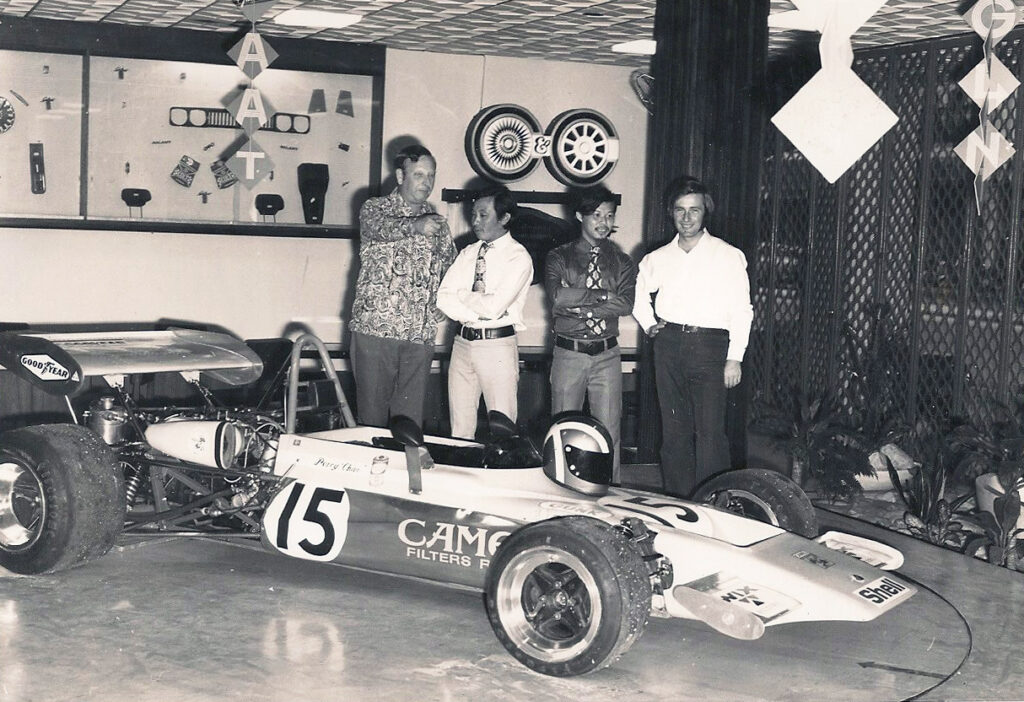
The ex-Johnny Dimsdale Lotus 69, rebuilt in Kuala Lumpur by Michael Jackson and proudly displayed at the Cycle & Carriage showroom. Pictured are the Camel Malindo team of (L to R) Harvey Simon, Sonny Soh and Percy Chan. Michael Jackson is on the extreme right of the photo.
With the exception of the twin-cam 69s, no other Lotus single-seaters or sports cars participated in modern motor sports in South East Asia from the mid-1970s. By 1974, Lotus was no longer involved in racing outside of Formula 1, the company clearly focused on road cars as its core business and the Formula 1 organisation under Team Lotus a separate entity to the car business.
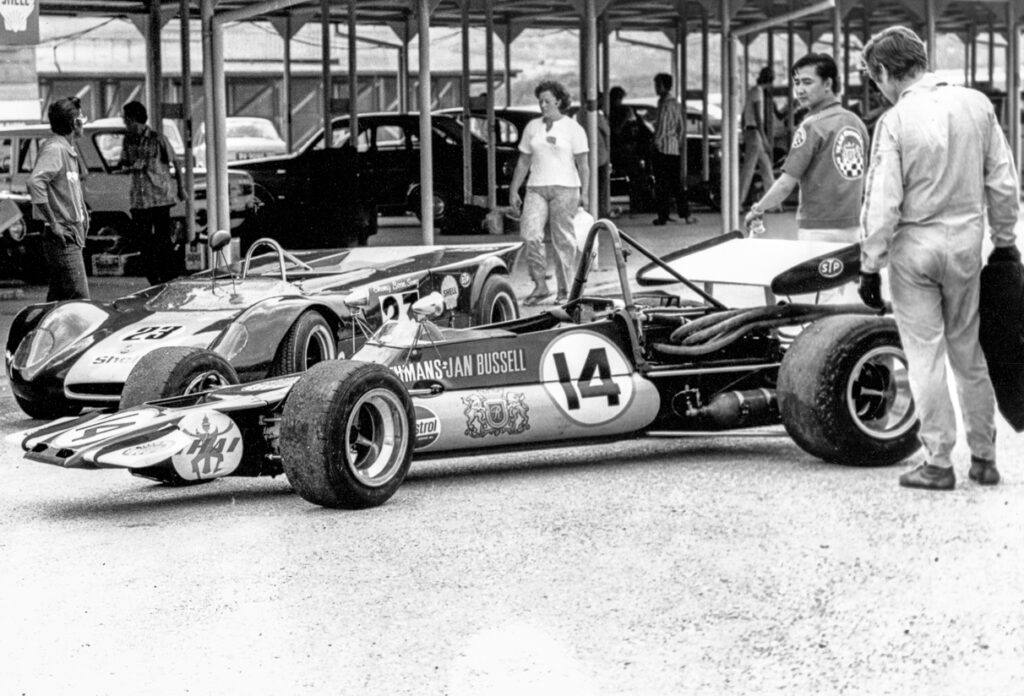
The ex-1965 Singapore Grand Prix-winning Lotus 23B during practice day at Shah Alam ahead of the 1972 Selangor Grand Prix……rebodied but still immaculately presented. In the foreground is Jan Bussell and his Palliser WDB3.
When Chapman died of a sudden and unexpected heart attack in December 1982, the spirit behind the brand nearly snapped. Lotus was a spent force, mired in controversy over the DeLorean debacle that resulted in Chapman’s long-serving accountant Fred Bushell going to jail. The prevailing Judge, Lord Justice Murray, concluded that had Chapman been alive, he would have been incarcerated for “at least 10 years.”
For a garagiste, Lotus had done exceedingly well. The company had built sports cars to Indy cars, endurance racers, Formula 2, Formula 3, Formula Ford, Formula Atlantic, Formula 5000, performance engines and even tried to reengineer the way boats were built. Colin Chapman, thinker, mover, shaker and maverick, was part of the original “Piranha Club” that controlled Formula 1 in the 1960s and 1970s.
Few know that Lotus was the most successful racing marque in Asia during the 1960s. While the joke that the name stood for “Lots Of Trouble, Usually Serious” had a ring of truth about it, the fact remains that Lotus cars bagged no less than 45 wins in various categories of circuit racing in Macau, Malaysia and Singapore in the 1960s and 1970s. Perhaps it ought to read, “Lots of Trouble, Usually Successful”.
APPENDIX 1 – The Tall Lotuser
Think tall Lotuser and you instantly think of racer and former Team Lotus’ Formula 1 manager (and Walter Wolf Racing and Fittipaldi Automotive) Peter Warr. Warr won the first Japanese Grand Prix (Suzuka) in a Lotus 23B sports racer in 1963. But there were other tall Lotus drivers, one of whom was six-feet-six Bangkok-based Edward Peter Heath.
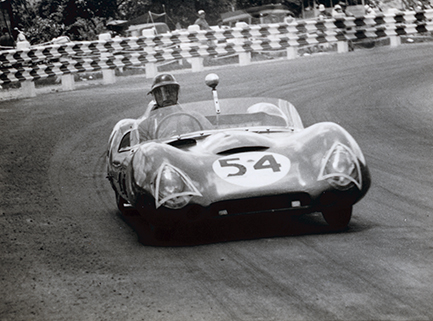
Peter Heath exits Peak Bend in his Lotus 15 – Grand Prix in Singapore, 1962. This was the ex-Innes Ireland 1959 works Lotus 15 Series 3 (chassis 620-3) that Ireland had originally assembled using a 1½-litre Coventry Climax FPF engine and a ZF 4-speed close-ratio gearbox. The Lotus 15 was shipped to Hong Kong in time for the 1961 Macau Grand Prix where Heath started from the second row and went on to win the race.
Heath’s height may have been fine for sports car racing because a competent welder would have been able to reconfigure a Lotus sports car spaceframe to suit anyone. However, shoehorning a six-and-a-half-footer into a Lotus 12, 16 or 18 single-seater was another matter entirely. But I digress.
From 1934, Edward Peter Heath (6 June 1914 – 12 January 2003), a motor sports enthusiast, oversaw the Borneo Company and later, Inchcape Group’s Bangkok operations after the Borneo Company was absorbed into the Inchcape Group. He rose to the rank of Deputy Chairman of Inchcape PLC before retiring.
His frequent trips back to the UK allowed him to attend British Automobile Racing Club meetings, occasionally as part of Innes Ireland Ltd, legendary Lotus racer Innes Ireland’s race preparation business that operated out of a garage at Farnham. Ireland’s team looked after the Lotus Elevens of several owner-drivers, one of whom included the Bangkok-based business executive. Records show his Lotus Eleven entered at the 26th July 1958 Mid-Cheshire Motor Club’s Oulton Park meet for Formula Libre cars with a Coventry Climax FWA 1098cc motor, race number #53. He was slated to race at a race at Oulton Park on 20th September 1958 for the Mid-Cheshire Motor Club’s International Race Meeting but may not have attended. The Eleven, Chassis 522 (FWA engine 7749) was then shipped home to Bangkok in 1960 by 46-year-old Heath.
The Eleven was then shipped to Singapore from Bangkok for the 1960 Johore Coronation Grand Prix held 20-21 February around the streets of Johore Bahru, a short distance from the causeway that linked the Malaysia with the island of Singapore. The car set FTD, but did not finish the race, not for want of trying.
That year 522 was entered in the Macau Grand Prix in November. Heath started from the back of the grid for the ACP Sports Cars race and overtook everyone to win the race. It may have won but its owner still felt it wasn’t fast enough. 522 was sold to Malaysian Saw Kim Thiat in September 1961, in time for the inaugural Singapore street Grand Prix, by which time he had acquired a Lotus 15 Climax.
The next big race the following year was the Malaysia Grand Prix in Singapore, held over Easter weekend. Heath was the only competitor from Thailand. The Sports and GT support race was a Lotus benefit, with Saw Kim Thiat, in his newly acquired ex-Heath Lotus Eleven, winning the class for the smaller engined cars while Heath took the win in the larger Sports and GT race in the 15. Neither was lucky in the Grand Prix.
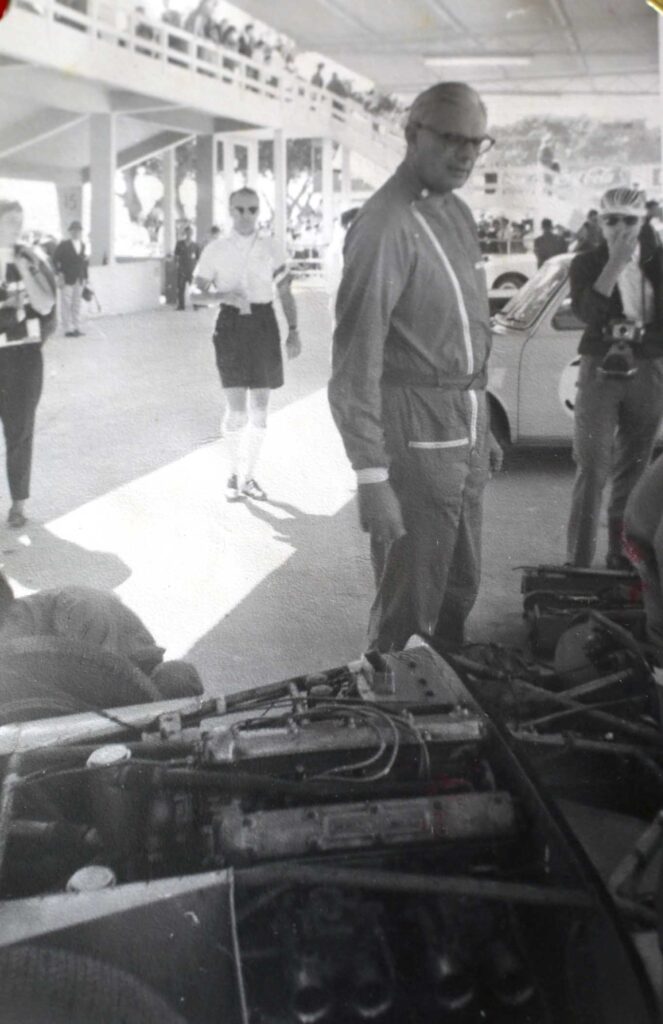
It’s not often we have a photo of engine and its driver – so this one’s special. Macau 1961 with Lotus 15 chassis 620 and its owner, Peter Heath.
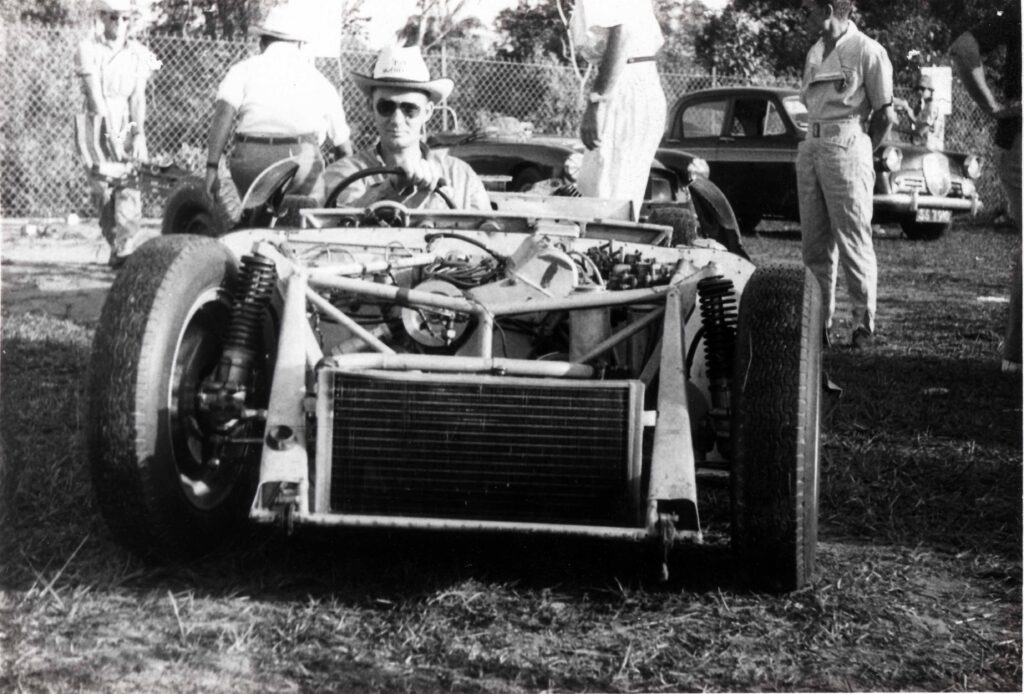
Peter Heath in his Lotus 15 sans bodywork in the paddock of the Upper Thomson Road Circuit in 1963. Or is that a single cam Climax motor? Which makes this the Eleven, rather than the 15.
Heath had already come to the conclusion that single-seaters were out of the question for him so Innes Ireland’s 1959 works Series 3 Lotus 15 (chassis 620-3) was acquired. It had a 1½-litre Coventry Climax FPF motor and a ZF S4-12 4-speed close-ratio transmission. Heath entered the in the BARC Goodwood Handicap race on 1st July 1961, racing for A.G. Whitehead. He followed up with a Handicap race on 22nd July 1961 at Phoenix Park. The car was also entered in the Grand Prix Pescara on 15th August 1961 in the round 5 of the World Sports Car Championship for Graham Whitehead but it appears two of the Whitehead cars did not arrive for the event.
The car was shipped to Hong Kong in time for the Macau Grand Prix of 1961. Yes, you guessed it. He won the Grand Prix in the No.10 car.
Following an unsuccessful attempt at a second Macau win in 1962, the 15 was left in Hong Kong for sale before being shipped down to Singapore, care of Borneo Motors. And guess who bought chassis 620? Kuala Lumpur-based Saw Kim Thiat. This, according to Saw, was only possible after much haggling that dragged on and on. Eventually, a deal with was struck at SGD8,000, which Heath finally accepted in early 1963. Saw now had a new mount for the 1963 Malaysia Grand Prix (which was held in Singapore). There must have been some serious padding put in so that the new owner could actually drive a car that had been configured for a six-and-a-half-foot man.
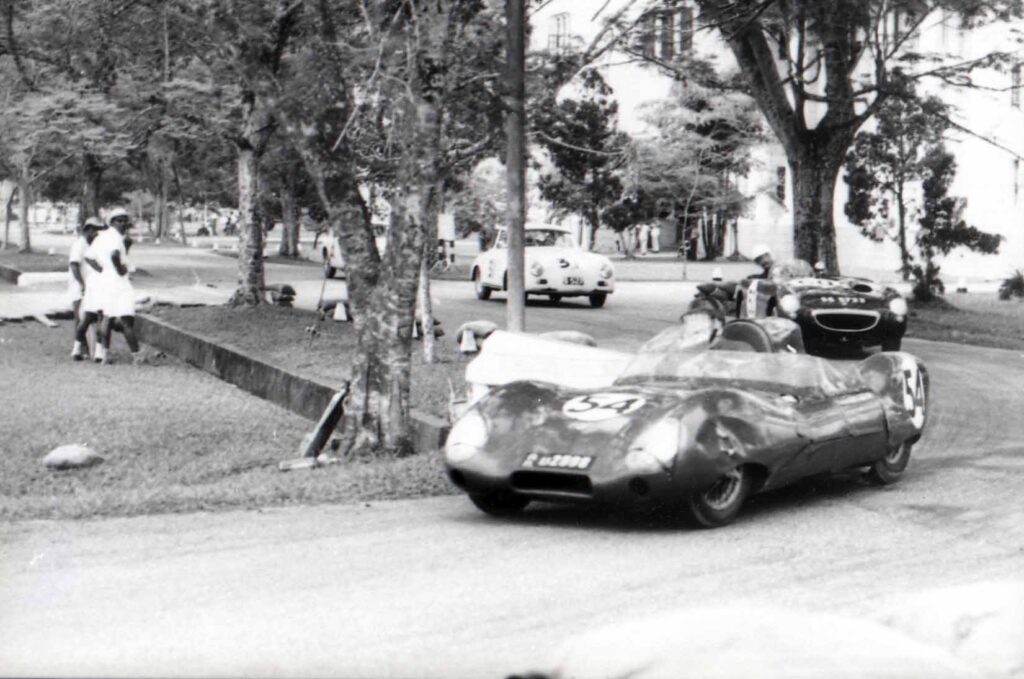
Peter Heath (No.54) and his Lotus Eleven had the pace on Bill Wyllie’s Auto Union until he overcooked it at Zoo on lap 43 and retired during the 1960 Grand Prix. He still set FTD, clearly showing what the Lotus Eleven was capable of. Trailing the Lotus is Peter Brown in his #50 Sprite and N.V. Knight in his Porsche.
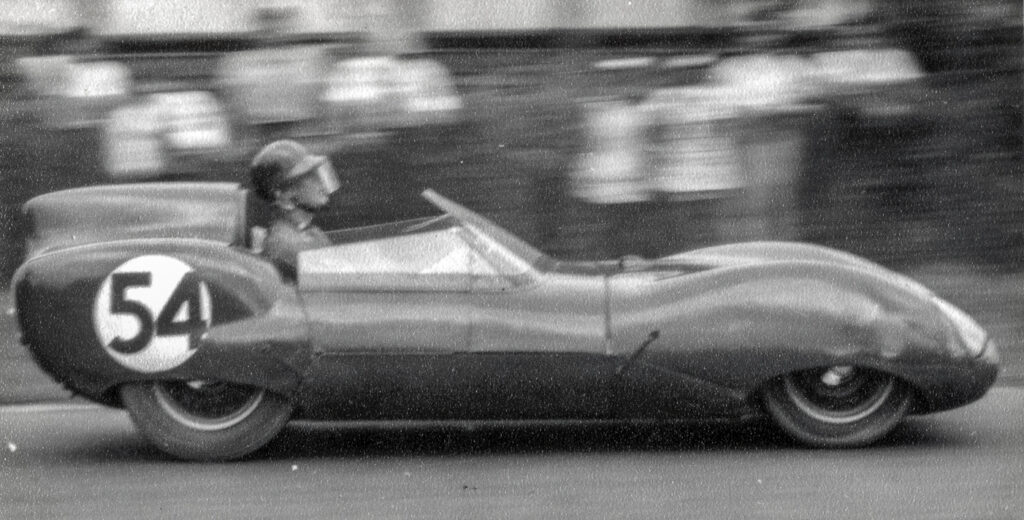
Peter Heath and his Lotus Eleven Climax. He raced the Eleven in Macau in 1959 and 1960, always running No.10, while in Malaysia and Singapore, it was No.54.
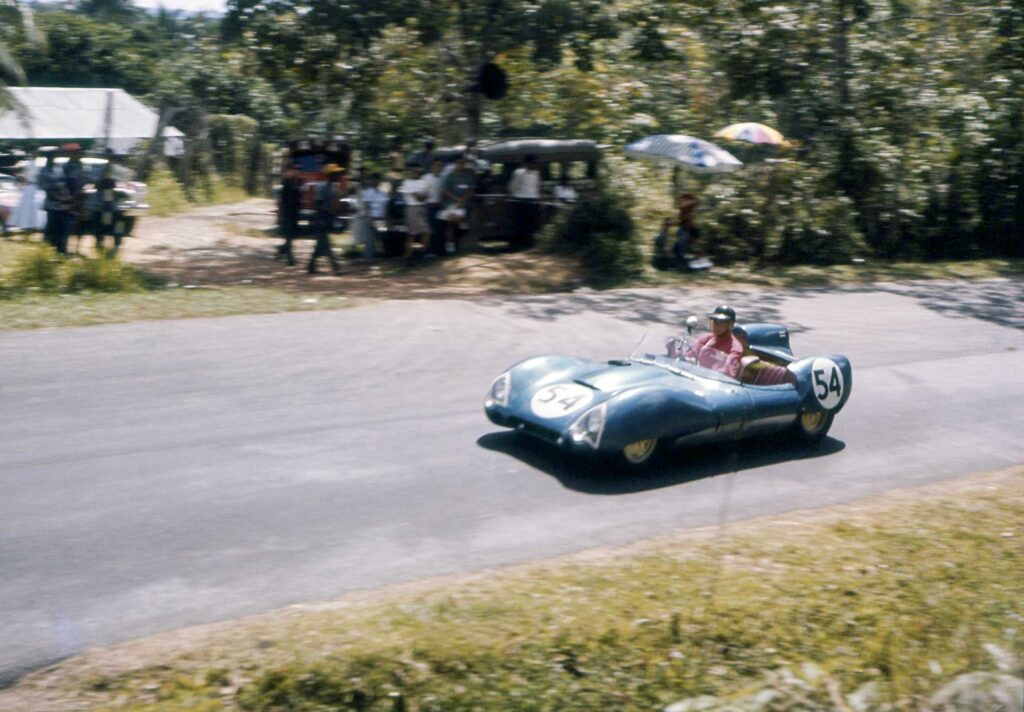
Peter Heath in his Lotus 15 Climax during the 1962 Grand Prix in Singapore.
What would steal the limelight for 1963 was the Jaguar versus Lotus battle on the grid. There were seven Jaguar E-types entered, twelve Lotus, and six big Healeys, for a total of 53 entries in the Grand Prix! The single-seaters may have arrived but the sports cars still ruled the roost. In the 10-lap Sport and GT car race, Saw finished half a lap ahead of his closest competitor, setting fastest time of day. The 15 had certainly made a name for itself in the shorter support races but was notoriously unreliable when it came to the longer Grand Prix races.
The 15 was still circulation in 1965, now owned by Saw’s friend Eddy Choong. It was entered in the 4th Tunku Abdul Rahman Circuit races held on 3rd and 4th July around a 2.85-mile course around the streets of Petaling Jaya. Clearly, the 15 and its Climax motor had seen better days.
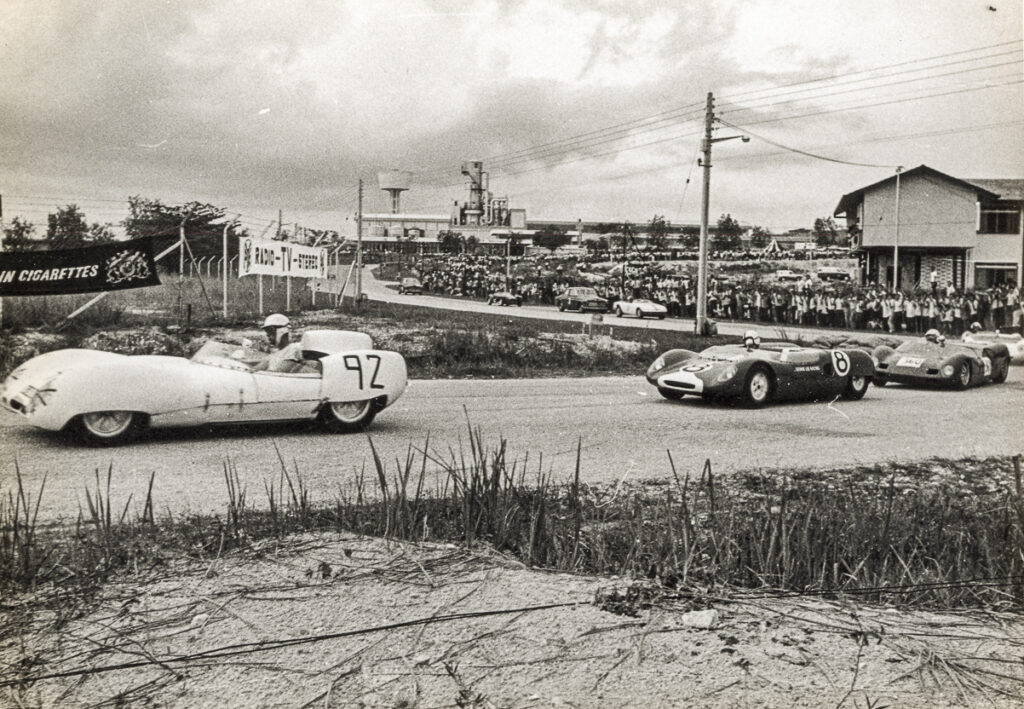
An eclectic gaggle of racing cars speed round Jalan University during the sport cars race at the Petaling Jaya Circuit in 1965. The circuit around the township was use for just two years before the organisers opted for a temporary track at Sungei Renggam prior to completion of the Batu Tiga permanent circuit. This event was the Fourth TAR Race and the last one held at PJ. The No.92 car is the ex-Peter HeathSaw Kim Thiat Lotus 15, run by badminton champion Eddy Choong. The Lotus 23B behind is that of Lee Han Seng. Behind the Lotus 23B is Hong Kong entry John Tse in an Elva Mk7 Climax. The car behind Tse is Alan Bond’s Lotus 23B with Chong Boon Seng in a Lotus Elan and Philip Seow in the Volvo B18 behind.
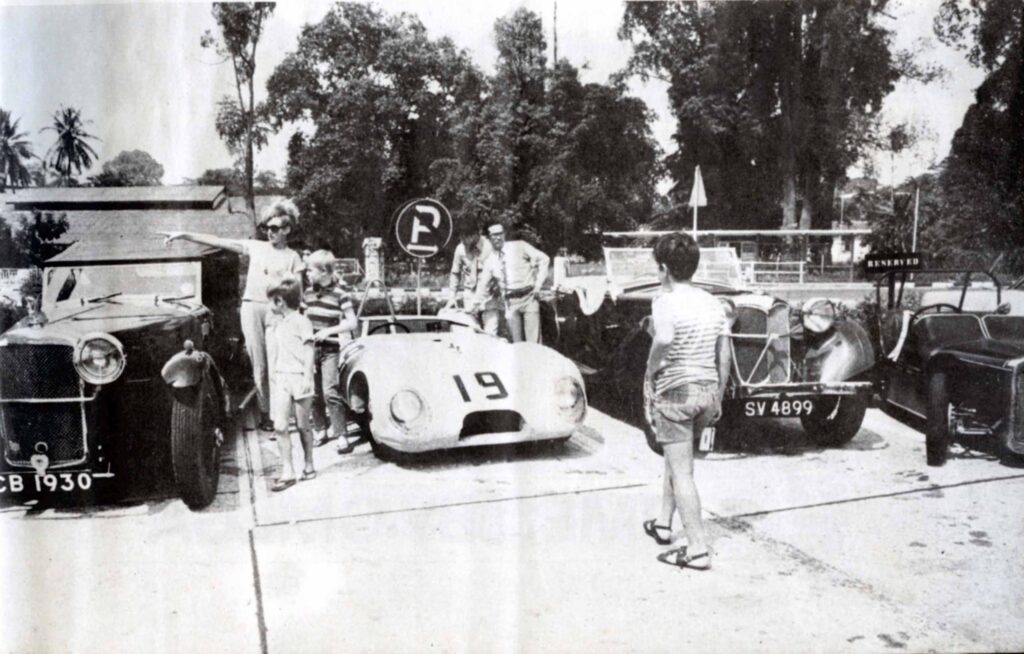
CB1930 – Alvis Speed Twenty SB (Henry Stonor); #19 – Ken Murchison, Lotus Eleven – possibly the ex-Saw Kim Thiat car – only the local Lotus experts will know the answer to this one. Singapore Grand Prix, 1972.
In the 1972 Sports & GT support race to the Singapore Grand Prix, new owner Brian Tyler entered it with a 1499cc motor, against such varied competition as the rebodied Albert Poon Lotus 23B (in the hands of Chong Boon Seng), Lola Mk1, Porsche 906, Daren GT Gp6 Prototype and new 240Z Datsuns in the Sports Cars race. The Lotus 15 disappeared from our radars after 1972. Its subsequent history back in Europe is explained in Bill Colson’s comprehensive article on its history in Historic Motor Racing magazine, Vol.1 No.3.
Heath continued to race, and following the sale of the Lotus 15, raced an Elva Courier and later on, a Diva Valkyr in the UK and in the Macau Grand Prix (1966).
Postscript: Heath was a managing director of Inchcape until 1975 and a deputy chairman 1976-79. He was also chairman of the Anglo-Thai Corporation.
APPENDIX 2 – The Ferratus
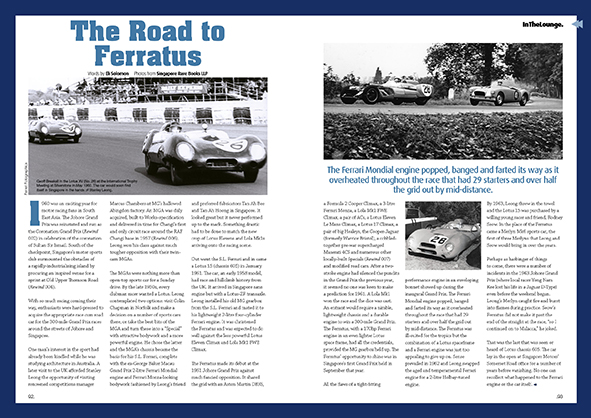
The Ferratus was featured in the print edition of Rewind Magazine, issue 012, October 2012.
In jest, it was nicknamed the Ferratus. In reality, it was a 1958 Lotus 15 (chassis 605), one of earliest 15s built, with a ‘laid-down’ Coventry Climax 1½-litre FPF engine. After a year of circuit racing, its second owner used it for hill climbs in the UK before Singapore architect Stanley Leong purchased it in January 1961 sans engine but with the Lotus-ZF transaxle. Leong installed his old MG gearbox (from his hybrid MGA-chassied S.L. Ferrari) and abandoned the idea of using a Holbay motor, deciding to go with the most exotic of engines instead.
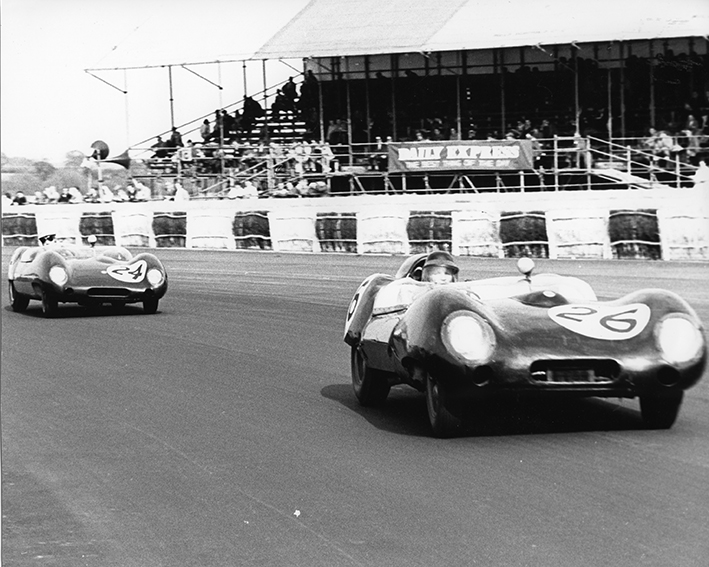
Geoff Breakall in the Lotus XV (No. 26) at the International Trophy Meeting at Silverstone in May 1960. The car soon find itself in Singapore, in the hands of architect Stanley Leong.
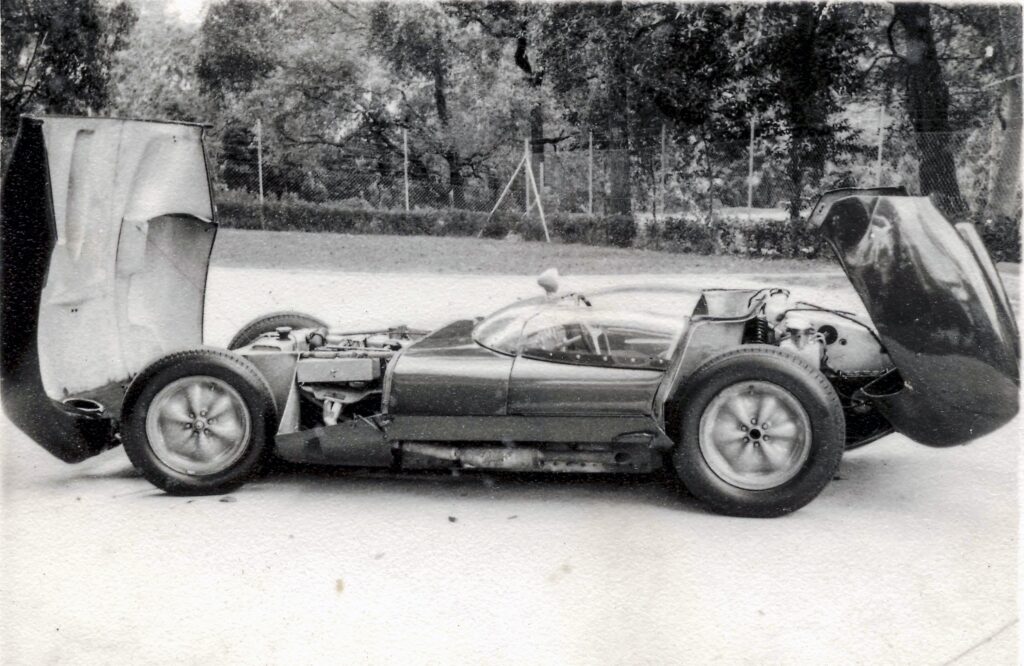
The Stanley Leong Lotus 15, with Holbay motor.
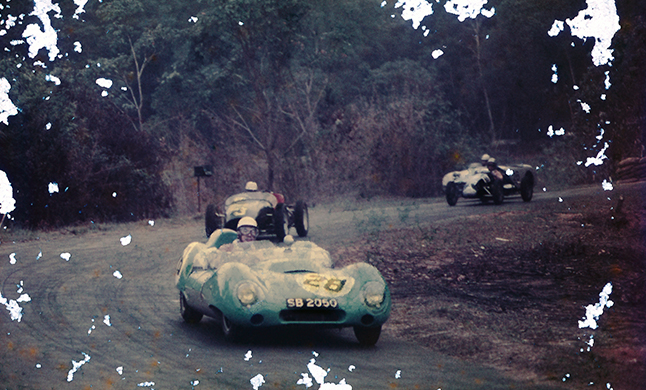
The Ferratus in action at the inaugural Singapore Grand Prix.
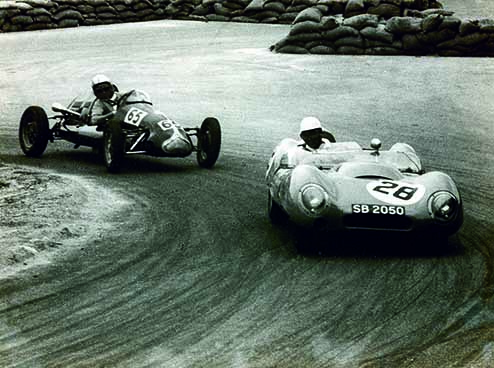
What do you have when you mate a 2-litre Ferrari Mondial engine with an MGA gearbox into a spaceframe Lotus 15? A Ferratus, seen here in front action at the inaugural Singapore Grand Prix, 1961.
The Lotus 15 was meant to be Leong’s solution against Chan Lye Choon’s 1961 Johore Grand Prix winning Lola Mk1 Sports Car. When Leong shoehorned an ex-Macau Grand Prix Ferrari 2-litre engine into the Lotus, only a fool would have bet against it. But plagued with overheating problems, the car coughed, banged, farted and spat its way around the circuit, often without its front bodywork. It was subsequently sold to up-and-coming racer and his good friend, Rodney Seow.
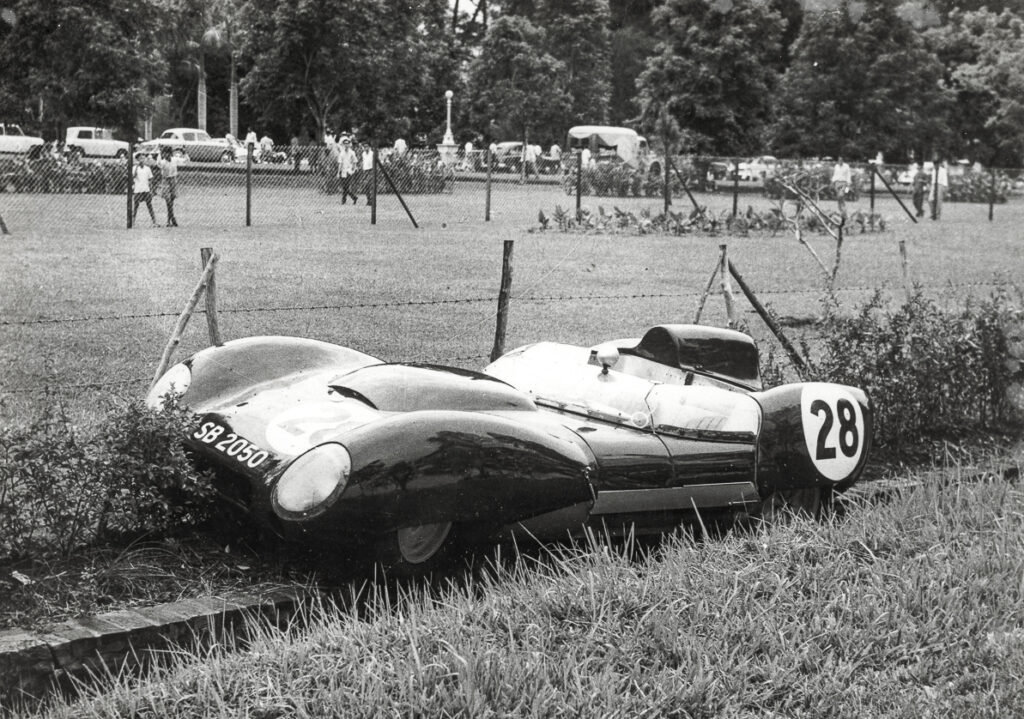
Stanley Leong’s 1958 Lotus 15 carried chassis number 605.
Leong related the meeting with Seow. “One day, Rodney came up to my office just before 9 or 10am and said, ‘Eh Stanley, you want to sell your car?’ I said, ‘Which car? Oh, the Lotus-Ferrari. And you want it?’ I told Rodney, ‘You know the history, right? You know it cannot finish, right?’ ‘Don’t worry,’ he said, ‘I’m an engineer, I know how to do it.’ Ok just shake my hands, sign here ok…Take the car away.” In 1963, the blue Ferratus did no better in Seow’s hands, by which time the Lotus 23 was conquering all before it in Asia.
APPENDIX 3 – NEARLY A WORKS DRIVE
One of the earliest single-seaters to race in South East Asia was the Lotus 20B of Chan Lye Choon. The “low and lithe” Lotus 20 was first unveiled at the Olympia Racing Car Show in January 1961. The 20B carried a larger engine and had disc brakes all round. Chan’s 20B arrived in Singapore in time for the 1962 Grand Prix, fitted with a 1475cc Ford Cosworth 109E engine (as used on Ford’s Capri model) putting out 102bhp with twin Webers. A reputed top speed of 140mph would have made it one of the most competitive cars on the grid for the Johore, Macau and Singapore circuit races that year.

Chan Lye Choon and his Lotus 20B, in the paddock for the 1963 Grand Prix in Singapore.
Chan’s Eastern Auto, agents for Aston Martin and Citroën and various sundries, had secured Lotus distribution for the growing Singapore market and were looking to market the Lotus Seven, Elite and Elan road cars. But that was half the story. Chan’s success at the Changi Circuit Race in 1957, the Macau Grand Prix in 1958 and the sprints/hill climbs in Malaya brought him to the attention of the international racing community. The Lotus agency undoubtedly put him in touch with Colin Chapman and Peter War, Lotus Cars’ joint Managing Directors at the time.
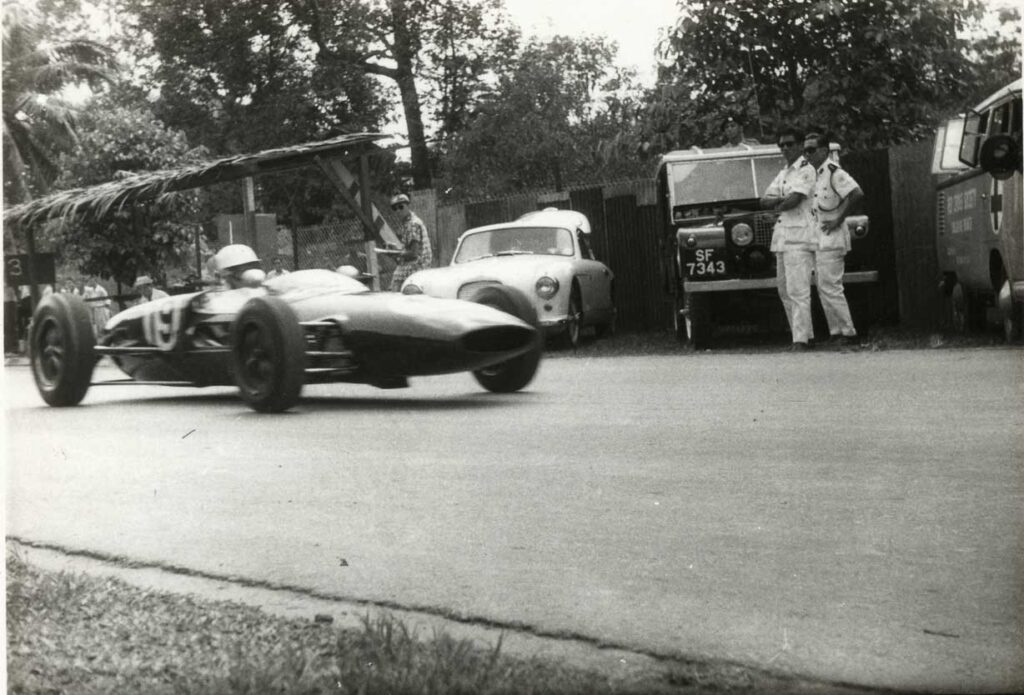
Chan Lye Choon, heading to the starting grid for the 1963 Grand Prix in Singapore.

Chan racing his Lotus 20B at the Diplomatic Enclave in Kuala Lumpur on 25 November 1962. Chan won Kuala Lumpur’s first Grand Prix in 1962. Tracking it provenance following Chan’s ownerships has been an interesting exercise. Mike Cook had it, then Dr Tony Goodwin, then Tony May, possibly American John Green (for Jim Hunter to race?), then Crane Eveland and Jan Bussell. All Chan’s cars have been well-documented on social medial by the local racing experts and his family.
The biggest story on the racing front in Singapore in 1963 was not the upcoming Upper Thomson Road Grand Prix but the First International Japan Grand Prix scheduled for 3-4th May that year. That inaugural Grand Prix, held at the newly opened Suzuka Circuit, had internationally-known Swiss motor racing journalist Gérard “Jabby” Crombac’s fingerprints all over it. Mike Knight (featured in Rewind Magazine 012 as well as MIKE KNIGHT – LUNCH WITH CHAMPIONS), winner of the 1964 Suzuka Grand Prix, explained that Crombac and his father Bill Knight played a big part in that first Suzuka event. “Jabby put together that first race in Japan in 1963. Jabby was also responsible for getting the Magny-Cours circuit in France for Dad. They were very friendly. They were both sort of party boys and Dad had done quite a lot of land speed records in France and got to know Jabby quite well. I believe Jabby was asked to get some cars together from Europe by the JAF,” Mike told me. It was quite an undertaking to get a posse of well-known English names to Japan.
It was an interesting entry list that planned for the trip to Japan. Hill climb champion Arthur Owen was on it and had already raced in Singapore in 1963. Owen was looking into a possible business venture of importing Honda cars and bikes into Britain and so the Japanese trip served his interests. Arsenio ‘Dodgie’ Laurel from the Philippines was the Asian driver on the trip to Japan. But I digress. In Singapore, there was a buzz at the Eastern Auto office at 185 Clemenceau Avenue. Chan Lye Choon was offered the opportunity to be the first Singapore driver to be invited to race a Works Lotus. Chan was also a member of the British Racing Drivers Club (BRDC), on account of his international racing successes.
Lotus Cars of England had entered three works cars for the Japanese Grand Prix – a 1100cc single cam Formula Junior and two 1650cc Twin Cams with 5-speed gearboxes. Warr wrote to Chan inquiring if he would complete in Japan which his Lotus 20B. But it never happened. Chan, for various reasons, turned down the opportunity. The official word was that he felt his Lotus 20B was not eligible. Granted it was at the tail end of Chan’s illustrious career but it was also a time of great upheaval in the automobile trade in Singapore and Chan’s attention was no longer on motor racing but on the family’s Eastern Auto business. Still, he did come close to driving for Lotus.
APPENDIX 4 – SCHOMAC TIME
In 1967, Hong Kong’s Lotus importer Wallace Harper & Company had a new Lotus sports car for its customers. The Lotus Europa and its racing derivative, the 47, looked promising enough to complement Team Harper’s entries in the various classes of racing around Asia. Pilot Steve Holland was the right man for the job of running Bob Harper’s new import – a Lotus 47 with Tecalmet-Jackson fuel injected Twin Cam. This would be in addition to Harper’s other entries for Holland – a Lotus Cortina and Lotus 41 BRM-Ford.
Chassis 47-GT-63’s debut in a major race was at the 1968 Singapore Grand Prix. After a gruelling 182 miles of racing, Australian Garrie Cooper took the chequered flag in his Elfin 600 Twin Cam. In third was Steve Holland in the Team Harper Lotus 47, an amazing result for a sports car. Holland went home with two more trophies – first in class in the Sports & GT race, and third overall in the same, behind Rodney Seow’s Elva Mk7-BMW and Denis Geary’s Lola T70. Holland raced the car again at Batu Tiga for the First Malaysian Grand Prix in 1968, and then at Macau where nine Lotus lined up for the Macau Grand Prix. The 47 occupied the second row of the grid, alongside Max Brunninghausen’s Alfa Romeo TZ2 and behind three single-seaters. The car returned to Singapore for the 1969 Grand Prix. It wasn’t placed but set FTD (and did not finish) in the Sports & GT race. When Holland switched back to single-seaters for Macau at the end of the year, the road-registered 47 was purchased by another well-known Hong Kong man.
Enter Hong Kong businessman Fred Scholle, backer and good mate of racer John Macdonald who said: “In 1968, Fred offered the finance if I prepared the cars. Fred was the real catalyst. Fred supplied the cars and I-we-friends-my biz prepared the cars. From 1969, this became ‘Schomac Racing’, and Macau was Fred’s primary interest.”
First, there were the local Hong Kong sprints to tackle. In September, Macdonald entered the Autumn Slalom at Sek Kong airstrip in the New Territories. The Lotus 47 set FTD. Macdonald raced his Brabham BT10 FVA in Macau at the end of 1969. This gave Schomac Racing a sports car to complement the single-seater entry. Scholle raced the 47 in the Grand Prix, surprising himself with a fine fifth place behind four single-seaters! Macdonald raced the 47 in the Sports & GT race, winning ahead of M. Sanada in a works Group 6 Nissan Fairlady.
Back in Hong Kong, the first round of the local club’s hill climb season was at Golden Hill in early January 1970. In Macdonald’s hands, the Brabham set the hill climb record while the Lotus 47 won its class. Later in January, at the Wong Nai Chung Hill Climb, Macdonald bettered his record in the Brabham while the Lotus 47 won its class once more. In February at the same venue, the Lotus 47 set FTD! In June at the Sek Kong airstrip Spring Slalom, the Brabham set FTD while the Lotus won its class, yet again. This routine was repeated at the Summer Slalom at Sek Kong the next day.
In the Sports and GT race in the 1970 Singapore Grand Prix, Macdonald set FTD and won the race in the Lotus 47. The following week at the Selangor Grand Prix Sports Car race, the Lotus 47 led for the first 23 laps (of 30) before being caught by the eventual winner, Hengkie Iriawin in an Elfin 300B Sports Car. A bent valve in the twin cam was blamed for the drop in performance. The 47 was in action in Selangor in September 1970 for the Malaysian Grand Prix Sports Car race. Macdonald had a BMW 2002 Alpina for the Saloon Car race where he finished third. A loose spark plug caused the 47’s twin cam to overheat and eventually blow a head gasket in the Sports Car race while it was running second.
Both the Brabham BT10 and the Lotus 47 were offered for sale in September 1970 in an advertisement in the Singapore Motor Sports Club’s magazine. “By switching engines, these two cars make a perfect team for next year’s formula, with the twin cam putting out between 175-180 BHP. Many spares included for both cars,” said the owners. The price for the “Lotus 47 Twin Cam Hybrid FT200” was an expensive S$18,000. A few surmised that Scholle had tried to get out of racing as he had spent a lot of money for very little return.
In Macau in November 1970, Scholle entered the 47 in the Grand Prix while Macdonald had it for the Sports Cars race. Scholle impressed when he qualified the car on the second row, alongside Malcolm Ramsay in an Elfin 600. Macdonald started on Pole for the support race. With an engine that went off-song, the 47 was passed by Henry Lee in the ex-Richard Wong Porsche 906 on lap 12 and finished a distant second to the Porsche.
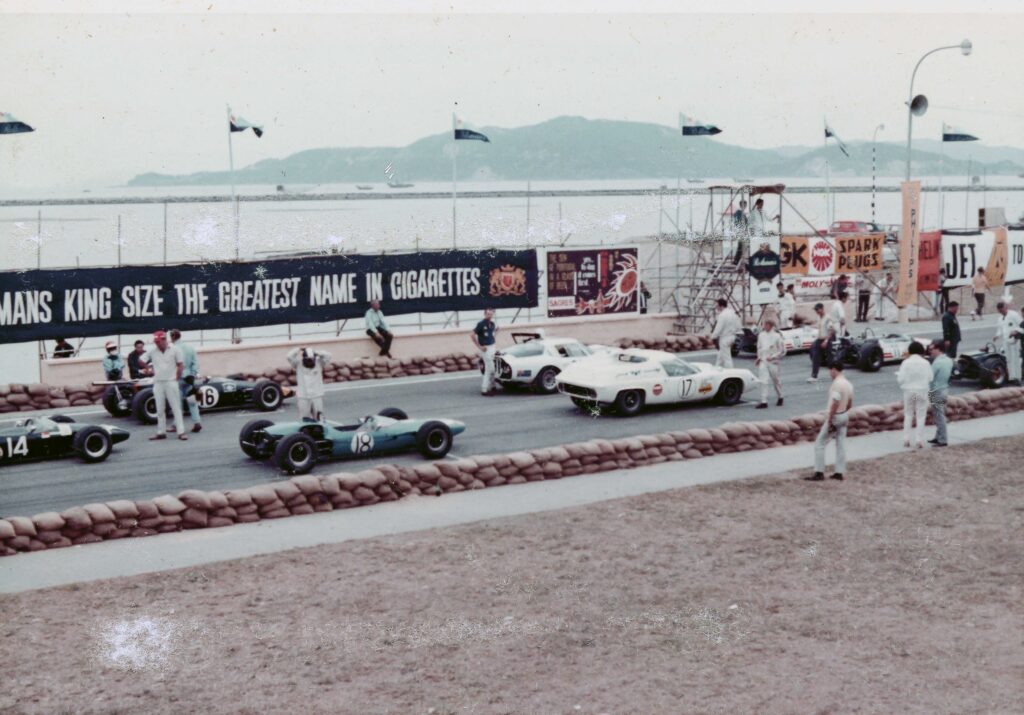
Steve Holland and his Lotus (No.17) occupied second row of the 1968 Macau GP grid alongside Max Brunninghausen’s Alfa Romeo TZ2.
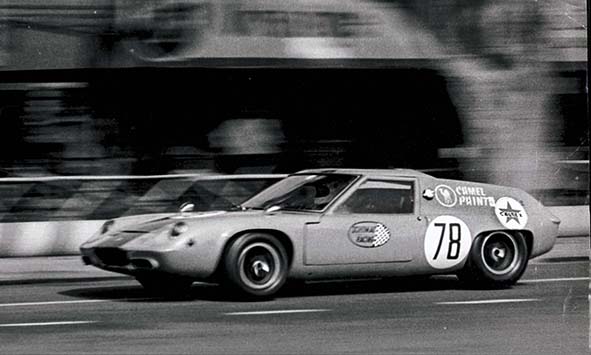
Schomac Racing entered the Lotus 47 for the Macau Grand Prix as well as for the support Sports & GT races in 1970 and 1971.
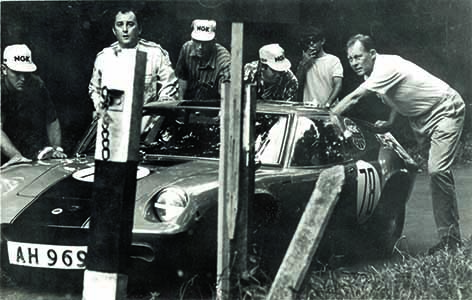
The Lotus 47 makes it first appearance for Schomac Racing in the 1970 Singapore Grand Prix.
To suit the new race regulations for 1971, Macdonald removed his fuel injected Cosworth FVA motor from his Brabham BT10 in the winter of 1970 and replaced it with a Lucas fuel injected Vegantune Twin Cam. The FVA was dropped into the Lotus 47. With its strong Hewland FT200 transmission, it created an even more potent GT racer for the 1971 race season. The 47 made an appearance at the 1971 Singapore Grand Prix support race. A picture of the car on the front page of the Eastern Sun showed Macdonald standing beside the car. In the background, a marshal was using a fire extinguisher on the smoking Lotus 47. The car had caught fire on lap 8 of the Sports & GT race. Recalled Angus Lamont, race crew for Macdonald’s cars, “The car had a terrible reputation for catching fire!” Said Macdonald, “The car was either a race winner, or it was on fire.” During Schomac’s ownership, the car caught fire at least three times!
In October 1971, after the damage from the April fire was repaired, David Ma, President of the Hong Kong Motor Sports Club, bought the car and entered it in Macau that November. Tragically, he was killed in an accident during final practice when he was braking into Statute Corner. The car was totally destroyed and the remains were dumped at sea during the return crossing by lighter from Macau to Hong Kong.
APPENDIX 5 – HUNT’S 59
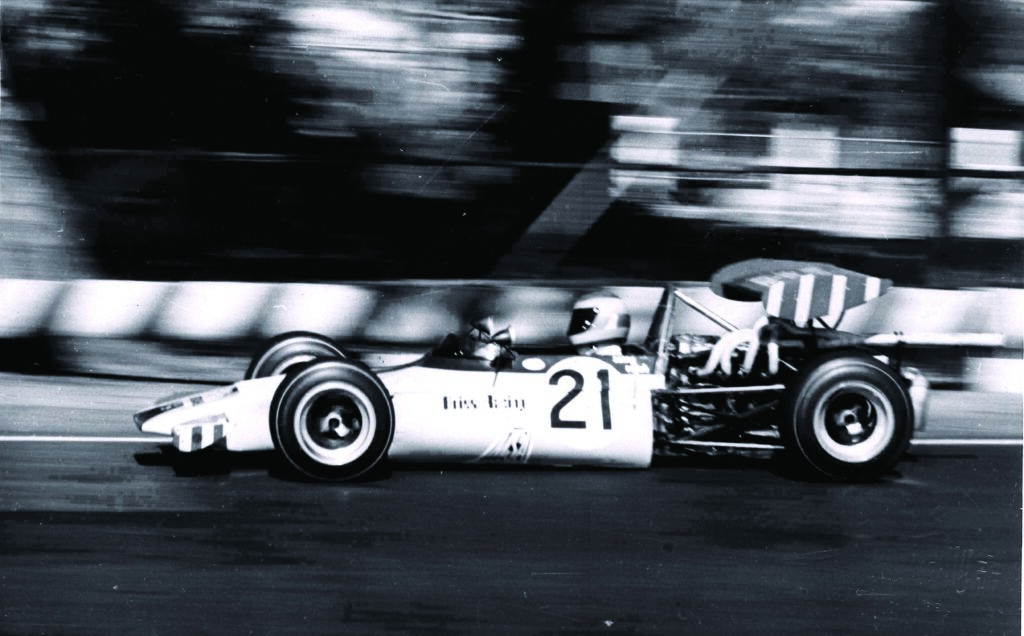
Sonny Rajah’s long hair and Emiliano Zapata moustache epitomised the suave look of the period. As Malaysia and Singapore’s top single-seater racer, the press loved him. His easy-going manner belied the true nature of this very gifted driver with a real zest for the sport. The local hero shot to prominence when he won the Preliminary heat of the 1971 Penang Grand Prix in his newly-acquired Lotus 69. He followed that up by leading the 1971 Macau Grand Prix, only to crash on the last lap while in a commanding lead. His first big win came in April 1972 when he won the Malaysian Grand Prix in a March.
Kiwi racing legend Graeme Lawrence (Rewind Magazine issue 011) predicted that Sonny “will be exciting to watch.” When John Macdonald once followed Sonny for the first few laps around the streets of Macau, he observed that Sonny “made contact with much of Macau’s scenery [that] in itself is a very difficult act.” He added that Sonny “had brilliant car control” and was a “natural talent with character to boot”.
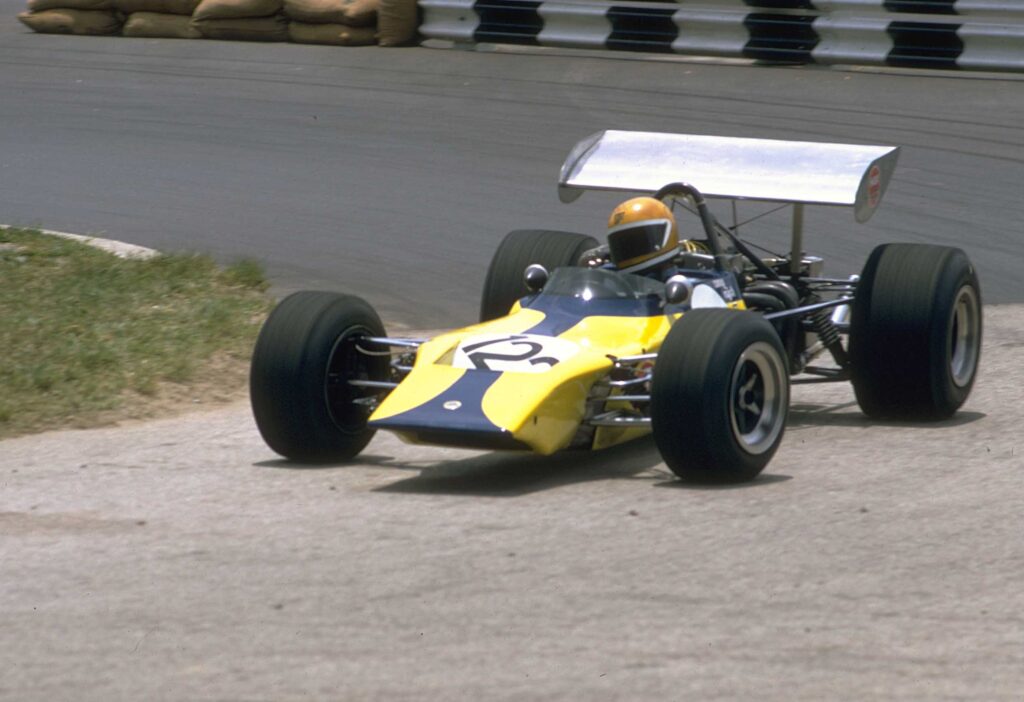
Sonny Rajah in his yellow Aries Racing Lotus, 1971 Singapore Grand Prix.
Sonny’s single-seater debut was in the 1971 Singapore Grand Prix. His Lotus 59 was said to have been hard-driving future world champion James Hunt’s mount in the European Formula 3 championships the previous year. Sonny purchased the Lotus from Hunt’s Motor Racing Enterprises race team as a rolling chassis. Recounted Sonny, “We started a team called Aries Racing because we started in March. We were going to take this SGD20,000 venture and become the driving force of motor sport in the region.” Of the four friends involved in Sonny’s adventure, only he had the most basic understanding of gear ratios, tyre compounds and car set-up. The Lotus arrived in Singapore with a second-hand Brian Hart Twin Cam engine and a set of wet weather tyres. It was “all we could afford,” he said. Hunt’s red Lotus was repainted yellow as “nobody had yellow cars in those days.”
The car was trailered to Batu Tiga for testing as Sonny had never driven a single-seater prior to acquiring the Lotus. “Four of us at Batu Tiga, and I break the lap record. So I thought this was great stuff,” he related. They may have harboured high hopes for the season but Sonny had a battle on his hands. His family, who were “jumping up and down” entirely against his racing, would not fund him. He also faced formidable competition from established international racers, some of whom went out of their way to intimidate the young upstart Singaporean.
By the Penang Circuit Race two weekends later, circumstances had changed. The young lad set pole position after winning the short preliminary race that weekend. Keen to find out what gear ratios Sonny was running around the tight Esplanade street circuit, Kiwis Ken Smith and his race engineer, the very experienced Roly Levis (who himself raced in Singapore and Selangor in 1969 – and set FTD in his Brabham BT23C), approached Sonny. It was a fortuitous meeting of Lotus owners. They struck up a friendship and Ken and Roly gave Sonny a crash course in changing gearbox ratios. Sonny would soon be adopted as the local hero everyone in Malaysia and Singapore desired. His trademark red helmet with white polka dots would shortly make its appearance.
CONCLUSION
And that concludes this short introduction to Lotus racing in South East Asia. Hope you’ve found it interesting. Do drop a comment; share the post; rip it apart, if you must…;anything that helps improve the product and keep me interested in continuing this research. This is the work of an amateur enthusiast. Nearly all the Lotus cars that raced in the region are featured (though I lack images of the Chong Boon Seng Lotus 41) and I am positive there are wide enough gaps and errors in this research to run the QEII through. I have tried my best to mention all the cars, or at least include photos of them in action and continue to add to this article, as and when time permits. If you intend to reuse the images or lift the content, be kind enough to mention where you found it. If you would like to reuse this article in another publication, please contact me.
With thanks to an enormous number of supporters, friends and specialists, many of whom are no longer with us. Special mention to the following (not in any particular order): John Macdonald, Angus Lamont, Michael Jackson, Sir Michael Kadoorie, Neville McKay, Brian Eastman, Mike Knight, S.K. Quek, Rodney Seow, Stanley Leong, Stanley Iriawan, Dr Philip Newsome, Anne Wong, Shane Lim, Ian Boughton, Brett Boughton, Tony Maw, Tony Goodwin, Loh Yap Ting, Albert Poon, L.C. Kwan, Jim Hunter, Ian Lee, Graham Clack, Richard Wong, David Wong, Dickie Arblaster, Larry Lim, Peng Tsu Ying, Saw Kim Thiat, Terry Pearce…

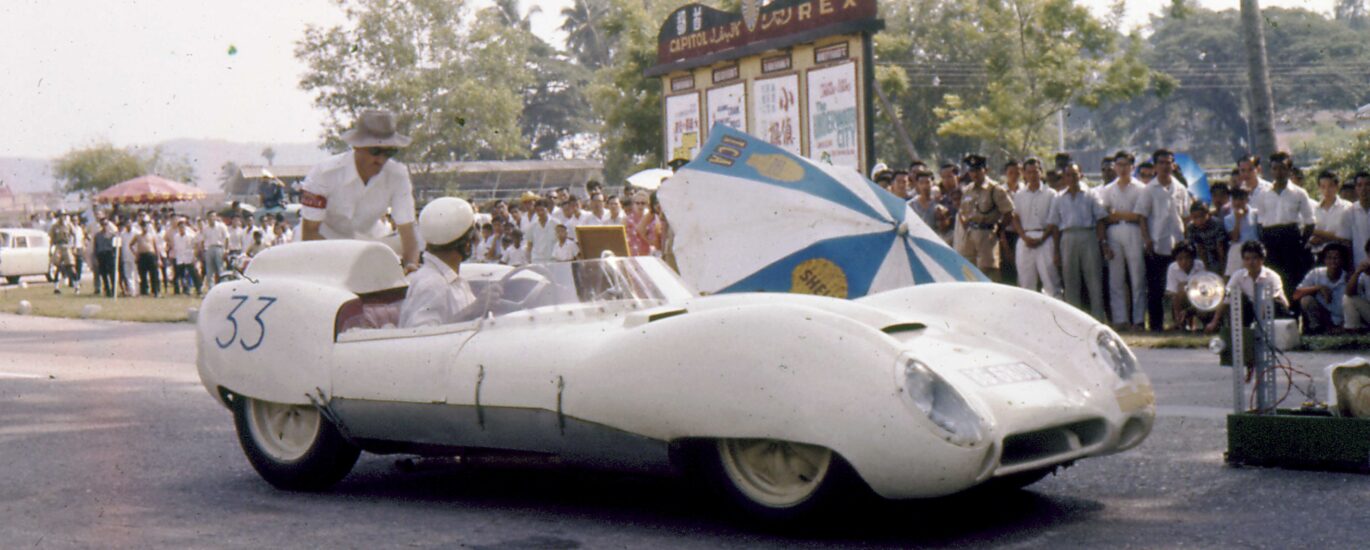
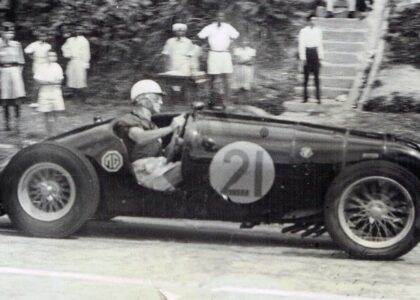
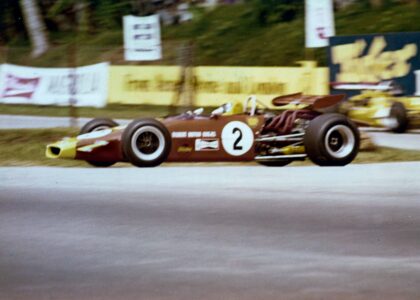
Though there were not many big events during the period, there was a Lotus Seven still being campaigned in Singapore motor sports from 1978 to 1995.
It won the annual Eric Cooper Memorial Trophy for Classic and Sports Cars four times and was one of the vehicles that contributed a significant number of points to help its owner clinch the Singapore Motor Sports Association’s Clubmens Championship in 1992.
I remember that red Lotus in action at SMSA events in Singapore. There was a modsports Elan that was raced at Pasir Gudang in the 1990s as well, by Kerry Anderson from Hong Kong. And, if memory serves, an Australian entered Elan in the Super Saloon series in Shah Alam iin 1984 (Trevor Hine in his Lotus Elan BDG).
Hi any info on the Lotus 41 which Jim Hunter drove
Any info regarding the Lotus 41 Jim Hunter drove his name mentioned a few time in the above article like to know more on the car owners and other drivers etc as we are current owner , and any info on car before in came to Australia.